
Title: Peter Parley's Wonders of the Earth, Sea, and Sky
Author: Samuel G. Goodrich
Release date: August 20, 2020 [eBook #62982]
Most recently updated: October 18, 2024
Language: English
Credits: Produced by Charlene Taylor, Tom Cosmas and the Online
Distributed Proofreading Team at https://www.pgdp.net (This
file was produced from images generously made available
by The Internet Archive/Canadian Libraries)

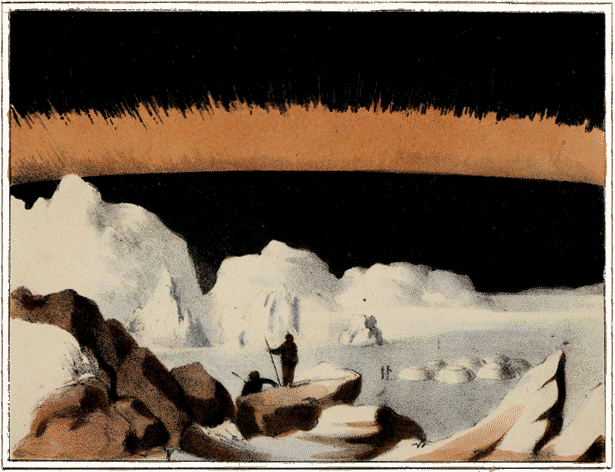
AURORA BOREALIS
PETER PARLEY'S WONDERS
OF THE
EARTH, SEA, AND SKY.

EDITED BY THE REV. T. WILSON.

A New Edition,
WITH ADDITIONS AND IMPROVEMENTS.
LONDON:
DARTON AND CLARK, HOLBORN HILL.
Entered at Stationers' Hall.
TO
GEORGE BIRKBECK, Esq. M.D., F.G.S.,
PRESIDENT OF THE LONDON MECHANICS' INSTITUTION,
AS A TRIBUTE OF RESPECT
FOR
HIS BENEVOLENT AND EFFECTUAL ENDEAVOURS TO PROMOTE THE
DIFFUSION OF KNOWLEDGE,
This Little Work
IS,
WITH PERMISSION, DEDICATED
BY THE EDITOR.
It seems to me that there is something very unreasonable in the plan of a great many of the books intended to introduce young people to the various branches of Natural History, which have been recently published. The chief aim of their authors seems to have been to combine brevity with comprehensiveness. Brevity is, without doubt, a great advantage, inasmuch as the proverb is true, that a great book is a great evil; but in my opinion comprehensiveness ought not to be attempted in books intended for children. If it were desirable, I might indeed confidently say, that it can never be obtained within the necessary limits; and the attempt to effect it, will very often reduce the work to a mere dry table of classification. However neat and systematic tables of genera and species, and lists of names may look, they can never convey to the young the elements of sound scientific method; and will seldom fail in « vi » being useless or disgusting to the mind, at an age when it is seeking for that sort of knowledge which will exercise the understanding, without burdening the memory. This healthy appetite ought to be carefully cultivated; and I am satisfied that if it were so, from the earliest stage of education, we should have but few complaints of bad memories. The memory is apt to vanish from those who would make an idol of it; and I am disposed to think that its cultivation may very safely be omitted, as a direct object of education, if due care is taken to keep the understanding active, and to present the matter on which it is to be engaged in the most entertaining form possible. In fact, what is often termed "a good memory," that is, a ready recollection independent of the connections which are made solely by the understanding, is, as we may see by its fruits in many persons of feeble intellect, by no means desirable. An apt example of such a memory is afforded, in what Dame Quickly says to Sir John Falstaff, when she reminds him of a mixed multitude of unimportant circumstances, with no other principle of arrangement or connection, than what was supplied by proximity of time and place.
I would not, however, willingly be supposed to recommend books, in which systematic arrangement, or the most scrupulous regard to accurate statement, is overlooked. I had particularly in view that numerous class of little books, which under various names come out in series, each volume professing in a manner to comprise the whole of the branch of Natural History which may be the subject of it, by its containing a mere arrangement of the names of the phenomena which the branch includes. There is another and widely different class of books, in which stories from travellers and other idle gossip of the like kind, are compiled in an undigested mass, without regard to the different names by which the same thing may be called, and not unfrequently to a common respect for truth, which is not much less to be deprecated.
And yet to books of this latter description, often of a very unworthy character, it is that many of us owe the first calling into consciousness of that taste which may have made us travellers or naturalists, or lovers of knowledge. I wish that, without copying the example of their authors, we should learn a lesson from them, « viii » and put it in practice, by striving to form a taste to enjoy knowledge in them we have to teach, before we attempt any mode of systematic instruction.
The following little book has been written under the impressions which I have here stated. I have selected a few of such phenomena of the Kingdoms of Nature, as seemed to me to have in them most to excite wonder and admiration; and I have sought to convey distinct notions with the least possible use of technical language; neither forgetting the connection of things, nor overloading the statements with matters that are merely expletive of an arbitrary system. How far I may have succeeded, is for my little friends, and their instructors, who have approved of my other books, to decide. Wishing the former as much pleasure in the reading, as I have had, for their sakes, in the writing, I take my leave of them.
P. P.
PART I.—WONDERS OF THE EARTH.
| Page | |||
| Chap. | I. | Parley explains how the Strata of the Earth are placed. | 1 |
| Chap. | II. | What creatures once lived where Dorsetshire now is. | 5 |
| The Icthyosaurus. | 6 | ||
| The Plesiosaurus. | 14 | ||
| The Pterodactyle, &c. | 17 | ||
| Chap. | III. | What sort of a place once existed where the neighbourhood of Paris is now, and the animals that lived there. | 21 |
| The Palæotherium. | 22 | ||
| The Anoplotherium, &c. | 25 | ||
| The Dinotherium. | 26 | ||
| Chap. | IV. | Of Great Caverns in England and Germany, filled with bones of wild animals« x » | 30 |
| Dr. Buckland's account of the great cave of Gaylenreuth | 31 | ||
| Chap. | V. | Of other animals that once lived in England and elsewhere | |
| The Elephant | 34 | ||
| The Gigantic Elk | 38 | ||
| The Megatherium | 39 | ||
| The Beaver | 41 | ||
| The Dodo | 42 | ||
| Chap. | VI. | Parley describes Volcanoes, Earthquakes, and Hot Springs | 47 |
| Earthquake of Calabria | 49 | ||
| Volcanoes | 61 | ||
| The way in which an Eruption takes place | 63 | ||
| Lava Streams | 65 | ||
| Great Lava Streams from Skapta Jokul, in Iceland | 69 | ||
| Alluvions | 70 | ||
| The Great Volcano Kirauea, in the island of Hawaii | 71 | ||
| Of the formation of new islands | 76 | ||
| Parley describes his visit to the Geysers of Iceland | 78 | ||
| The Sulphur Mountains and Sulphur Springs | 87 | ||
| How the Geysers may be caused | 89 | ||
| Chap. | VII. | Of the Rocks called Basaltic« xi » | 92 |
| Parley's visit to Staffa | 93 | ||
| The Giant's Causeway | 101 | ||
| Chap. | VIII. | Why Parley believes that there is a great source of heat within the globe | 103 |
| Chap. | IX. | Parley tells something about the history of Mount Vesuvius | 111 |
| The Grotto del Cano | 112 | ||
| Of the death of Pliny, the Naturalist | 115 | ||
| Herculaneum and Pompeii | 124 | ||
| Chap. | X. | Parley describes the Falls of Niagara | 135 |
PART II.—WONDERS OF THE SEA.
| Chap. | I. | Parley tells about the Frozen Ocean | 144 |
| Icebergs | 146 | ||
| Parley's dangerous situation on an Iceberg | 150 | ||
| Chap. | II. | The story of a long journey over the ice with some Esquimaux | 152 |
| Chap. | III. | The journey over the ice, continued | 167 |
| Chap. | IV. | The Whale« xii » | 178 |
| The mode of catching Whales | 183 | ||
| Character of the Whale | 187 | ||
| Chap. | V. | A voyage on a Tropical Sea | 190 |
| Trade Winds and Monsoons | 191 | ||
| Chap. | VI. | The Waterspout | 194 |
| How Parley supposes Waterspouts to be caused | 199 | ||
| Chap. | VII. | Coral Reefs and Islands | 203 |
| Various kinds of Coral | 204 | ||
| The Coral-Making Polypes | 206 | ||
| Forms of the Coral Reefs | 211 | ||
| Parley's first sight of one | 213 | ||
| Chap. | VIII. | Luminous appearance of the sea | 221 |
| Animals by which it is occasioned, and the Acalepha in particular | 223 | ||
| Chap. | IX. | The Cuttle Fish | 231 |
| The Octopus | 235 | ||
| Chap. | X. | The Paper Nautilus, or Argonaut | 239 |
| How Parley saw one sailing on the sea | 241 | ||
| The Pearly Nautilus | 245 | ||
| The Nautilus Spirula | 248 |
PART III.—WONDERS OF THE SKY.
| Chap. | I. | The Colour of the Sky | 250 |
| Chap. | II. | The Aurora Borealis | 254 |
| Chap. | III. | Parley tells of some other Meteors | |
| Parhelia or Mock Suns | 263 | ||
| Ignes Fatui | 264 | ||
| Experiment to show the cause | 266 | ||
| Chap. | IV. | Shooting Stars | 267 |
| What they are | 269 | ||
| Chap. | V. | Meteoric Stones, or Aerolites | 273 |
| How they are caused | 277 | ||
| Chap. | VI. | Bloody Rain | 280 |
| Red Snow | 281 | ||
| Showers of Frogs and Fish | 282 | ||
| Chap. | VII. | The Spectre of the Brocken | 285 |
| Chap. | VIII. | Some other instances of Aerial Reflection | |
| Souter Fell | 291 | ||
| What a Friend of Parley's saw | 293 | ||
| Dover Castle | 293 | ||
| What Humboldt saw« xiv » | 294 | ||
| What Captain Scoresby saw | 295 | ||
| Apparent distance of Object | 296 | ||
| Chap. | IX. | Fata Morgana | 299 |
| The Mirage | 299 | ||
| Chap. | X. | How Parley supposes these appearances to be produced | 303 |
| Refraction | 305 | ||
| Reflection | 311 |
| Conclusion. | |||
| Of some other Wonders, &c. | |||
| Section | I. | How we ought to think upon what we know | 314 |
| II. | Ever Part of the Earth a Home for something | 316 | |
| III. | Birds of Passage, Dormice, and Snails | 318 | |
| IV. | The Rein-deer—the Camel | 322 | |
| V. | Benefit of the difference of Climate | 324 | |
| VI. | The same Organs in different Animals developed in various modes and degrees—the Acalepha, Actinia, and Sepia | 326 | |
| VII. | How the Stars and we are connected together—Gravitation—Aerolites | 330 | |
| VIII. | Dew | 332 | |
| IX. | How every thing is endowed with a tendency to preserve its own life, and the existence of its race | 334 | |
| X. | The Bud of the Poppy—long retention of life by seeds and roots | 336 | |
| XI. | Of Seeds which are furnished with wings or sails | 339 | |
| XII. | Conclusion of the conclusion | 340 | |
| PLATE | Page | |
| I. | EXTINCT ANIMALS THAT ONCE LIVED WHERE DORSETSHIRE NOW IS | 5 |
| II. | EXTINCT ANIMALS THAT ONCE LIVED WHERE PARIS NOW IS | 21 |
| III. | GREAT BONE CAVERN OF GAYLENREUTH | 30 |
| IV. | GIGANTIC ELK AND MEGATHERIUM | 38 |
| V. | VESUVIUS, WITH THE PINE-TREE CLOUD | 64 |
| VI. | VESUVIUS IN ERUPTION AT NIGHT | 66 |
| VII. | THE GEYSERS OF ICELAND | 78 |
| VIII. | ISLAND OF STAFFA | 93 |
| IX. | FINGAL'S CAVE | 97 |
| X. | FORUM OF POMPEII | 131 |
| XI. | GREAT FALL OF NIAGARA« xvi » | 135 |
| XII. | ESCAPE ON THE ICE | 157 |
| XIII. | THE WATER-SPOUT | 194 |
| XIV. | ACTINIÆ—CORAL BUILDERS | 206 |
| XV. | SEPIAS | 231 |
| XVI. | NAUTILUS | 239 |
| XVII. | AURORA BOREALIS (FRONTISPIECE.) | |
| XVIII. | SPECTRE OF THE BROCKEN | 285 |
| XIX. | DOVER CASTLE | 293 |
| XX. | FATA MORGANA | 299 |
WONDERS OF THE EARTH.
PARLEY EXPLAINS HOW THE STRATA OF THE EARTH ARE PLACED.
I am now going to tell you, my young friends, about some of the wonderful things in the earth, sea, and sky. A great number of them I have seen myself in my travels through various countries, and others I have only read of; but I shall tell you nothing that is not strictly true, for I do not wish so much to astonish you as to make you « 2 » take pleasure in contemplating the works of God, and to increase your knowledge of His goodness, wisdom, and power.
I shall begin with some of the wonders of the earth which, as I suppose you know, belong to the branch of natural history which is called geology; and to enable you to understand what follows, I must first explain how the materials which compose the ground you tread upon are arranged.
If you hastily travel over any extensive tract of country, such as that between New York and Philadelphia, or between London and Bristol, you might think that all the different substances, clay, chalk, limestone, and granite, were irregularly mixed together. This is, however, not the case, when taken on a great scale; for if you more carefully examine, you will find that the various sorts of earth are disposed in layers, or strata, and that a uniform order of arrangement is nearly preserved.
If these layers were perfectly horizontal, laid one over another like the coats of an onion, we « 3 » should have to dig through one before we could get to the second, and our knowledge of what the globe consists, would be much more limited than it is; for the greatest depth to which men have descended in the deepest mines, is not much greater than the thickness of one of the strata.
But, instead of this, the surface is broken up by some force from beneath elevating portions, so as to form mountains and hills; and in consequence of this the edges of the strata appear on the surface one after another; just as you would see the edges of a row of bricks that had been set up on their ends, and then the last one thrown down so as to push down all the others.

This is the way in which the strata are placed in the neighbourhood of Weymouth.

The chief reason why I wished you to understand this is, that you may see how it is known that one stratum is older than another. It is evident that the substance marked a, in the section, which is limestone, must have been deposited before b, while b must certainly be older than c.
Now in most of the strata above the granite, which is nearly always in the position of the oldest formation, there are found various shells, plants, and bones of animals; and where certain remains of different animals or vegetables are found in one stratum, it is concluded that they must have been living about the same time.
Most of the animals of the older strata were different in form from any at present known to exist; and some of them are very remarkable, and if they were alive now, would seem to us very strange and awkward.
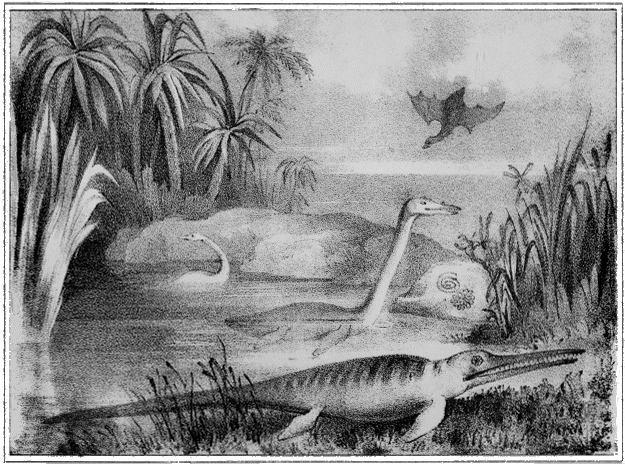
EXTINCT ANIMALS.
WHAT CREATURES ONCE LIVED WHERE DORSETSHIRE NOW IS.
I will show you a picture of what creatures were once living where the town of Lyme Regis, in Dorsetshire, now stands, and tell you something about their structure and their habits. You may perhaps be ready to think that a great deal of what we profess to know concerning them, is the work of fancy, but I can assure you it is not, and by and by I will endeavour to convince you that there is reason enough for you to believe what I tell you.
THE ICHTHYOSAURUS.
That large animal lying on the ground, is called the Icthyosaurus, from two Greek words signifying Fish-Lizard, in consequence of his possessing some of the peculiarities of both fishes and lizards.
The usual length of this creature was from twenty to thirty feet. It possessed a most surprising combination of the powers and qualities of different animals which are now in existence. In its general form and character it must have been something like the modern porpoise; but it had the teeth of a crocodile, the head of a lizard, the back-bone of a fish, and the fins or paddles, of a whale.
I shall spend some little time in explaining to you each of these particulars, that you may see how wisely all the parts of living things are framed to supply their wants, and adapt them to the circumstances in which they are placed.
The head was not very different from that of a crocodile, or lizard, in its general shape. The teeth were precisely like those of a crocodile, and grew up in the same manner. Creatures of this sort lead a ruffian sort of life, always biting something or other, and as they live very much in the dark at the bottom of the water, perhaps now and then snap at a stone or a piece of hard wood by mistake, and often break their teeth; and in order therefore to keep them in constant repair, they have a fresh set once a year, or at very short intervals, so that they are always growing. The young tooth a, springs up inside the old one b, till it becomes so large that it splits its predecessor, and the pieces fall off, just as the covering of some sorts of buds falls off as the flower expands, as you will see in this cut, representing one of the fossil teeth.

You must have noticed in the picture the great length of his snout. In a jaw-bone of « 8 » such amazing length which was to be applied to such violent purposes, it was necessary there should be great strength. There were two ways of obtaining this: one would have been by having the bones very hard and stout; but this would not do, because they would then have been so heavy that the animal would have found difficulty in raising his head to the surface of the water for the purpose of breathing, since it would have overbalanced the other part of his body. The other contrivance, which was the one adopted by the wisdom of the Creator, was to make the jaws consist of several thin bones, a, b, c, d, strongly bound together, and terminating in succession like the plates of steel of which a carriage spring is made. There are accordingly six of these bones thus disposed.

But this was not all, the principal middle bone marked b, instead of having its fibres run straight, parallel with the others, had them placed in a slanting position, and thus there was additional firmness given to the jaw by what ship-builders would call diagonal bracing, a contrivance that you may often see used in the construction of houses and ships.
If you have ever seen a crocodile open its mouth, and then snap together its long thin jaws, so as to make you start with the noise, you will see how necessary all these contrivances must be for him and the Icthyosaurus, whose jaws were still thinner, to prevent them from breaking their bones.
This however is not at all more wonderful than the eye, which in the old-fashioned animal I have been describing, was much larger than that of the crocodile, and not unfrequently bigger than a man's head. From the very great quantity of light which such a large surface would receive, the creature's power of seeing « 10 » must have been very great. And besides this advantage, it had the same faculty as is possessed by the golden eagle, the turtle, the tortoise, and the lizard, of pressing the eye forward to render it more convex. In man and most animals, the eye is placed in a fixed cavity of thin bone, something like an egg-cup, but in the Icthyosaurus, the cavity was formed by several bones not quite touching each other; (as you may see in the last cut, and in figure 2, you have two of the bones by themselves, taken out of the socket of the eye;) and there were muscles to draw these bones closer together; so that by making the cup less deep, the eye was thrust forward and made to swell out in the middle. This is illustrated in the ball b, which is pressed outwards, by drawing the plates of bone cc, together at o, close than those which have the ball a between them.

You must have seen that the more convex magnifying glasses are, the more they magnify, and the nearer you must hold them to the object you are looking at. By this contrivance, the eye of the Icthyosaurus could be made at pleasure into a microscope, so as to see with wonderful quickness things which were quite close to it, by pushing it forward and rendering it more convex; or it could be made into a telescope like the eyes of some persons who are long-sighted, for seeing what is at a greater distance, by drawing it back.
In all these particulars you may see how the skill of man leads him to adopt the same plans to produce the same ends in the works of art, as God has adopted before him in the works of nature, without his being conscious of copying them; and this should remind you that man was created in the image of his Maker. If man had never made a carriage-spring, or a diagonal bracing, he would not have understood the structure of the jaw of the Icthyosaurus; and if he had never « 12 » invented the telescope, he would not have been able to explain the construction of the eye.
You have now seen the points in which the Icthyo-saurus chiefly resembled a crocodile or lizard; from which the latter half of its name is derived, saurus, a lizard. I must now tell you something of those parts in which it is like a fish, from which it takes the other part of its name, icthy, for icthus, a fish.
You know that crocodiles live a good part of their time on land, and they therefore have feet and a back-bone like land animals, which enable them to walk better, but do not allow them to swim so well as fish. The back-bone is heavy and firm, and each of the bones composing it has one side slightly hollow, and the other side swelling out to fit into the hollow in the one that comes next to it. But in fish both sides of the bones are hollow, and they are joined together by gristle, as you can easily see in the fish that are commonly eaten; this renders the back-bone much more flexible and lighter, and therefore « 13 » better adapted for an animal always swimming. That of the Icthyosaurus was formed in the same manner, and we therefore judge that he spent his whole life in the water; for a back-bone so formed, would not have been able to support such a great heavy body when walking on the land.
The fins, or paddles, were very curious, and much like those of the whale; they consisted of above a hundred small bones strongly united together, in a sort of pavement enclosed in a strong skin, and not divided into toes, as you may observe in this representation of the entire skeleton.

You may see many specimens of the skeleton itself in the British Museum.
The Icthyosaurus was a great tyrant, and used to prey on every creature that came within his reach; this is known by the fossil remains found in the inside of his body. He used at times even to act the cannibal, and eat his own relations, for a large one has been dug out of the cliff at Lyme Regis, with part of a small one in his stomach undigested; he must have been altogether a very unamiable character. But as his family has been so long extinct, and we are told that we ought to say nothing but what is good concerning the dead, I shall not say any more about him, leaving you to form your own conclusions from what I have related to you.
THE PLESIOSAURUS.
Those still more strange looking animals with very long necks, which are represented swimming in the water, have been named Plesiosauri, a word signifying, related to, or closely resembling, a lizard. There are some nearly perfect « 15 » specimens in the British Museum, and this is a representation made up by taking the uninjured parts of several, so as to make up a perfect whole.

Taking it altogether, there is not one of the fossil animals so much unlike anything at present known to exist. Its usual length was from 9 to 15 feet, but it was at times very much larger.
The head was much shorter in proportion than that of the Icthyosaurus, being more like that of the guana, the lizard which people eat in the West Indies. The neck must have been longer than that of any living animal, not even excepting the swan; it contained thirty-three bones, or vertebræ, while the whole of the rest of the back-bone in the body and tail, contained only fifty-seven.
The faces of these vertebræ were nearly flat, and not hollow like those of the Icthyosaurus, which would better enable the animal to exist on land, and it appears to have moved about in the same manner as seals do. From some very ingenious observations on certain parts of its anatomy, (which if I were to endeavour to explain to you, you would not understand, unless you possessed a great deal of anatomical knowledge,) naturalists have supposed that it used to change the colour of its skin like the chameleon. Its paddles were almost exactly like those of the turtle, and its body was something of the same shape, but not quite so wide.
From its long neck, which, although it was strengthened by the solid joints and peculiar shapes of the bones, was not very strong, and its small head and jaws, the Plesiosaurus could not have been near a match for its neighbour, the Icthyosaurus, in combat, even when the individuals were of the same size; neither would its form adapt it for cutting through the water so « 17 » quickly. It must, therefore, no doubt, have often fallen a prey to that voracious monster. Perhaps, however, it often played him a trick when he was pursuing it by running on shore out of his reach; or it might mostly have kept out of his way in very shallow water amongst the rushes and reeds, where it could every now and then dart its long neck like a swan, down at the little fish that came near it; or else suddenly reaching aloft into the air, it may have seized upon some unlucky insect, or Pterodactyle, (a sort of bat of which I shall presently speak) and then laid down as quiet under the rushes as if nothing had happened, waiting for its next mouthful.
THE PTERODACTYLE.
That odd-looking creature which is flying in the air over the heads of the Plesiosauri, has been called the Pterodactyle, which signifies « 18 » wing-fingered. There were several varieties, of different sizes and figures, from that of a snipe to that of a raven. The most remarkable of them was indeed a curious creature, and so you will say if you look at the picture of his skeleton.

He was more like a bat in his general shape and habits, than anything else we know of, but was very different in a great many respects.
He had a head like a lizard, with a long snout and sharp teeth; his ribs were round and thread-like, not flat like those of birds and bats; his eyes were large; and his wings like a bat's, being a membrane or skin, stretched out by one very long toe on each of his fore-feet. In order to support his long head, there were strong cords « 19 » running down each side of the vertebræ of his neck, such as are found in some modern birds, as is known by the forms of the bones to which the ends of them were attached. His toes ended in sharp claws, and he had also claws at his two principal joints, so that he could catch hold of the branches of trees with them, as bats do. These creatures used principally to feed upon large dragon flies, beetles, and the other insects, of which the remains are found, and some of which are represented in the picture.
There were also living at the same time with these creatures, several kinds of tortoises, and fish in immense varieties. The whole district where the south coast of England now is, seems to have then been a marsh with no vegetation but sea-weeds, reeds, and the like; and its only inhabitants were, fish, reptiles, and insects.
After the races of animals which we have mentioned, became extinct, a period followed in which they were succeeded by some monstrous creatures, like lizards in all respects, except that « 20 » they were fitted to live in the water by the construction of their back-bone, their having lungs of the same kind as those of fishes, and the possession of fins. One of these, called the Iguanodon, was sometimes seventy feet long. It had a little horn near the end of its snout, placed something like the horn of a rhinoceros, and must have borne considerable resemblance in its general form to the guana, which I mentioned before. Their bones and teeth, are found at Lewes, in Sussex, and in the Isle of Wight, where you may pick them up on the shore, as you can the bones of Icthyosauri and Plesiosauri, at Lyme Regis, though not in such great numbers.
We are indebted for a great deal of what I have told you about the animals that once lived where Dorsetshire is now, to a lady, Miss Anning, who spends nearly her whole time in collecting fossils out of the cliffs. No one ought to go near Lyme Regis without visiting her collection.
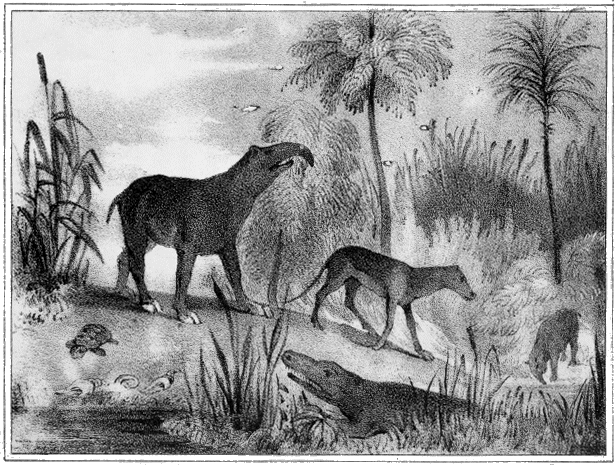
EXTINCT ANIMALS.
I shall show you a picture representing a state of things much more like the present, than the one we looked at before. It existed at a later period, though still a great many years ago; and if you wish to know why we conclude it to be later, since it is the other side of the water and we are therefore prevented from distinctly tracing the succession of the strata, I will tell you.
After leaving the formations of Dorsetshire, in which the great saurian or lizard-like reptiles are found, we come to chalk in Hampshire and the Isle of Wight; and after the chalk, to some beds of clay, and then some beds of limestone. « 22 » The formations above the chalk, are those called tertiary; those from the chalk down to the lowest containing animal and vegetable remains, are the secondary; and all below that, consisting mainly of various sorts of granite, are the primary.
Now all this occurs in the same order in France, and the neighbourhood of Paris consisting of tertiary formations, just corresponds with the tertiary strata of the Isle of Wight, and them we know to be more recent than the secondary formations of Dorsetshire. Of course, therefore, the animals found at Paris, must be more recent than those found at Lyme Regis.
The largest of the animals represented in the plate, is called the Palæotherium.
The following is a picture of his skeleton, as it has been made out, bone by bone. A single tooth was first discovered, and the French naturalist, Cuvier, was able to determine from this alone, a great many particulars which have now been proved by the subsequent discovery of the « 23 » bones; such was the knowledge he had acquired by comparing the bones of different animals. He thus discovered that a certain shape of tooth always accompanied a certain shape of foot, as well as indicated what kind of food the animal lived upon. From this might be judged a great deal about the organs of digestion, and the internal structure, and something of its habits and disposition. In all these points and several others, Cuvier predicted from a single bone of the Palæotherium, what has been exactly confirmed by the entire skeleton.
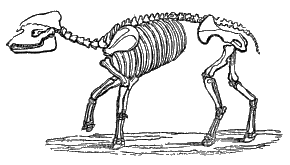
It was about the size of a small horse, and must have possessed a little trunk, or proboscis, like « 24 » the modern Tapir, to which indeed it must have borne a great resemblance.
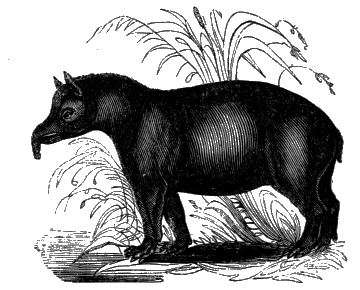
The reason for thinking that it had a trunk, is because there is a peculiar contrivance in the bones to give strength to the neck, which only exists in animals that have a proboscis. There are some Tapirs in the Zoological Gardens, and if you have seen them, you will be able to form a pretty good notion of what the Palæotherium « 25 » must have been. It had perhaps rather more of the hog about it, than the Tapir has, with a more dull heavy expression of countenance.
There were three varieties of Palæotherium distinguished by their size. The smallest was not much larger than a little dog, and you may see the figure of one of them in the picture, going down to the water to drink.
The more slender animal, which is walking towards the water, is the Anoplotherium, or un-armed beast. Its size varied from that of a hare, to that of a large dog; it had a very thick tail like that of the Kangaroo. Everything about it would lead one to suppose that it was a timid creature, whose swiftness and agility would protect it against stronger animals; not unlike in disposition to the antelope, or the hare of our times.
Another animal was living at the same period, which I must describe to you, as it was, as far as we know, the largest quadruped that ever lived upon the earth, and in some respects the « 26 » most remarkable. It was called the Dinotherium, or terrible wild beast, and you will soon know how well it deserved this name. The individual of which a part of the head is now in the British Museum, must have been eighteen feet long in the body, and proportionally large! If you compare this size with that of the largest elephant you have ever seen, you will be able to form some notion of his enormous magnitude.
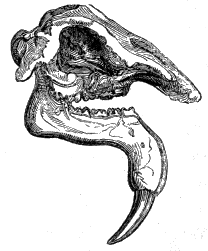
In his general form he somewhat resembled the Tapirs, but by no means so nearly as did the Palæotherium. He had a much longer trunk; and his shoulder blade is formed like that of the mole, by which we know that he must have used his feet in digging. It seems almost certain that he was amphibious: and the back part of his skull has a remarkable similarity to that of the whale, and cetaceous fishes in general. But the most striking peculiarity in the bones which remain of this monster, is the existence of two large tusks bending down from the lower jaw, like two hooks, as you may see represented in « 27 » this cut, of the head preserved in the Museum. His legs were probably rather short, and might have borne nearly the same proportion to his body, as those of the Hippopotamus do to his. From all we can collect, this must have been his general form and appearance.
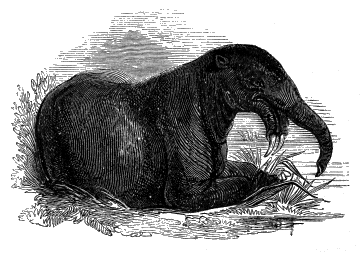
There can be but little doubt that he was of a savage disposition and lead a sulky sort of life divided between the water and the land, like the Hippopotamus. His great tusks must have rendered him a formidable enemy; but as we know that he was a digging animal, it is very likely that he more frequently used them as a sort of pickaxe, to grub up such roots as he wanted to eat, for he lived wholly upon vegetables. He might also have employed them (as Dr. Buckland has conjectured), to stick into the banks of rivers to support his head above water, and to anchor himself so as not to be carried down by the stream, while his huge body lay in his favourite element: or it does not seem unlikely that he might at times have hooked them on to the lower boughs of trees, to sustain himself while he plucked down from above the fruit and foliage with his trunk.
His bones have been found in various parts of France, Germany and Austria.
When these animals were living, the climate « 29 » must have been very much warmer than it is at present in France, for their bones are found associated with palm trees, and other vegetable remains of hot climates, and the bones of crocodiles, tortoises, and other creatures which only live in warm regions. The isle of Sheppey consists chiefly of land which was deposited about the same time, and it contains a great quantity of fossil coffee, and similar plants at present restricted to the East and West Indies, and countries near the equator.
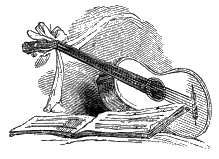
In several parts of England there are great caverns in limestone and other rocks, which contain an immense quantity of the bones of such animals as are now found only in wild countries with warm climates. One of the most celebrated of these caves, is that of Kirkdale, in Yorkshire. Of the bones which most of them contain, three-fourths and upwards belong to bears, of a sort no longer to be found in the living state. One-half, or perhaps two-thirds, of the remaining fourth, have been traced to a species of hyæna, which is also unknown at the present day. A smaller number may be referred to a sort of tiger or lion, and to some species of the wolf or dog family. The smallest specimens are of various small flesh-eating animals, such as the fox, the polecat, and other kindred species. There are also in some of them bones of the Elephant, Rhinoceros, and Hippopotamus.
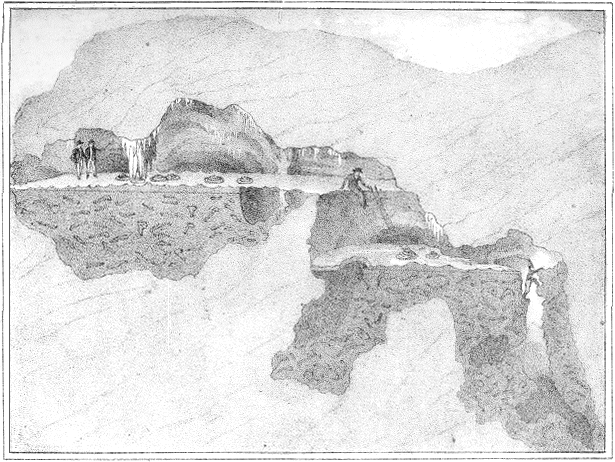
CAVE OF GAYLENREUTH
But the largest and most remarkable of these caves, is at Gaylenreuth, in Germany, of which the picture represents a section. You will understand this representation, if you read the following account of it by Dr. Buckland, the Professor of Geology, in the University of Oxford.
"The first grotto turns to the right, and is upwards of 80 feet long. It is divided into four parts by the unequal heights of the vaulted roof; the first three are from 15 to 20 feet high; whereas, the fourth is only from 4 to 5. On the bottom of this part, and on a level with the floor, there is an orifice only two feet high, which leads into the second grotto. This runs « 32 » first southward for 60 feet, being 40 wide and 18 high; it then turns to the west through a space of 70 feet, becoming gradually lower till its altitude is only 5 feet. The passage to the third grotto is very incommodious, winding through several corridors. It is thirty feet wide, and only five or six high. The loam of the floor is stuffed full of teeth and jaw-bones. Near the entrance to it, is a gulf of 15 or 20 feet, into which visitors descend by a ladder. After going down, they arrive at a vault 15 feet diameter by 30 feet in height; and on the side on which they descend, is a grotto all bestrewed with bones. By going down a little further still, they fall in with a new arcade which conducts to a grotto 40 feet long, and a new gulf 18 or 20 feet deep. Even after this descent, another cavern presents itself 40 feet high, quite covered with bones. A passage now of 5 feet by 7 leads to a grotto 25 feet long and 12 wide; then alleys, 20 feet long, conduct into another cave 20 feet high; and finally, a grand grotto expands, 83 feet in « 33 » width, and 24 in height, more copiously furnished with bones than any of the rest. The sixth and last grotto runs in a northerly direction, so that the whole series of caverns and corridors, describes nearly a semicircle.
"A rift in the third grotto, disclosed in 1784, a new grotto, 15 feet long by 4 wide, where the greatest number of hyænas' and lions' bones were found. The opening was much too narrow to have allowed these animals to have entered by it. A peculiar tunnel which terminated in this small grotto, afforded an incredible number of bones, and large skulls quite entire."
It is supposed that these caves were inhabited by the fierce animals whose bones they contain, and that the other more peaceable creatures were dragged in by them for prey, since their bones have evidently been gnawed and crushed as they would be by fierce and powerful carnivorous animals.
THE ELEPHANT.
I have before mentioned to you the bones of Elephants, as occurring in the bone caverns; they were, however, not just like the Elephants now living in Africa and Asia. The tusks seem to have been larger, and the head not quite so broad and blunt; the teeth were also different.
There are not perhaps many counties in England in which some of these remains have not been found, and generally not far below the surface of the soil. About London, and at « 35 » Woolwich in particular, a great many specimens of the fossil tusks have been collected; they are chiefly of about the consistency of chalk, but if you break them across and look at the end, you can see the grain of the ivory, just as you do on a billiard-ball, or at the end of a knife-handle.
Before anatomy was understood so well as it is at present, the bones of the Elephant, and those of several other large extinct animals, were confounded together under the name of Mammoth. There is a remarkable account of the discovery of what was at the time called a Mammoth, (but which was, doubtless, an Elephant,) imbedded in ice in Siberia, which I shall relate to you, as it is very well written and of undoubted veracity.
"In the year 1799, a Tungusian fisherman observed a strange shapeless mass projecting from an ice-bank, near the mouth of a river in the north of Siberia, the nature of which he did not understand, and which was so high in the bank « 36 » as to be beyond his reach. He next year observed the same object, which was then rather more disengaged from among the ice; but was still unable to conceive what it was. Towards the end of the following summer, 1801, he could distinctly see that it was the frozen carcass of an enormous animal, the entire flank of which, and one of its tusks, had become disengaged from the ice. In consequence of the ice beginning to melt earlier, and to a greater degree than usual, in 1803, the fifth year of this discovery, the enormous carcass became entirely disengaged, and fell down from the ice-crag on a sand-bank, forming part of the coast of the Arctic Ocean. In the month of March of that year, the Tungusian carried away the two tusks, which he sold for fifty rubles, about fifteen pounds sterling.
"Two years afterwards this animal still remained on the sand-bank where it had fallen from the ice; but its body was then greatly mutilated. The peasants had taken away considerable « 37 » quantities of its flesh to feed their dogs; and the wild animals, particularly the white bears, had also feasted on the carcass; yet the skeleton remained quite entire, except that one of the fore-legs was gone. The entire spine, the pelvis, one shoulder-blade, and three legs, were still held together by their ligaments, and by some remains of the skin; and the other shoulder-blade was found at a short distance. The head remained, covered by the dried skin, and the pupil of the eyes was still distinguishable. The brain also remained within the skull, but a good deal shrunk and dried up; and one of the ears was in excellent preservation, still retaining a tuft of strong bristly hair. The upper lip was a good deal eaten away, and the under lip was entirely gone, so that the teeth were distinctly seen. The animal had a long mane on its neck.
"The skin was extremely thick and heavy, and so much of it remained as required the exertions of ten men to carry away, which they « 38 » did with considerable difficulty. More than thirty pounds' weight of the hair and bristles of this animal were gathered from the wet sand-bank, having been trampled into the mud by the white bears, while devouring the carcass. The hair was of three distinct kinds; one consisting of stiff black bristles, a foot or more in length; another of thinner bristles, or coarse flexible hair, of a reddish-brown colour; and the third of a coarse reddish-brown wool, which grew among the roots of the hair. These afford an undeniable proof that this animal had belonged to a race of elephants inhabiting a cold region, with which we are now unacquainted, and by no means fitted to live in the torrid zone. It is also evident that this enormous animal must have been frozen up by the ice at the moment of its death."
THE GIGANTIC ELK.
There are frequently found in the peat bogs of England and Ireland, the bones and horns of a large Elk, called the gigantic Elk, and sometimes the Irish Elk.
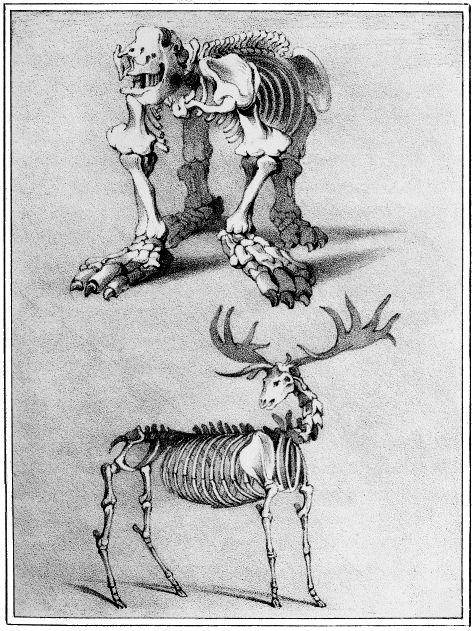
MEGATHERIUM GIGANTIC ELK
Here is a picture of him; and you may judge how well he was entitled to his name, when I tell you that some pairs of his horns have been found, which measured nearly twelve feet across from tip to tip. He must have been considerably larger than the Wapiti Deer in the Zoological Gardens, and of quite a different form.
It is not known when these creatures became extinct; but it is probable that it may have been since Britain has been inhabited by man.
THE MEGATHERIUM.
The bones of this great beast were first found at Buenos Ayres in South America, and a skeleton nearly complete was sent home from thence by the Governor to the Royal Cabinet of Madrid, in 1789. They were found in loose soil, and must apparently have belonged to nearly the same age as the Fossil Elephant and Irish Elk.
The head must have been very much like that of the sloth, but it seems to have possessed the addition of a small trunk like the Palæotherium I told you of just now. The structure of its legs (and in particular its very strong short thigh-bone, which is much stouter than that of any animal living,) shows that it must have moved very slowly.
Its teeth show that it lived on vegetables, and the great ungainly fore-feet, armed with tremendous claws, would lead one to suppose that it used to dig in the ground for roots, and tear down the branches of trees.
It appears to have been covered with a thick shell or coating, thicker than the hide of a rhinoceros, and rather resembling the covering of the armadillo. I have seen a piece of this wonderful coat of armour in the Museum at Paris, which was found along with the skeleton in South America.
If one might decide from its likeness to other animals in its various parts, it was a sulky beast, « 41 » and, if it could have spoken, would only have said to its neighbours, "Let me alone—I want nothing of you, if you want nothing of me."
Its length was full 13 feet, and its height about 9 feet; so you may suppose armed, and defended as it was, there was not much chance of other animals being disposed to meddle with it, for it must have been big enough and strong enough to take good care of itself, though it could not run very fast.
THE BEAVER.
You will, perhaps, be surprised to hear that Beavers once lived in England; but it is known from history, that they were found in Wales as late as the twelfth century. I have got the bones of some, that were given me by a countryman, who picked them out of a peat bog in Hampshire, without knowing what they were. They were buried close by some hazel nuts, and some moss that had not lost its colour, and was « 42 » in no degree decayed; such is the great power possessed by certain minerals that exist in these peat bogs, to preserve things from decay, even during a period which could hardly be less than a thousand years.
It is related, that the foot of a lady, which seemed quite fresh, was found in peat, where it had lain in contact with some of these substances, with a sandal of a kind that must have been worn many hundreds of years ago. And though I will not assert that it is true, yet I will say, that it is very likely to be so, from what I have seen myself, in regard to nuts, and moss, and various weeds.
THE DODO.
When the Dutch in the 16th century, took possession of the Isle of France, now called Mauritius, which up to that time had not been inhabited by man, they found a large bird something of the Duck kind, of which they sent « 43 » home specimens and representations. They called it the Dodo, but why, I cannot tell you.
The race has now become extinct, so that many naturalists have declared that it never existed, and that the account of it was naughtily invented, and sent home for the gratification and delusion of
But there is not the least doubt of its being a fact, for in the Museum in London there is a painting said to have been taken from the living bird; there is also a leg and a plaster cast of the head placed near the painting, which naturalists have determined could not have belonged to any other animal known, from their peculiar construction; there is also another foot and the head from which the cast was taken, preserved in the Museum of the University of Oxford, being the remains of an entire specimen which « 44 » was kept in the collection of curiosities made by Elias Ashmole, Esq. till it rotted. This is representation of these two valuable relics.

The account of the removal of the bones was entered in the records of the University, and the date is the 1st January, 1755.
More recently some of the bones have been found in the Mauritius, and have been sent to Paris, where I have heard they may be seen now.
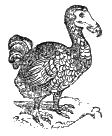
It seems to have been the most unwieldy and inactive bird in existence, and to have held nearly the same kind of place among feathered animals as the sloth does among beasts. The « 45 » body was very massive, and almost round, and seemed to be stuck upon two short thick legs like pillars. The tail was strangely out of its place, according to the usual form of birds; and two little caricatures of wings were hung upon its great blank sides. A thick pursy neck supported the head, which consisted of two enormous chaps that opened far behind the eyes. You will best understand the form of the bill by looking at the cut copied from the painting which I mentioned before, and you may there see how like a monk's cowl the feathers of his head looked.
Some of the Dutch who met with this bird in its own country called it the nauseous bird, and declared that its flesh was intolerably disagreeable to the taste; while others asserted that it was very good eating, and that about three Dodos would feast a hundred men. But whatever may have been the quality of the flesh, I do not believe what the latter said of its quantity, « 46 » for the head and leg which I have seen, and which appear to have belonged to a full grown bird, are not very much larger than those of a swan.
However this is now a question which of course will never be certainly decided, as there are no more of them to be eaten. It appears that, like the beavers and wolves in England, the progress of man and cultivation deprived them of their sources of sustenance.
If we may judge of what his character was, from his appearance, he must have been a silly, voracious creature, with hardly any power of resistance or flight. However, like all the rest of God's works, he was no doubt adapted for the circumstances in which he was placed, and had enough means of enjoyment, to make it well worth his while to live as long as he could.
You have no doubt often heard of Volcanoes and Earthquakes, for almost everybody in all ages has felt a deep interest in them, and a curiosity to know what they are caused by. If you will listen to me, while I merely describe them as they really exist, without "drawing the long bow," as people say, I will then tell you how I think they are produced.
It is quite certain that there is an important connexion between Volcanoes and Earthquakes; and we may safely take this for granted, and at once call the cause of both, whatever it may be, volcanic agency.
It has been discovered by extensive observations, « 48 » that this agency does not exert itself in individual spots, so as to produce here a Volcano and there an Earthquake; but its operations take place over long tracts of country in which the Volcanoes are placed, and, in the spaces between them, Earthquakes are more or less frequent.
These tracts are called Volcanic bands; one of them extends nearly parallel with the West Coast of South America, along the chain of mountains called the Andes, which you will see marked on the map; and another much smaller extends from Mount Vesuvius to Mount Etna, with the Volcanic Island Stromboli, and several extinct Volcanoes lying between them, and then turns to the East, through several of the Greek Islands, and passes on to Syria, where Earthquakes are frequent.
Earthquakes in their simplest form are nothing more than violent shakings of the ground; but sometimes the earth is split open; sometimes it is raised; and sometimes it is depressed.
I shall tell you of some of the changes which took place in the great Earthquake of Calabria, which lies in the smaller volcanic band I mentioned to you between Vesuvius and Etna.
EARTHQUAKE OF CALABRIA.
The shocks began in 1783, and lasted for nearly four years, till the end of 1786. During this time the King of Naples sent persons to take correct notes and representations of all that was going on, and we have therefore got a better account of it than we have of any other Earthquake that ever occurred.
The convulsion of the earth, sea, and air, extended as far as Naples, and over the whole of Sicily; but the district over which it was so violent as to excite intense alarm, was about five hundred miles in circumference.
"The first shock of February 5th, 1783, threw down, in two minutes, the greater part of the houses in all the cities, towns, and villages, from « 50 » the western sides of the Apennines in Calabria Ultra, to Messina in Sicily, and convulsed the whole surface of the country. Another occurred on the 28th of March, with almost equal violence. The chain of granite mountains which passes through Calabria from north to south, and attains the height of many thousand feet, was shaken but slightly; but it is said that a great part of the shocks which were spread with a wave-like motion through the recent strata from west to east, became very violent when they reached the point of junction with the granite, as if a reaction was produced where the wave-like movement of the soft strata was suddenly arrested by the more solid rocks. The surface of the country often heaved like the billows of a swelling sea, which produced a swimming in the head like sea-sickness. It is particularly stated, in almost all the accounts, that just before each shock the clouds appeared motionless; and although no explanation is offered of this phenomenon, it is obviously the same as « 51 » that observed in a ship at sea when it pitches violently. The clouds seem arrested in their career as often as the vessel rises in a direction contrary to their course; so that the Calabrians must have experienced precisely the same motion on the land."
At Messina in Sicily, the shore was rent; and the soil along the port, which before the shock was perfectly level, was inclined towards the sea, and the sea itself was considerably deeper, which showed that the inclination must have been occasioned by the bottom's sinking. The quay also sunk down 14 inches below the level of the sea, and the houses in the neighbourhood were much cracked.
In one town there was a large round tower of great strength, which was divided by a perpendicular rent, and one-half was raised up several feet, so as to show the foundations. Those who saw it, said that it looked like a great tooth half extracted, showing the fangs. Along the line of the crack, the walls were found to fit so exactly « 52 » together, that you would not have known they had even been divided if the courses of the stones had not been disturbed.
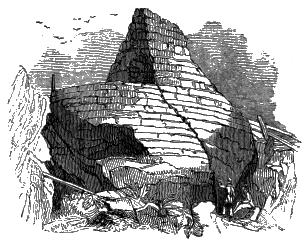
There was a very curious difference between some of the walls which had been thrown down, or very much shaken by some of the shocks. In some of them, the separate stones were parted from the mortar, so as to leave an exact mould where they had rested; and in others, the mortar was ground to dust between the stones. It was not less strange to see the effect of what must have been whirling movements in the ground. In « 53 » some streets, one house would be thrown down, and leave the rest uninjured; while in others, all the houses but one were thrown down, and that one remained firm and unmoved. Two obelisks were twisted round, so that the stones of which they were composed, stood at cross purposes. This cut represents one of the two, as it stood after the earthquake, and before.
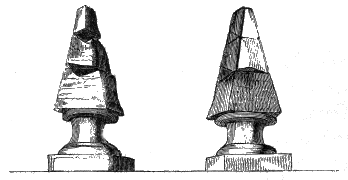
"It appears evident that a great part of the rending and splitting of the ground was the effect of a violent motion from below upwards; and in a multitude of cases where the rents and chasms opened and closed alternately, we must suppose that the earth was by turns heaved up, « 54 » and then let fall again. We may conceive the same effect to be produced on a small scale, if, by some mechanical force, a pavement composed of large flags of stone should be raised up and then allowed to fall suddenly, so as to resume its original position. If any small pebbles happened to be lying on the line of contact of two flags, they would fall into the opening when the pavement rose, and be swallowed up, so that no trace of them would appear after the subsidence of the stones. In the same manner, when the earth was upheaved, large houses, trees, cattle, and men were engulfed in an instant in chasms and fissures; and when the ground sunk down again, the earth closed upon them, so that no vestige of them was discoverable on the surface. In many instances individuals were swallowed up by one shock, and then thrown out alive, together with large jets of water, by the shock which immediately succeeded."
The district called Jerocarne, was torn in a surprising manner, and in one spot the cracks « 55 » resembled those in a starred pane of glass; and as these cracks remained open when the earthquake was over, it seemed as if the middle had been permanently lifted up.
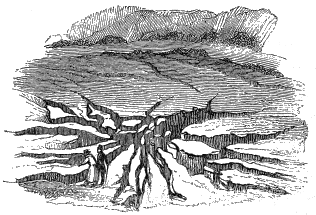
"In the vicinity of Oppido, the central point from which the earthquake diffused its violent movements, many houses were swallowed up by the yawning earth, which closed immediately over them. In the adjacent district also of Cannamaria, four farm-houses, several oil-stores, and some spacious dwelling-houses were so completely engulphed in one chasm, that no vestige of them was afterwards discernible."
Amongst the many fissures that were opened, there was one, a mile long, a hundred feet wide, and thirty feet deep; and another, three quarters of a mile long, one hundred and fifty feet wide, and one hundred feet deep; and a third, about a quarter of a mile long, which was two hundred and twenty-five feet deep.
A mountain was cleft completely in two; and a lake of considerable size was formed by the opening of this great chasm, and springs bursting out at the bottom. The inhabitants of the neighbourhood were afraid that the pool of nearly stagnant water which was thus formed would injure their health, and were at great expense in trying to drain it; but it was all in vain, for the springs that fed it at the bottom were inexhaustible.
A great mass of earth, or hill, two hundred feet high, and four hundred feet in diameter, was moved nearly four miles out of its place, with trees growing upon it; and another similar mass, with a house on it, which was not at all « 57 » injured. Some olive and mulberry trees travelled a full mile. These great movements were aided by springs under the masses of earth, which made a slimy sort of road for them; and, of course, the whole distance was down hill.
"Great agitation was frequently observed in the bed of the sea during the shocks, and, on those parts of the coast where the movement was most violent, all kinds of fish were taken in greater abundance, and with much greater facility. Some rare species, which usually lie buried in the sand, were taken on the surface of the waters in great quantity. The sea is said to have boiled up near Messina, and to have been agitated as if by a copious discharge of vapours from its bottom. The Prince of Scilla had persuaded a great part of his vassals to betake themselves to their fishing-boats for safety, and he himself had gone on board. On the night of the 5th of February, when some of the people were sleeping in the boats, and others on a level plain, slightly elevated above the sea, the earth « 58 » rocked, and suddenly a great mass was torn from the contiguous Mount Jaci, and thrown down with a dreadful crash upon the plain. Immediately afterwards, the sea rising thirty palms above the level of this low tract, rolled foaming over it, and swept away the multitude. It then retreated, but soon rushed back again with greater violence, bringing with it some of the people and animals it had carried away. At the same time every boat was sunk or dashed against the beach, and some of them were swept far inland. The aged Prince, with one thousand four hundred and thirty of his people, was destroyed. The number of persons who perished during the earthquake is estimated at about forty thousand, and about twenty thousand more died by diseases which were caused by insufficient nourishment, exposure to the atmosphere, and malaria, arising from the new stagnant lakes and pools. By far the greater number were buried under the ruins of their houses; while some were burnt to death in the conflagrations « 59 » which almost invariably followed the shocks, and consumed immense magazines of oil and other provisions. A small number were engulfed in chasms and fissures, and their skeletons are perhaps buried in the earth to this day, at the depth of several hundred feet, for such was the profundity of some of the openings which did not close in again."
There is a fine description of the Earthquake and this melancholy result, in Cowper's Task, which we shall quote.
You will find a great many other astonishing effects of this Earthquake described in Mr. Lyell's Work on Geology, from which I have extracted some parts of the preceding account.
VOLCANOES.
The word Volcano comes from Vulcan, the name of the God of fire in the Greek mythology. You have read how the poets used to represent him as engaged underground in forging thunderbolts for Jupiter, and other work of the same kind, with the assistance of his one-eyed journeymen the Cyclopes. They feigned that Volcanoes were the chimneys of his workshops, and that when an eruption took place he was busy forging his iron.
Others pretended that when Jupiter had overcome the giants named Titans, who had rebelled against him, instead of putting them in the stocks, he placed mountains upon them, and that when the imprisoned monsters turned themselves from one side to the other, earthquakes and eruptions were the consequence.
However, we don't believe any of these stories now, neither perhaps did the ancients. But you « 62 » must learn all about them and their meaning, (where they have any,) from your schoolmaster. My business now is to tell you what Volcanoes are.
They are openings in the surface of the earth, from whence ignited matter of various kinds, smoke, and ashes, are sent forth by some subterranean agency.
For the most part they do not always keep in activity, but have long intervals of rest for months, and sometimes for very many years, between the eruptions.
One of the few that always keeps in eruption, is Stromboli, one of the Lipari Islands off the coast of Sicily, which there is good reason to think, has been active for nearly 1600 years. This Volcano is merely a mountain or rock, standing out of the sea, and the melted matter, that occasionally runs down its sides, flows directly into the water, and at once kills and parboils the fish that happen to be near it, and they are thus sometimes taken and eaten by the poor « 63 » fishermen who live about the base of the mountain.
The way in which an eruption takes place in a Volcano of the other kind, when it has been quiet for a long time, is as follows.
Great noises are heard about the foot of the mountain, and earthquakes frequently occur for several days before any change is seen in the opening or crater, as it is called. The springs in the neighbourhood often disappear, and as you may suppose all these forebodings make the people who live near gloomy enough.
After a time a dreadful burst takes place, and the crater is in an instant cleared of the stones and earth that may have fallen into it during the period of repose; ashes and cinders, rocks and stones, are thrown up to an immense height in the air, and a great cloud of smoke and steam accompanies them.
In perfectly still weather, this vapour is seen to shape itself in a very beautiful manner. The immense impulse from beneath sends it up to a « 64 » vast height as straight and almost as distinct as a pillar. At a certain elevation, it spreads abroad and assumes the appearance represented in the plate. When this occurs on Vesuvius, the Italians call it the pine tree cloud, from the resemblance its form bears to that of a pine tree.
As the eruption goes on the cloud of smoke which is always copiously charged with electricity, sends out brilliant lightnings; its form becomes disturbed, and the dark volumes of vapour are angrily sent forth in shapeless masses. Red-hot stones are sent into the air to a stupendous height; the melted matter boils up inside the crater and rolls down the sides of the mountain, setting fire to the trees that it meets with, and destroying or enveloping whatever else remains in its way.
You will see their effect as they appear by night, in the other plate. I should tell you that the Volcano represented in both the pictures is Mount Vesuvius.
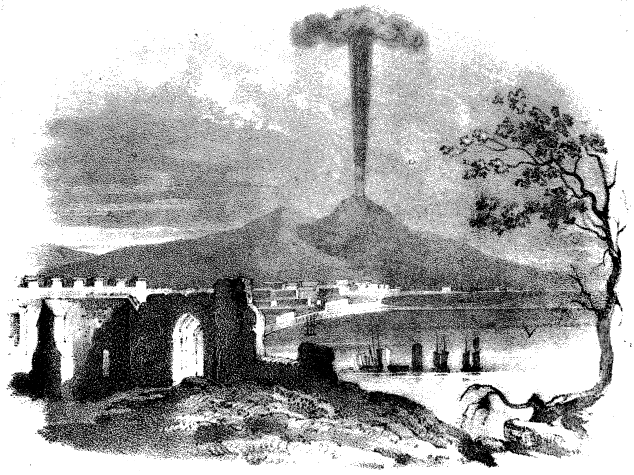
VESUVIUS No. 1
The melted matter that boils up in the crater, and flows down the mountain, is called Lava. I dare say most of you have seen some pieces of this substance when polished and worked into ornaments. It is found in great variety, and is sometimes black, porous, and light like cinders; sometimes it consists of crystallized particles of quartz, felspar, and other minerals, so as closely to resemble granite; and not unfrequently it is a solid dark-coloured mass, heavy and hard as the stone that our streets are paved with.
It issues from the crater in a melted state, bubbling and boiling like water in a tea-kettle, but you must not therefore suppose that it runs down the declivity of the mountain like water. On the contrary, its motion is mostly very slow, seldom being faster when it gets at some distance from the crater, than four miles an hour, which is about as fast as a man can walk. When it has run still further from its source it does not travel more than a few yards in a day.
The motion of a stream of Lava is very peculiar, for the surface exposed to the air is immediately « 66 » formed into a crust, and hence it constantly moves with a crackling noise, and when the stream is quite fresh no light is seen except in the cracks that are constantly being formed at the extremity.
In this way a current will sometimes go drawling on for months after the eruption which gave rise to it has ceased.
A very curious effect is produced when the lava runs in a certain state of fluidity down a steep descent. A thick, strong crust forms on the outside, and it is one of the qualities of lava when it has become hard, like most other stony substances, to present great opposition to the passage of heat. In consequence of this the liquid lava in the inside of the current is kept hot, and continues to run on for a long time after the supply from the crater has ceased, and leaves the crust in the form of an arched passage.
From what I have told you about lava streams, you will see that there is not much danger from them to living creatures, who may always get out of their way fast enough: but sometimes houses and even towns are enveloped in them.
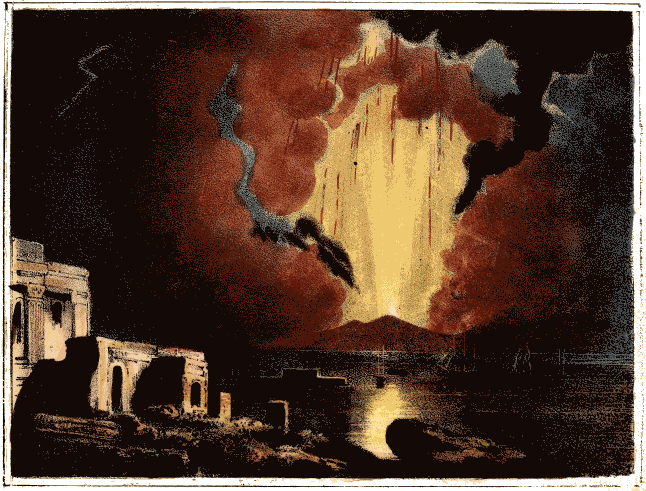
VESUVIUS No. 2
However, from the peculiar mode in which they travel there is often a way of preventing this, and on one occasion it was resorted to, and the town of Catania thereby saved. A current of lava from Mount Etna was making its way straight towards the town, but a body of fifty bold strong fellows went out to meet it, armed with crow bars; with these they broke great holes in the crust at the side, and thus the stream was turned into another course, and pursued its way on one side of the town.
Throughout an eruption, a great quantity of dust is produced by the rubbing of the stones against each other which are thrown out from the crater, and often fall back and are thrown up again several times.
This dust is driven over a great extent of country, and a gentleman whom I visited, who lived about fourteen miles from Mount Vesuvius, told me that during the great eruption of 1822, « 68 » his garden was covered with them, to the depth of full six inches.
But in more violent eruptions they are carried much further than this. In an eruption of a Volcano in Sumbawa, an island which lies some miles to the East of Java, the ashes were carried to a distance of 270 miles in such quantities as to darken the air, and in another direction they were found 300 miles off. They fell so heavily 40 miles away from the Volcano that they broke into many houses, and rendered them uninhabitable.
Quantities of liquid lava are thrown upwards, and shape themselves into nearly the forms of fish by their passage through the air. These are called bombs by the inhabitants, and the fall of them is very justly dreaded, as they come with great violence.
The size of the largest of those from which the following picture was taken, was six inches long, two inches and a quarter wide, and one « 69 » inch and three quarters thick; but there are much larger sometimes.

If you should have a chance of examining any of these, you may observe how wisely the living principle, which gives the figure to fish, has been ordained by their Creator to provide the best form to assist their motions, in a medium in which they are suspended, and do not move on ground as the beasts do; seeing that it is precisely the same sort of figure as the laws of inanimate matter impress upon it, when in a yielding state, and being impelled to move under similar circumstances.
I must give you a notion of the quantity of lava sometimes sent out in a single eruption.
The Volcano called Skapta Jokul, in Iceland, in the year 1794, sent out two great streams, one of which was 50 miles in length, from 10 to 15 in breadth, and the ordinary depth about 100 feet, but in some deep valleys it was more than « 70 » 500 feet. The other was forty miles long, seven wide on the average, and about the same depth as the first.
These streams were not cold in the year 1805, eleven years after they had issued from the earth, so that you may judge how long the hardened lava keeps in the heat.
During the eruption in which this immense mass of melted matter was thrown out, twenty villages were destroyed, more than nine thousand persons killed, and an immense number of cattle.
The vapour which rises at first in immense clouds, when the eruption slackens, or when it gets out of the reach of the heat, condenses, and mingled with the dust thrown up with it, forms mud, which rushes in torrents down the mountain. These streams of mud are called alluvions, and are very much more dreaded by the inhabitants than the lava streams, because they are so much quicker in their movement.
It was one of these, and not a stream of lava « 71 » which enveloped the Roman City Pompeii; and which entered the modern town of Torre del Greco, and so raised the ground that the lower rooms of the houses were converted into cellars, and the people were obliged to make the street doors on what had before been the second story.
THE GREAT VOLCANO KIRAUEA, IN THE ISLAND OF HAWAII.
There is a very remarkable Volcano in the Island of Hawaii, where Captain Cook was killed.
The crater, instead of being at the top of a mountain like those of most other Volcanoes, is a large plain, seven miles in circumference, sunk below the surface of the surrounding country, and walled in by rugged cliffs more than seven hundred feet high.
On this plain there are fifty-one conical hillocks, which are almost constantly sending out « 72 » vapour and lava, and red hot stones. The surrounding banks consist entirely of sulphur and lava.
The islanders, before they were taught the truths of Christianity, believed it to be the abode of their deities, the chief of whom they call Pelé, and to her, they say, that everything which grows near the Volcano is sacred. When some missionaries were going to visit it, and plucked some juicy berries from the shrubs that grew there to quench their thirst, the native guides begged them to desist till they had made an offering to Pelé. When they got to the edge of the crater, they threw some of the berries in, and said, "Pelé, here are your berries, and I am now going to eat some." They then ate fast enough, and were willing that the missionaries should do the same.
The following are extracts from the account of our countryman, Mr. Stewart's visit to this terrific place.
"I can compare the general aspect of the « 73 » bottom of the crater, to nothing that will give a livelier image of it to your mind, than to the appearance the Otsego Lake would present, if the ice with which it is covered in winter, were suddenly broken up by a heavy storm, and as suddenly frozen again, while large slabs and blocks were still toppling, and dashing, and heaping against each other, with the motion of the waves. Just so rough and distorted was the black mass under our feet, only a hundred-fold more terrific, independently of the innumerable cracks, fissures, deep chasms and holes, from which the sulphureous vapour, steam, and smoke were exhaled, with a degree of heat that testified the near vicinity of fire.
"At an inconsiderable distance from us, was one of the largest of the conical craters, whose laborious action had so greatly impressed our minds during the night, and we hastened to a nearer examination of it. On reaching its base, we judged it to be one hundred and fifty feet high, a huge, irregularly shapen, inverted « 74 » funnel of lava, covered with clefts, orifices, and tunnels, from which bodies of steam escaped, while pale flames, ashes, stones, and lava, were propelled with equal force and noise, from its ragged mouth.
"The chattering of the islanders around our cabins, and the occasional sound of voices in protracted conversation among our own number, had scarcely ceased long enough to admit of sound sleep, when the volcano again began roaring and labouring with redoubled activity. The confusion of noises was prodigiously great. These sounds were not fixed or confined to one place, but rolled from one end of the crater to the other; sometimes seeming to be immediately under us, when a sensible tremor of the ground on which we lay took place; and then again rushing to the farthest end with incalculable velocity. The whole air was filled with the tumult; and those most soundly asleep were quickly roused by it to thorough wakefulness. « 75 » One of our party sprang up in his cot, exclaiming, 'We shall certainly have an eruption; such power must burst through everything;' He had barely ceased speaking, when a dense column of heavy black smoke was seen arising from the crater directly in front of us; the subterranean struggle ceased, and immediately after, flames burst from a large cone, near which we had been in the morning, and which then appeared to have been long inactive. Red-hot stones, cinders, and ashes, were also propelled to a great height with immense violence; and shortly after, the molten lava came boiling up, and flowed down the sides of the cone, and over the surrounding scoria, in two beautiful curved streams, glittering with indiscribable brilliance.
"At the same time a whole lake of fire opened in a more distant part. This could not have been less than two miles in circumference; and its action was more horribly sublime than anything « 76 » I ever imagined to exist, even in the ideal vision of unearthly things. Its surface had all the agitation of an ocean; billow after billow tossed its monstrous bosom in the air, and occasionally those from different directions burst with such violence, as in the concussion to dash the fiery spray forty and fifty feet high. It was at once the most splendidly beautiful and dreadfully fearful of spectacles."
OF THE FORMATION OF NEW ISLANDS.
You must know that most of the volcanic mountains bear evident traces of having been built up of matter thrown out, in the first place, from a crack or hole in the ground, and afterwards from the crater or cup, which would thus soon be formed. At every eruption a new layer of dust, and cinders, and lava, is added, and thus a mountain is gradually produced.
In some instances, the successive layers may « 77 » be seen is the crater, as is the case with Vesuvius, of the summit of which this would nearly represent the section, if we could cut it in two.
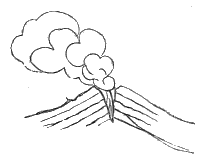
Volcanic operations can go on very nearly as well at the bottom of the sea, as upon dry land; and if you remember what I told you before, respecting the mode in which the currents of lava flow, you will not be much surprised to hear that their progress is not stopped by the water, though it may be somewhat impeded. It is certain that the streams often travel a great way at the bottom of the sea.
When a Volcano breaks out under the sea, if the eruption send out a sufficient quantity of lava, and stones and dust, it gets above the surface and makes such a Volcano as Stromboli.
If the Volcano should afterwards become quiet, « 78 » then an island is the result, and if large enough, it may be inhabited.
A great many of the islands of the South Sea, and some of the Greek islands, originated in this manner; and, only two or three years ago, an island suddenly rose up off the coast of Sicily, and was taken possession of in due form by a British captain, in the name of the king of England; but, as the land consisted of loose earth, and had not much lava to bind it together, it soon sunk down, and now no trace of it is to be seen.
OF THE GEYSERS OF ICELAND.
There are many Volcanoes in Iceland, and the whole island seems to have been the produce of Volcanic agency. I am going to describe to you one of the most singular proofs of this.
Geysers are springs which spout out at intervals great streams of hot water. The name is taken from the Icelandic word, geysa, which signifies, to rage, or, burst forth violently.
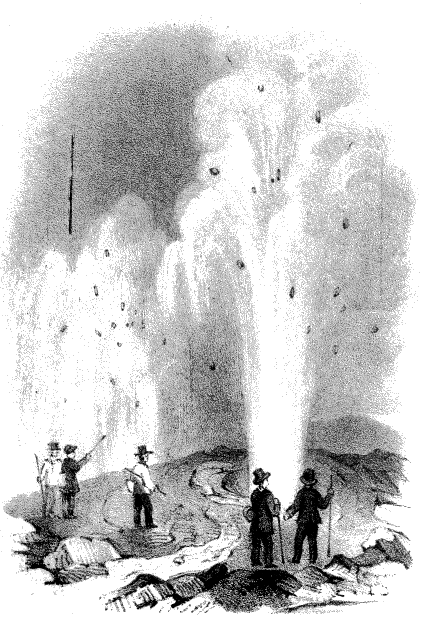
GEYSERS OF ICELAND
The Icelanders are a very simple, excellent people, and exceedingly kind and hospitable to strangers. This is not the place for me to tell you how much kindness I experienced among them; but if I were to do so, you would have as high a regard for them as I have. They have in general a considerable degree of intelligence, but I was surprised to find that a great many of them did not know where the Geysers were, or anything about them.
There are many springs of the same kind in several parts of Iceland; but those that are generally known as the Geysers, are near the town of Haukadal, in the south-west part of Iceland. To these I went in company with four other persons, and a guide.
After a dreary ride through a wild volcanic looking country, we left our horses in a safe place, and then, proceeding some distance on foot, we saw clouds of steam arising over the hills before us. A little further on we got into the plain, where the Geysers are situated, which is « 80 » full of boiling springs and holes sending out steam like the valve of a steam-boiler.
The great Geyser is at the top of a hillock, which seems to have been formed in the course of years by the substances which the hot water holds in solution, and deposits as it cools.
At the top of this mound we found a pond of the shape of a saucer, lined with the most curious incrustations of spar, which exactly resembled the heads of cauliflowers. It was then about half full of the most beautiful hot water, as clear as crystal, which was just stirred in gentle waves by the steam that rose up from the opening at the bottom of the basin.
We took advantage of this tranquil state of the spring, to examine this opening. We let down a line, with a weight at the end, to the depth of about eighty feet, and as nearly as we could judge, it went down perpendicularly.
The hole was nearly round, and about nine feet in diameter, but it got gradually wider towards the top like a funnel. The inside showed « 81 » the same kind of flinty incrustation as the hillock was composed of, worn as smooth as glass by the forcible passage of the water. The water was then at a temperature of two hundred degrees.
The saucer-shaped reservoir was fifty feet across, and four feet deep.
I ought to tell you that the waters of the Geysers have a petrifying property, and hence the ground all around them is covered with what was once grass, moss, and sticks, converted into stone, of which we brought away many beautiful specimens.
It was very late in the evening when we had completed this examination, and fixed our tent where we intended to pass the night. The springs still continued quiet, and you may judge how impatient we were for something to be going on. However, as it was dark, and we were very tired, having had a great deal of fatigue during the day, we lay down in the tent and went to sleep.
About midnight we were suddenly called up « 82 » by one of our party, to witness the great Geyser in its full glory. It threw up several jets, should think of at least ninety feet high, and sent off vast clouds of steam. There was only just light enough for us to distinguish the water and steam; but the effect was very grand, and such as we shall never forget, though it did not leave much behind in our minds to talk about, as everything seemed indistinct and confused.
The next morning, as soon as it was light, there was a beautiful eruption of the New Geyser, as it is called. The column of water was eight feet in diameter, and full sixty feet high, and the clouds of steam were prodigious. The sun was just then rising, and the effect of his rays through the water and stream, was exquisitely beautiful, producing many little rainbows. When the water had sunk down, its place was taken by a tremendous jet of spray and steam, rushing out with a deafening roar to nearly the same height as the water.
When we threw some large stones into the « 83 » pipe, the steam instantly carried them up to an amazing height; and in several instances, when they went up quite perpendicularly, kept them within its influence for some minutes, throwing them upwards several times successively, in a very strange manner; the Geyser seemed to play with them as a boy plays with his ball when he throws it up and catches it again and again.
We were not yet satisfied, because we had not seen an eruption fairly from beginning to end; so we waited some time longer. At about seven o'clock in the morning, we heard low grumbling sounds near the great Geyser, and the water in the basin bubbled up a little more actively.
We then had an hour and a half of anxious expectation, during which we kept walking round the hillock; there were then about a dozen loud reports which made the earth tremble, and the water rose to near the top of the basin, and became so restless that many of the waves washed over the edge.
A little while afterwards, the reports became « 84 » as loud as the firing of artillery; the ground shook violently under our feet; we ran down the mound, and had hardly got upon the level ground before the water rushed up the pipe with such thick clouds of steam, as completely to conceal the stream. These bursts took place in this manner to the height of about twenty feet.
There was then a rest for a few seconds, which was followed by several jets from forty to sixty feet high; and after them a column was thrown up eighty feet high, and ten feet in diameter. But the last jet was the most remarkable, for it was more than ninety feet high, and lasted for seven minutes.
This great effort seemed to have wearied the Geyser, for the water instantly sunk down out of the basin into the pipe, quite out of sight; but in a few minutes it rose again to within a foot of the edge of the basin, and then remained stationary.
Besides the great perpendicular jets, there « 85 » were many little ones curling and twisting about in all directions; and we were taught to be careful of these by one of my companions getting badly scalded in the leg, for they were very sudden and uncertain in their movements.
When we were quite sure it was all over, we tried the temperature of the water in the basin, and found it to be twenty degrees cooler than before the eruption, which was probably caused by the exposure of the water which had been thrown up into the air.
It seems there are generally about five or six eruptions of each of the two great Geysers, within twenty-four hours. But while we were on the spot, many of the smaller springs spouted up much oftener, and one bustling little thing darted out its waters in all directions, three or four times in an hour.
We did not see any jet from the great Geyser above one hundred feet high; but some travellers have asserted that they are at times two or three hundred feet in height. It would appear « 86 » that the force of the Geysers varies considerably, and in some instances is affected by the earthquakes which often happen here; some of which seem to cripple, and others to strengthen them.
Some of the water of the great Geyser falls over the edge of the basin into a deep hole in the rock below, which makes a capital warm bath, for by the time the water reaches it, it is of the desirable coolness. I can assure you, we enjoyed a bathe in it very much indeed.
There are several other springs in Iceland of nearly the same character, and the most remarkable are the Hot Springs of Reykium. The largest of these has two openings, from one of which the water is incessantly flowing to the height of six or eight feet; the other opening is about ten feet distant, and is surrounded by an incrusted brim, like that of the great Geyser. The eruptions take place from this about fifteen times in twenty-four hours, to the height of about thirty feet, accompanied with a great deal of steam.
There is also a most wonderful spring in Reykium, called the Badstofa. It flows into a great cave, from the bottom of which the water keeps on retreating and flowing like the waves of the sea, with a deep rumbling sound for some time before the eruption, when the water rushes up to the height of nearly twenty feet.
About half a mile from this place, there are some Hot Springs that rise in the bed of a river, and force themselves quite through the cold water which covers them.
THE SULPHUR MOUNTAINS AND SULPHUR SPRINGS.
There is a wonderful place in Iceland, which I am sure you would like to hear about. It is in the south-west part of the island nearer the sea than the Geysers. Nearly the whole region consists of sulphur, and hot clay, and hot dirty water, and it contains some mountains, called the Sulphur Mountains, from which great quantities « 88 » of sulphur are collected by the peasants, and sent to the continent of Europe for sale.
The vapour that is always rising from this wretched-looking country, makes a sort of crust over the hot clay; and you will sometimes come to a spot that appears solid, and as you go over it, your horse's hoofs will make holes which will send out steam like little cauldrons. A gentleman who would go over one of these on foot, got terribly scalded by the crust breaking away under him.
There is here a sort of hut, from the bottom of which much steam rises, and it is used as a vapour bath. People that are affected with various diseases, come to it from the surrounding country in considerable numbers.
At a little distance from this you come to the brink of a cliff, and looking over it, you see twelve large ponds or basins of black mud, boiling, and splashing, and raging perpetually, with large volumes of vapour rolling off their surfaces. « 89 » Beyond these some dismal black-looking mountains make a back ground. Can you imagine any thing more fearful to look upon?
Besides these, there is a kind of Geyser of mud, which just resembles the real Geysers in its action; but instead of sending up beautiful clear water, it throws out black unsightly mud, as thick as porridge, which is caught in a nearly round reservoir of more than one hundred feet in diameter. It is situated near the summit of a mountain called Krabla and the reservoir seems to have been in time past a volcanic crater.
HOW THE GEYSERS MAY BE CAUSED.
Of course there cannot be hot water without some source of heat, and there must, therefore, be a source of heat taken into consideration in the action of the Geysers. Now, I do not wish to speak of this here, I only wish to make you understand how it seems likely that the eruptions « 90 » of the Geysers are occasioned, supposing there was a supply of hot water.
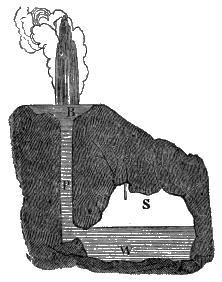
This cut is intended to represent what may be a section of the subterranean reservoir, S W, of the great Geyser, and the pipe, P, connected with the saucer-shaped basin, B, at the top of the mound. You see the cracks in the rock through which you must suppose hot water constantly trickling into the reservoir.
The space S will be constantly full of steam, and the space below, W, will be always full of water. The water will continue to rise till it gets to A, and it will then quite stop up the escape of the steam.
The steam in S will then press upon the surface of the water, and force it up the pipe P « 91 » with more or less violence, according to the supply of heat; but when enough of the steam has escaped to render the pressure less, and the water has sunk to near I, the eruption will cease.
If you will take the trouble to understand this section, you will see how reasonable it is that the Geyser should be so constructed; and I have seen a little apparatus made of glass, which showed exactly the same sort of operations.
Some little variation in the shape of the reservoir and pipe, may perhaps be needed to account for all that takes place; but the principle of the activity being produced by the agency of steam, acting in a space which may be enclosed by the water in its rising to a certain height, seems to be certain and satisfactory.
In some parts of the world, there are rocks which are not stratified and arranged like those which I described to you some time ago, but are laid over the surfaces, and in the crevices of others in this manner:—

In this cut, a, a, a, are intended to represent the stratified rocks, and b, b, b, the others, which from their position are sometimes called overlying rocks, and they mostly consist of a substance called basalt, which is nearly black and very hard, and occasionally with white and coloured minerals imbedded in it. There are two states in which it is found; in one, it occurs in masses without any particular form, and in the other state it constitutes pillars shaped with great accuracy and regularity.
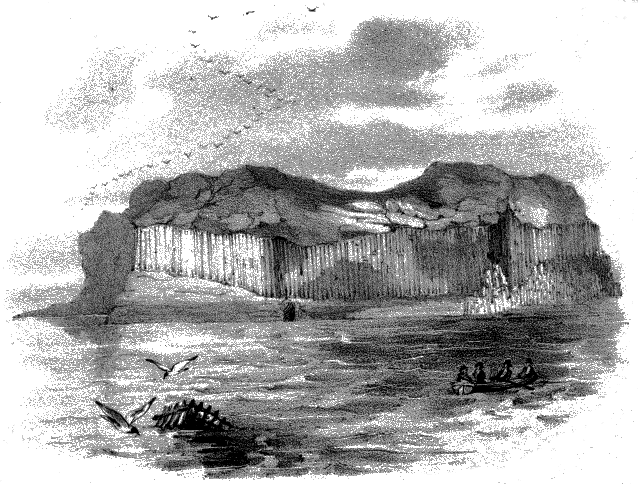
STAFFA.
The island of Staffa, one of the western islands of Scotland, and the Giant's Causeway, on the north coast of Ireland, near Londonderry, are remarkable instances of the latter state; and as I have seen them both, I will tell you what sort of places they are.
STAFFA.
This wonderful island was not generally known to exist, even by the inhabitants of Scotland, till the last century, when Sir Joseph Bankes happened to see it, and published an account of it. Since then it has been visited by numbers, and lately a steam-boat has regularly plied to it twice a week, from the little town of Oban, in Argyleshire.
It was in this way that I went, and a most « 94 » delightful trip we had of it. The steam-boat left Oban in the afternoon, full of kind light-hearted people, who seemed fully resolved to enjoy themselves. In the evening we reached the island of Mull, where we were to spend the night.
The inhabitants of Tobermory, (the little capital of Mull,) anxiously look out for the arrival of the steam-boat, for they are very poor, and the little money which the passengers spend, is a great object to them. On these occasions the inns are seldom large enough to accommodate all the strangers, and then a strange scramble takes place to get lodgings for the night. Most of our party succeeded in doing so, and the rest remained on board the steam-boat.
We went to see a beautiful little estate on one side of the harbour of Tobermory, which belongs to the son of the old Laird of Coll, whom Dr. Johnson visited. The grounds are nearly in the shape of a triangle, and the two sides that are away from the sea, are formed by « 95 » lofty rocks with several beautiful waterfalls; and in the middle is a pretty lake. Except the house on this estate, there are scarcely any good houses in or near Tobermory, and the inhabitants are very ignorant and poor. Many of them who could not speak any other English words, ran after us to ask us for pence and tobacco.
We started early in the morning, and passed several small islands of curious forms, composed of basalt; one in particular, which is called the Dutchman's cap, shaped like this.

As we approached Staffa, on the north side, we could see scarcely anything of the pillars. It appeared a mass of Basalt, of very irregular shape, rising abruptly out of the sea, scantily covered with grass on the upper surface.

It is the south side of the island that is chiefly remarkable, of which I will show you a picture that I made on the spot.
It has (as you may see) exactly the appearance of a great layer of earth swelling out at the edges, resting on a vast number of pillars stuck close together. The colour of the pillars is nearly black, and that of the stratum above, lightish green, yellow, and brown, from the grass and variously coloured lichens that grow upon it. The sea is very deep, quite close to the cliffs.
The day I was there, was as fine as possible; not a cloud was to be seen, and the great ocean was as calm as a mill-pond, which is not very common in these parts, for there is mostly a considerable swell.
The celebrated cave of Fingal, as it is called, (but why, nobody knows,) is close to one extremity of the south side.
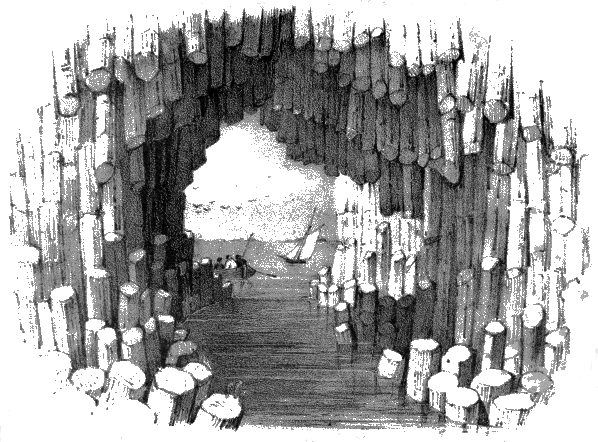
FINGAL'S CAVE
It seems just as if it had been formed by cutting away the middle of some of the pillars, since you can see that many parts of the pillars now remaining on the roof, are placed as if they were continuations of the stumps on which you walk at the bottom.
We went into it in a boat, and when we were at the farther end, we got out upon the broken pillars and surveyed everything at our leisure.
The length of the cave is two hundred and fifty feet, the breadth about forty, and the height above one hundred feet at the entrance, and seventy at the inner end.
Along the middle of the roof, is a deep cleft, or fissure, which makes it something like a pointed arch, resembling the roof of a cathedral. The sides of the fissure are variegated, yellow, red, brown, and white, in consequence of water containing various substances, soaking through from the surface above; and on each side of it, there are several rows of the top of the broken pillars, which look quite black.
On the sides at the bottom, the stumps form a sort of pavement like this, which is an exact « 98 » copy of a small portion of it, and will show you the forms of the pillars; some stand higher than others; but there is not generally sufficient difference to prevent you from walking over them.
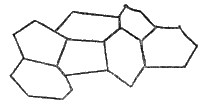
Between these pavements the water is very deep, and as it flows direct from the Atlantic Ocean without any dirty shore or shallows, it looks very beautiful,—of a clear emerald green, showing at the bottom the black basaltic pillars in ruins, and a very few long luxuriant sea-weeds gracefully waving with the undulations of the water.
The exposed surfaces of the pillars, between high and low water-marks, are covered with the little shell-fish called balanus, or BARNACLE, of colours varying from pink, which is the hue of those that are placed deepest, to yellow and white, which are those that are least covered by the water.
The walls of the cave above these shells, are of a deep slate colour. The pillars which compose « 99 » them, are on the average about three feet in diameter, and they are fitted so close together that you cannot get a penknife in between them. If separated at certain intervals, they break short off, and leave a remarkably level surface without the least splinter. Between these joints they break roughly and irregularly.
Here is a view of the inside of the cave.
It is supposed that these wonderful pillars are formed by the cooling of a melted mass, and that this and other basaltic spots, are the remains of streams of lava from a volcano long ago extinct.
In some of the lava streams of Mount Vesuvius, there has been noticed an approach to this structure, though not quite so regular as what we have been describing.
You may understand in some measure how it may come about, by examining starch, which always hardens into little columns or pillars; and if you look at the little sketch of a portion of the pavement of the cave which I have given you above, you will see that nearly all the pillars « 100 » have six sides, the same as the pieces of starch.
It is remarkable what pains the basalt seems to have taken to get into a six-sided form. I should think about two-thirds of the columns have six sides, though sometimes one side is little more than a sharp edge blunted, because it seems to have been prevented by its neighbour making a similar effort to get its six sides complete.
None of the remaining third of the pillars, have more than nine, or, of course, less than three sides. You might look a long time before you would find two pillars exactly alike.
All this you will find occurring just in the same manner in starch, except that the edges of the basalt pillars are quite even, while those of starch are more or less waved or twisted.
Near the side of the cave there is a little rock formed by pillars into a pretty regular cone, which you may see in the plate. It has a very striking appearance as you approach the island.
Close by the rock there is a little cave, the mouth of which is formed by bent pillars, in this manner.
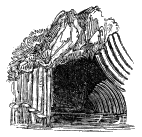
The water in this is not very deep, but it was deep enough to give one of my companions a good ducking as he was trying to reach a shell which one of the ladies of our party wanted to possess.
You will also often see something like these bent pillars in starch.
THE GIANT'S CAUSEWAY.
On the north coast of Ireland, the Giant's Causeway is a collection of similar pillars of rather a smaller size. They stretch far into the sea, and at low water you may walk a long distance upon the tops of them.
The pillars get higher as they approach the cliff, and in the cliff itself, just above them, is a remarkable layer of fossil wood in the state called lignite, which closely resembles charcoal.
At some distance from the Causeway, some of the pillars stand up by themselves, looking just like tall chimneys. There are also some wonderful caves in the Basaltic cliffs behind it, but none of them consisting of pillars like the great cave of Staffa. It is called the Giant's Causeway, because some people have fancied that it resembled the commencement of a great pier or causeway, which some beings of superhuman power had left unfinished. This is only a fancy for poets to talk of; you and I are now engaged about facts.
There are some similar formations in Iceland, of very great extent, and in several other parts of the world; but those I have told you about, are the most remarkable which are known to exist.
WHY PARLEY BELIEVES THAT THERE IS A GREAT SOURCE OF HEAT WITHIN THE GLOBE.
If you have attended to what I have already told you, you will have seen that there must be a close connection between the causes of volcanoes, earthquakes, and hot springs, (if they are not all to be ascribed to one cause,) from their always occurring in the neighbourhood of each other. But there is something else that you ought to notice in reference to this connection.
I said, that a volcanic eruption was almost always preceded by shakings of the ground round the root of the mountain. These shakings are sometimes so violent as to be dreadful earthquakes, « 104 » and at other times the earthquake will be at a long distance from the volcano.
There was once a great earthquake which kept on for some days on the north shore of South America, and then stopped quite suddenly. It was afterwards found out, that just at the moment it stopped, a tremendous eruption burst forth from a volcano in one of the West-India islands, more than 150 miles off.
You know what the safety-valve of a steam-engine is. Now it would seem just as if volcanoes were safety-valves for the power which causes earthquakes.
Very well.—I am now going to tell you what people have thought this power has been owing to. Before I do so, that you may not be disappointed, I should tell you that we know very little on the subject; nor shall we ever know much till somebody can get down to the centre of the earth, unless some of the little black spirits, that the Rosicrucians called Gnomes, and fabled to live in the middle of the globe, should « 105 » be kind enough to give us some information on the subject.
In the meantime, we can only guess; but we ought to guess as well as we can, and see whether our guess is not much more likely to be true than any of the others.
Volcanic bands are always near the sea-shore, and it has therefore been generally supposed that water has something to do with their action.
If you take a mixture of sulphur and iron filings, and mix them into a paste with water, and then bury them in the ground, after a while they will become hot and send out a great quantity of steam. Some people have imagined that this is the way in which volcanic activity is produced, but no one thinks so now, and for very good reasons, for there is nothing in the action so produced at all capable of accounting for long continued eruptions, or for the flowing out of the lava.
Sir Humphrey Davy found out, that nearly all « 106 » kinds of salt and earth, which had been before looked upon as simple substances, contained certain metals united to oxygen, which, (as you should know,) is one of the parts of water, and, in the form of gas, of the air we breathe. If you put a piece of one of these metals into water, it is in such a hurry to join itself to the oxygen of the water, that you set it on fire. A little piece of potassium, (the metal of the salt called potash, or pearlash,) will float for a few moments on the surface of the water, burning with a purple flame in the prettiest manner imaginable.
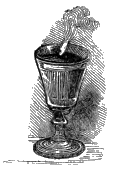
Sir Humphrey thought he had got the true explanation of the thing. These wonderful metals formed the basis of every substance in lava, and supposing them to exist in the centre of the globe, it was only necessary for water to get to them to set them on fire, and thus to give rise to earthquakes and volcanoes. It appeared only to be required that a crack should be made at « 107 » the bottom of the sea, and the water flow into the beds of metal underneath, and the violent action produced would burst through the surface, and throw out streams of melted matter, accompanied with great clouds of steam, just as takes place in the eruptions of Mount Vesuvius and other volcanoes.
But you would find it very difficult to think how this can account for continual and nearly steady operations, such as have been known to exist in the Geysers of Iceland for more than 1000 years, and in Mount Stromboli for much longer than that, so we will try another guess.
It has been observed in descending deep mines, that the earth gets warmer the deeper you go. The usual mode of trying it is to dig little holes, as you go down, in the sides and bottom of the mine, and put a thermometer into them. A great many observations of this kind, have been made in different parts of the world, and the greatest care has been taken to allow for all causes of irregularity, consisting « 108 » in climate and local peculiarities. Comparing these together, it has been determined that the temperature increases about one degree every fifteen feet of descent.
A similar conclusion has been drawn from the heat of the water of the Artesian Wells. But, perhaps, you do not know what Artesian Wells are, so I will tell you.
They are deep borings in the earth, out of which water rises to, or even above, the surface of the ground. Wherever you bore, if you go deep enough you may get plenty of water, and this water is always found to be warmer in proportion to the depth of the well in which it rises. They are called Artesian Wells, from Artois, a town in France, where the first was constructed.
In a well of this kind near Rochelle, which was 316 feet deep, the water near the surface was at a temperature of 55 degrees, and at the bottom 60 degrees. It was afterwards sunk to « 109 » the depth of 369 feet, and the temperature at the bottom was then found to be 65 degrees.
Do you not think it most likely that the heat continues to increase quite as fast in proportion below the deepest point that man has gone down to? Well, if so, at the depth of some miles it must be hot enough to melt anything, even granite, and all kinds of stones.
If we suppose, on this evidence, that the centre of the globe is intensely heated, and that it gets gradually cooler towards the surface, there is what at once will account for the hot springs, the increasing heat in descending mines, the constant action of some volcanoes, the occasional action of others, the streams of lava, and the nature of all substances that are thrown out.
It is very natural to imagine that every now and then the action of the great heated mass inside, would crack open the crust, and the sea wearing away its bottom in some places as it does, may have something to do in assisting this. « 110 » Thus, new volcanoes would be formed, and earthquakes would happen where they never happened before; and over these immense cracks there would be a volcanic band.
Then, after a time, these cracks might be partially, or wholly, filled up by the matter thrown into them, and the volcanoes on the surface above may become quiet for a time.
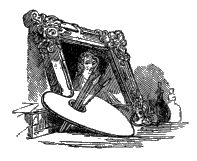
I am going to relate to you the biography of a Volcano, and I hope you will find it amusing.
Before the time of the Roman Emperor Trajan, Mount Vesuvius had been quiet for a great many centuries. It is known that it had had many eruptions before then, because there are some great lava streams close by it, on which some of the most ancient Italian cities are built. In particular, Herculaneum, which was said to have been built by the Demi-god Hercules, and must therefore have been of the remotest antiquity, was built chiefly of blocks of lava, and « 112 » founded upon a vast stream of the same substance.
And besides, there is no doubt that the land all about the neighbourhood in the remotest times, bore evident marks of the action of fire; for it was here that the Poets pretended that the gate of Hell was, and close by the black and dreary-looking lake Avernus, which you may read about in the Æneid of Virgil. This was also the place where the Cimmerians dwelt, whom Ulysses is said to have visited, according to Homer, on his way to the regions of the dead.
THE GROTTO DEL CANO.
Near here, too, was the celebrated Grotto del Cano, the cave which used to destroy the lives of small animals put into it, by means of the exhalations that rose from the bottom; but as these exhalations were heavier than the air, consisting chiefly of the gas called carbonic acid, they did not rise much above the bottom. This is what an old writer, the account of whose travels I am very fond of, says of it.
"Whatsoever hath life, being thrust into the farre end, doth die in an instant. Yet entred it may be a good way with safety; neither heat nor cold will oppress you, nor is there any damp or vapour to be discerned; being perspicuous to the bottome, and the sole thereof dusty. We made triall with a dog; which we no sooner had thrust in, but without crying, or otherwise struggling than if shot to the heart, his tongue hung out, and his eyes setled in his head, to our no small amazement. Forthwith drawne out, starke, and to our seeming without shew of life, we threw him into the lake; when anon he recovered, and swimming to the shore, ran crying away as fast as hee could, to the not farre distant Osteria: where they get no small part of their living by shewing this place unto forreiners. And it is a sport to see how the dogs thereabout will steale away, and scud to the tops of the mountaines, at the approach of a stranger. The French King Charles, the eighth of that name, who held the kingdome of Naples « 114 » for a while; made triall thereof with an Asse, which immediately died. The like befell to a foole-hardy souldier. Peter of Toledo caused two offenders to be thrust thereinto, and both expired in a moment. Nor found those three gallants any better successe, who tempted God with their desperate entrance. This place was not unknowne to Pliny, who calleth it the Cave of Charon. The cause of so deadly an effect, is said to proceede from the fervent vapours ascending at invisible pores, so thin, so dry, and subtile, as not to be discerned: yet thickned by the cold that enters at the mouth of the Cave, convert into moisture, which hangs farre within on the roofe like to drops of quick-silver; and such esteemed to bee by a number. Carona Pighyus, desirous to informe himselfe in the mysteries hereof, ventured so farre in as to touch one of those farre of shining drops, and shewed it to his companions, who entred also, and stayed therein about a minute of an houre: sensibly perceiving the heat to arise from their « 115 » feet to their thighs, till they did sweat at the browes without the endammaging of their senses, who return'd, to the wonder of the guide, that thought they had preserved themselves by enchantments. By this their experiment it appeares that the aire is most deadly neere to the pores where it first ascended; especially to such creatures as hold their heads downeward, exhaling at their nostrils the dry and hote vapours. Thrust a torch neere the bottome, and it will forthwith go out: yet advanced higher, re-inflames, which approves the former assertion."
OF THE DEATH OF PLINY THE NATURALIST.
But although there were such gloomy places in the neighbourhood, in the reign of Trajan, less than a hundred years after the Christian Era, Mount Vesuvius was clothed with blooming vineyards, and corn fields, studded with villas and beautiful gardens, and with three or four rich and populous cities near its foot.
The height of the mountain was then much « 116 » less than it is at present, and it seems to have had a broad flat top, nearly surrounded by a ridge.
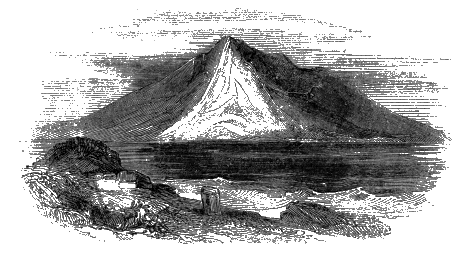
This shape will account for the spot being chosen by the Roman rebel Spartacus to encamp in, with his gladiators and slaves, when he put Rome in danger.
For some time before the first eruption on record, there were dreadful earthquakes, of which the effects are still to be seen in the cracked and ruined walls of Pompeii and Herculaneum. "There were great droughts," says the historian, "and violent earthquakes, so that the whole plain « 117 » boiled and bubbled, and the hills leapt, and there were noises under ground like thunder, and above ground like roaring; the seas made a noise, and the Heavens resounded, and then a sudden mighty crash was heard, as if the mountains were dashed together; great stones were then hurled upwards, and were followed by mighty fires, and immense smoke, so that the whole air was overshadowed, and the sun quite hidden as in an eclipse."
The same writer then tells us about some wonderful giants appearing to wander about the summit of the mountain, which neither you nor I shall be ready to believe.
Pliny, the great naturalist, was at that time living at the town of Misenum, and as he was a man always prying into nature, and wishing to know the causes of things, you may suppose his curiosity was very much excited by these strange occurrences. But he paid dearly for this laudable curiosity, as you shall hear in the account which his nephew has left us of the event.
"On the 24th of August, about one in the « 118 » afternoon, my mother desired him to observe a cloud which appeared of a very unusual size and shape. He had just returned from taking the benefit of the sun, and after bathing himself in cold water, and taking a slight repast, had retired to his study. He immediately arose and went out upon an eminence, from whence he might more distinctly view this very uncommon appearance. It was not at that distance discernible from what mountain this cloud issued, but it was found afterwards to ascend from Mount Vesuvius. I cannot give a more exact description of its figure, than by comparing it to that of a pine-tree, for it shot up a great height in the form of a trunk, which extended itself at the top into a sort of branches; occasioned, I imagine, either by a sudden gust of air that impelled it, the force of which decreased as it advanced upwards, or the cloud itself being pressed back again by its own weight, expanded in this manner: it appeared sometimes bright, and sometimes dark and spotted, as it was more « 119 » or less impregnated with earth and cinders. This extraordinary phenomenon excited my uncle's philosophical curiosity to take a nearer view of it. He ordered a light vessel to be got ready, and gave me the liberty, if I thought proper, to attend him. I rather chose to continue my studies; for, as it happened, he had given me an employment of that kind. As he was coming out of the house, he received a note from Rectina, the wife of Bassus, who was in the utmost alarm at the imminent danger which threatened her; for her villa being situated at the foot of Mount Vesuvius, there was no way to escape but by sea: she earnestly entreated him, therefore, to come to her assistance. He accordingly changed his first design, and what he began with a philosophical, he pursued with an heroical turn of mind. He ordered the gallies to put to sea, and went himself on board with the intention of assisting not only Rectina, but several others; for the villas stand extremely thick upon that beautiful coast. When hastening « 120 » to the place from whence others fled with the utmost terror, he steered his direct course to the point of danger, and with so much calmness and presence of mind, as to be able to make and dictate his observations upon the motion and figure of that dreadful scene. He was now so nigh the mountain, that the cinders, which grew thicker and hotter the nearer he approached, fell into the ships, together with pumice-stones, and black pieces of burning rock: they were likewise in danger, not only of being aground by the sudden retreat of the sea, but also from the vast fragments which rolled down from the mountain, and obstructed all the shore. Here he stopped to consider whether he should return back again; to which the pilot advising him, 'Fortune,' said he, 'befriends the brave; carry me to Pomponianus.'"
His nephew then goes on to relate that he joined his friend who was in another vessel, and went on shore, where he took a bath and sat down to supper, not seeming to be in the « 121 » least alarmed, when everybody about him was in the greatest consternation. He then went to sleep so soundly, that he was heard to snore. The ashes fell so thick in the court before his apartment, that it was getting nearly impassable, and his servants thought proper to awaken him. The walls of the houses began to rock, and he and his friends then resolved to go out into the fields, lest the stones and bricks should fall upon them. They tied pillows upon their heads, and went out with torches, for though it was daytime, the clouds of steam and ashes made it quite dark. They went down to the sea, and found it in violent commotion. Either a sudden gust of wind then brought the effluvia of the volcano towards them, or else a little stream of deadly vapour burst out from a crack in the ground, which dispersed the rest of the company. But Pliny, who was a fat asthmatic old man, had laid down upon the ground to watch what was going on. He attempted to rise, but almost before he had got on his feet, he fell down dead.
"As soon as it was light again," says his nephew, "which was not till the third day after this melancholy accident, his body was found entire, and without any marks of violence upon it, exactly in the same posture that he fell."
It was in the same eruption that the two great cities, Herculaneum and Pompeii were overwhelmed by substances thrown out by the volcano. It does not appear that a single stream of lava flowed out till many years afterwards.
There were several great eruptions between this time and the year 1306, and then the volcano was very nearly quiet for more than 300 years. During this time the volcanic power broke out in another place called Puzzuoli, at several miles distance. After a succession of violent eruptions, the earth was cleft open, and a hill, which is now called the Monte Nuovo, was thrown up in the space of a single night, which is 440 feet high, and a mile and a half in circumference.
At the end of this period Vesuvius was richly covered with vegetation, even within the crater. But since the year 1650, there has not been ten years pass without an eruption.
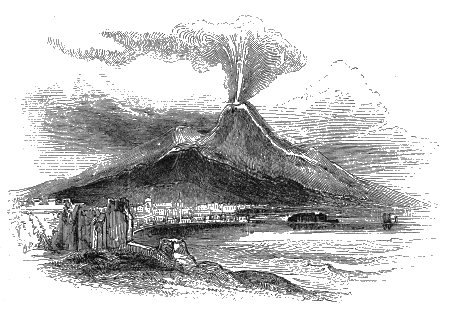
The form of the mountain has quite changed, and a little mountain has grown up out of the old broad topped one, as you may see in the above picture.
HERCULANEUM AND POMPEII.
These cities which were of great extent and importance, seem to have been almost forgotten during more than 1600 years. They are not often mentioned in Roman history, and, strange to say, the Latin writers who describe the eruption of Vesuvius, by which they must have been buried, have said nothing about them, except a very vague allusion or two, which would hardly have attracted any notice, if what I am going to tell you of, had not happened.
In the year 1713, as some people were sinking a well, they discovered two statues, one of Hercules, and the other of Cleopatra; and continuing to dig in several directions, they found they had got into a Roman theatre, and after a while they discovered that this Theatre was that of the City of Herculaneum. But in consequence of the hardness of the ground, and the great depth of the city under the surface, which is « 125 » one hundred feet, they have only been able to clear out a very few buildings, and those cannot be seen except by torchlight, so that very little is known about it.
I cannot tell you exactly how the ruins of Pompeii were first discovered to be the remains of a city. It appears that an architect, who was employed to make a subterranean canal to convey water to the town of Torre dell'Annunziata, nearly 300 years ago, met with some fragments of buildings; and about eighty years afterwards, enough was seen to convince the discoverers that the ruins were extensive. In the year 1755, a regular plan of excavation was commenced, and nearly the whole city is now exposed to the light of day.
The situation of Pompeii is considerably further from the crater of Vesuvius than that of Herculaneum, and to that circumstance is owing the superiority of its preservation, and the greater moveableness of the substances which covered it. It is probable that both cities were « 126 » originally assailed by alluvions, or streams of mud, such as I told you of some time ago, as well as by showers of cinders and stones. But while Pompeii was only fourteen or fifteen feet below the surface, and never had anything besides cinders and earth above it, several streams of lava flowed over Herculaneum, with layers of the different substances, which the volcano throws into the air, between them, so as to raise the surface one hundred feet.
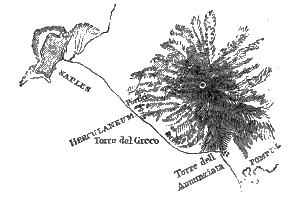
Pompeii was three miles in circumference, and was a sea-port town, though it is now a full mile from the sea. This is known, because « 127 » the steps which used to lead down from the quay, for the convenience of passengers going into boats, are still remaining, and so are some large metal rings which were intended for cables to be fastened to.
There are several inscriptions in both cities commemorating the great injuries done by an earthquake which happened in the reign of the Emperor Nero, sixteen years before they were destroyed. There are also great cracks to be seen in some of the walls, testifying of the same event. This was one of the efforts of the volcanic power to get free before Vesuvius became the safety-valve.
It is very evident that there was ample warning of the catastrophe before it happened, and that most of the people had time to escape, for the number of skeletons found has been but small. In the barracks, there were the skeletons of two soldiers chained in the stocks. There were seventeen persons found in the cellar of a house just out of the town, who seem « 128 » to have fled there for safety, and the deluge of mud then seems to have flowed in upon them, for their bones were found in hardened mud. One of the number was a woman, with an infant in her arms, and the impression of her form in the mud, was wonderfully perfect, though there was nothing left of her but the bones. She seems to have been the mistress of the house, and a person of consequence, since she had a chain of gold about her neck, and rich rings on her fingers.
In these instances, (and there are related several others similar,) the destruction of the persons seems to be accounted for by the peculiar circumstances in which they were placed. The soldiers, poor fellows, would, doubtless, have gone off with their companions, if they had not been in the stocks; and the family of seventeen might have escaped if they had fled into the open country, instead of into their cellar.
The warning does not however seem to have been very long before the sad event, perhaps only « 129 » about an hour. There have recently been found three skeletons, which seem to have belonged to a father, mother, and daughter, (the latter of whom was decorated with pearl-rings and ear-rings,) who were in the act of rushing out of their house. And in one of the squares of the city, a traveller saw "a new altar of white marble, exquisitely beautiful, and apparently just out of the hands of the sculptor, which had been erected there; an enclosure was building all round; the mortar, just dashed against the side of the wall, was but half spread out; you saw the long sliding stroke of the trowel about to return and obliterate its own track—but it never did return: the hand of the workman was suddenly arrested, and, after the lapse of 1800 years, the whole looks so fresh and new, that you would almost say the mason was only gone to his dinner, and about to come back immediately to smooth the roughness."
It is not unlikely that in the early part of the eruption, the ashes and cinders which the volcano « 130 » threw out, fell in showers on the cities, and that the walls were shaken by the subterranean movements, so that most of the inhabitants thought themselves less in danger in the open fields, like the people of Misenum, who went into the fields with pillows tied on their heads, as described by Pliny the younger, in the passage I quoted just now. Some few others, less afraid of their houses tumbling down about their ears, than of the bombs and cinders, betook themselves to their cellars, and such places as they thought safest.
I shall now tell you a little of what has been discovered relating to the ancient state of the City.
Its walls were about three miles in circumference; the streets were generally narrow, and paved with great flags of lava, which are furrowed by very deep ruts made by the wheels of the carriages that once passed busily along them. When the great hardness of the paving material is considered, this circumstance is very remarkable, and shows that the flags must have been laid down for a very long period, for the like is not to be seen in the streets of the most ancient City in Europe.
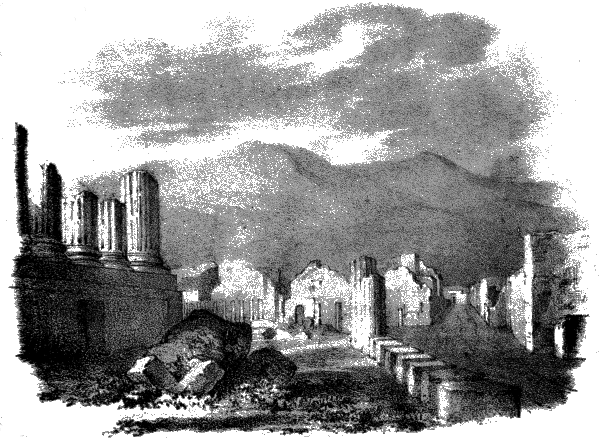
FORUM OF POMPEII.
The Forum was a very elegant building, and if you look in the plate, you will see a correct representation of what remains of it. The Forums of ancient cities were not mere marketplaces, although provisions and other commodities were offered in them for sale; but they also contained places fitted for meetings of the people, and other public uses. You will thus understand how it was that a place not larger than Pompeii had such an extensive Forum.
The names of the owners over the door of each house are still to be seen, and some of them are perfectly legible; and the colours of the paintings on the walls of the houses, are as fresh as if they had been painted yesterday. Some books have been found, but they are less perfect than those in Herculaneum, where a whole library has been discovered.
The wood of the houses in Herculaneum is astonishingly perfect if you just scrape off the surface, and some linen has been discovered, of which the texture could be distinctly seen. There were also some vessels full of almonds, chesnuts, and walnuts, in a fruiterer's shop, which preserved their form entire. A baker lived near neighbour to this fruiterer, and in his shop was a loaf with his stamp upon it, "ELERIS Q. CRANI RISER." Not far off was an apothecary's shop, in which was a box of pills, and a little roll of some kind of medicine ready to be cut into pills, with a jar of herbs and other medicines. Another shop contained some sauces and olives, which were quite moist. These curious relics have been sealed up in glass, and placed in the Museum of Naples.
There is a house in one of the streets of Pompeii, on one of the walls of which there has been scratched with some sharp-pointed instrument, a rude device like this:
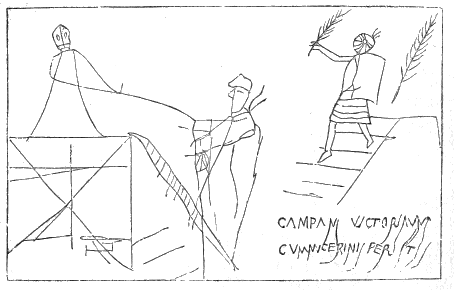
The letters in the corner, are, "Campani victoria una cum Nucerinis peristis." Campanians, you perished in the victory along with the Nucerians. This was a jest of some merry fellow making fun of the inhabitants of Nuceria, a neighbouring city, and of some other parts of Campania, over whom they had gained a victory in a squabble. We are told that the Nucerians, when they were dead beaten, went like cowards to the Emperor Nero, and laid their case before « 134 » him. He decided in their favour, and punished the Pompeians in what may seem a strange way to you,—he forbade them to have any amusements in their theatre for ten years. However, from what we know of the general disposition and habits of the ancient Greeks and Romans, this was a very severe punishment to them. From the scarcity of books, arising from their being copied by hand, instead of being printed, but few of them could spend their leisure time in reading, as so many of us do now; and in consequence of this, the theatre was to them at once the principal source of literary improvement and of amusement.
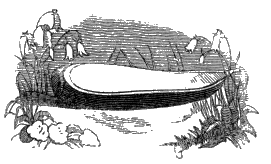
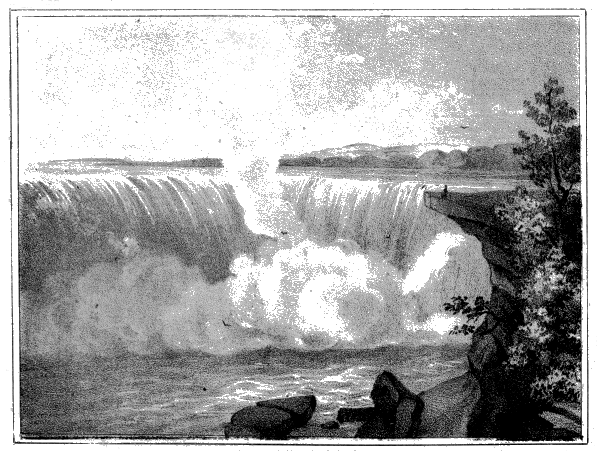
FALLS OF NIAGARA
The river Niagara runs out of Lake Erie into Lake Ontario, and you may see the direction it takes if you look in the map of North America. You may likewise observe that Lake Erie is connected with three other vast Lakes, and as its level is lower than theirs, the whole of their waters pass through it into the Niagara.
Nearly half way between the Lakes Erie and Ontario, where the river is about three quarters of a mile wide, it tumbles over a precipice of 160 feet in height. I shall try to describe to you what I saw when I visited this place; but I am quite certain I shall not be able to do justice to the scene. You must form your conceptions of « 136 » it rather from the bare facts I tell you respecting the mass of water and the height of the rocky ledge over which it falls.
As we travelled along from the town of Waterloo on a level road on the west bank, we saw the river gradually become wider till it was cut into two streams by a long narrow island some miles in length. The streams after passing the island, unite into one again, which continues its course as before.
There is a sullen unpretending majesty about this part of the river, as if it did not think it worth while to remind the traveller of the vast distance which its mighty waters have come, or of the stupendous scene to which they are travelling onward. There is nothing remarkable in its appearance, and that very circumstance, coupled with what we knew and what we shortly expected to see, made us full of intense feeling; and often and often did we put our ears to the ground to hear whether the « 137 » sound of the falls could reach us, and then remount and impatiently spur on our horses.
They say that the roar of the falls may be heard fifteen miles off when the wind is favourable. But the day we went, there was hardly any wind, and we were within six miles of the spot before we heard the sound.
At the distance of three miles the waters seemed fretful and discontented, as they approached what are called the rapids; we could see afar off "a silver cloud rising slowly into the sky—the everlasting incense of the waters," consisting of vapour, or rather fine spray, which is dashed out by the violence of the fall; and the roar seemed deeper and more tumultuous.
Within half a mile the rapids commence in good earnest. A rapid means the descent of a river down an inclined bed less sudden than a fall. The descent here in half a mile, is fifty feet. The bed is rocky, and the waters in rushing over it foam, and eddy, and tear along in all « 138 » directions in which they can possibly approach the awful precipice. The unity of the stream is broken by thousands of rocks and stones, and every part of its broad surface seems earnestly taken up with driving forward to the falls.
After we had enjoyed this scene awhile, we turned into the road again, and lost sight of the river till we reached a public-house, where we took refreshment and put up our horses.
The precipice which here breaks the course of the river, is divided into three parts by two large islands, and thus are formed three distinct falls. One of these is called the Great, or Horse Shoe Fall, from its peculiar shape, which you will see represented in the picture. This is by far the most extensive waterfall in the world, and is considered to be above a quarter of a mile in length. Then comes an island a thousand feet in width, called Goat Island, which has a great deal of wood growing on it. After that the Second Fall, not more than twenty feet in « 139 » width, then an island considerably smaller than the first; and lastly, Fort Scloper Fall, about a thousand feet wide, which joins the opposite bank of the river.
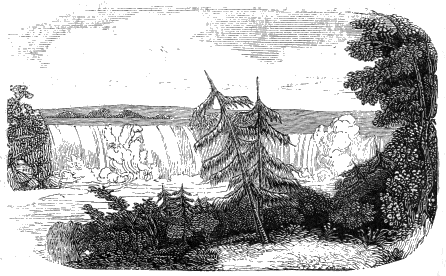
The quantity of water which descends every minute in the three falls, has been estimated to be about 700,000 tons.
Well, a path through the garden of the Inn at which we were, led us down a steep and thickly wooded bank, to a complete shelf of rock, about a foot in thickness, called the Table « 140 » Rock, which stands out over the river.[A] Since I was there this piece of rock has broken away and fallen into the stream. I was not at all surprised when I heard this intelligence, for I can assure you that though I am no coward, it did not seem very secure when I was standing on it, and if I had not been quite taken up with what I was looking at, I should not have staid there long. Here the whole scene on a sudden broke upon us. We were on a level with the top of the precipice, with the Horse Shoe Fall just opposite, and to our left, the Second, and Fort Scloper Falls.
[A] The print is copied by the kind permission of Messrs. Ackermann, from one of the elegant series of engravings of the Falls of Niagara, published by them.
In spite of the loud roar and the violent rushing of the waters, the scene altogether produced on us feelings of deep tranquillity and beauty. The portion of the river that falls over the Horse Shoe Fall, comes on in such an unbroken mass, as if nothing dared to oppose the « 141 » progress of a single drop of its water. Then the deep transparent green of the middle stream, showing at a little depth beneath its surface, shreds of milky foam, the beautiful cloud of fine spray ever decorated with a rich rainbow when the sun shines, and the thick woods of Goat Island, (the island that limits the Horse Shoe Fall,) are in such lovely harmony. Altogether, I should say that the scene from the Table Rock, is more remarkable for its beauty than its grandeur, though its grandeur is quite equal to that of anything I ever looked upon in my life.
We got down to the bottom of the falls by means of some rough steps which have been cut in the rock. As we stood on some large fragments which have fallen down from the cliff above, the roar fell with overpowering heaviness upon our ears, the fall was nearly hid from our eyes by the spray, and the river rushed past our feet in a terrible tumult of white foam. By getting along on the stones under the cliff, we went « 142 » in under the fall so as actually to be between the rock and the descending sheet of water. Your imagination must tell you better than I can, the character of what we then saw by the broken light that made its way through the descending mass of waters. We stopped there, overpowered by indescribable feelings, till we got wet through by the spray, and then went back to the inn, stored with recollections, which will be a feast for us as long as we live.
A traveller who visited the Falls in winter, adds some particulars which will be interesting to you.
"At the time of my visit," says he, "the wind drove the floating ice out of Lake Erie, with the drift wood of its tributary rivers, and these were constantly precipitated over the Falls, but we were not able to discover any vestiges of them in the eddies below. Immediately in front of the sheet of falling water, on the American side, there was also an enormous bank of snow, of nearly a hundred feet in height, which the power « 143 » of the sun had not been fierce enough to dissolve, and which, by giving an Icelandic character to the landscape, produced a fine effect. It appeared to me to owe its accumulation to the fallen particles of frozen spray.
"What has been said by Goldsmith, and repeated by others, respecting the destructive influence of the rapids above, to ducks and other water-fowl, is only an effect of the imagination. So far from being the case, the wild duck is often seen to swim down the rapid to the brink of the Falls, and then fly out, and repeat the descent, seeming to take a delight in the exercise. Neither are small land-birds affected on flying over the Falls, in the manner that has been stated. I observed the blue bird and the wren, which had already made their annual visit to the banks of the Niagara, frequently fly within one or two feet of the brink, apparently delighted with the gift of their wings, which enabled them to sport over such frightful precipices, without danger."
WONDERS OF THE SEA.
PARLEY TELLS ABOUT THE FROZEN OCEAN.
Your old friend Peter loves to talk about the sea. Ever since he was a child, he loved everything belonging to the sea, and when he was a young man he went many long voyages, and met with many strange adventures, on the sea. Perhaps he did not find it quite so delightful to be shut up in the narrow compass of a ship, during long voyages, as he dreamt he should in his childhood. But he does not now regret whatever labours or sufferings he may have endured, for the pleasure he finds in telling you of them.
But I do not intend here to spin you a yarn (as the sailors say) about myself, but merely to describe to you some of the wonderful things I have seen during my voyages, that you may love and admire them.
You have never seen the sea frozen over in the same manner as you have seen ponds and rivers in winter. The waters of the sea, everywhere, contain a large portion of salt, as you know from their taste, and this prevents them from freezing, except where it is very cold. It is only near the poles of the earth that the ocean freezes, and there are large masses of ice, both at the north and south poles, which are never thawed, but stand as stedfast as the everlasting hills of granite.
Icebergs are large bodies of ice filling the valleys between the high mountains in northern latitudes. Sometimes they get loosened from the places where they were formed, by parts of them thawing, in seasons which are less cold than usual, and then rush down towards the sea, where « 146 » they float about in all manner of fantastic and majestic forms.
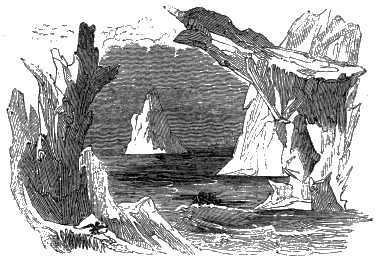
These icebergs are the creation of ages, and annually increase by the falling of snows, and of rain, which instantly freezes, and more than repairs the loss occasioned by the heat of the sun.
I must tell you a little about the way in which cold converts water into ice.
Everything in nature is expanded or increased in bulk by heat. You may see in a thermometer how the quick-silver or the coloured spirit rises in the tube, because it expands when the instrument « 147 » is in a warm place, and how it sinks in a cold place. It is just the same with solids and gases. This would seem to be a universal law of nature, if it were not for the single exception of water at the moment of its freezing. If water is cooled down to the freezing point, it will gradually diminish in bulk, but at the moment it turns into ice, it seems to spring outward, and increases considerably. In this way bottles are broken when the water in them freezes; and rocks are often split open in the same manner when the cracks in them contain water.
You have seen that ice does not sink in water, but floats upon the surface; this takes place, because from the circumstance which I have told you, a certain quantity of ice by weight, occupies more space than the same quantity of water. Now it is worth while for you to see how wisely this is arranged, as it respects our own climate and country; for if ice were to sink to the bottom, the lakes, and rivers, and ponds, would become solid masses of ice during winter, which « 148 » the sun's rays would never thoroughly thaw in summer, because, after the surface had been thawed, the rays would have to pass through the water to get at the ice at the bottom, and thus our climate would be rendered very much colder than it is at present, and perhaps the springs would not circulate, so that we should often suffer from scarcity of water.
But when the salt water freezes, the ice is very porous, almost like a honeycomb, so that it is much lighter than frozen fresh water, and is very buoyant upon the sea, and stands out boldly to a great height, as is represented in the cut of the Icebergs.
I will tell you of a perilous situation in which I was placed in my younger days, when I went a voyage to Greenland in a whale ship. It was at the end of the fishing season, and our ship was the last but one of the oil traders left in those seas; we had been very unsuccessful, having only taken five small whales, and we were anxious to amend our ill luck by tarrying « 149 » after all the other ships had sailed, in hopes of better success. We were gently sailing about in search of whales amidst the broken ice when there suddenly arose a rather brisk breeze, at which time our ship was situated between two icebergs,—one of them very high and resembling a lofty mountain, and the other considerably smaller.
Well, at the time the breeze sprung up, the large iceberg was to the windward of us, that is, on that side from whence the wind blew, and having a very large surface which caught the wind, it came sailing towards us very fast.
The vast bulk of this iceberg sheltered the smaller one, which was to the leeward of us, so that it did not move in the least, and we who were between the two, were completely becalmed. The ship was not advancing a knot in an hour, and we could do nothing whatever to help ourselves. We were in the greatest dismay, and could only consider the way in which we should meet our entire destruction. The larger mountain « 150 » of ice continued to bear down upon us, and in a few minutes our vessel was crushed between it and the smaller one, as if it had been put in a huge smith's vice.
Fortunately, however, for us, the two icebergs clung together, the greater one impelling the lesser one forward, and we thus had time to get out of the ship all our sea-chests, a large quantity of cordage, nearly all our provisions, and everything portable; but the smaller iceberg soon shifted round the large one and let our ship loose, which instantly sank, and we, being on the small iceberg, were left floating on the ocean with despair staring us in the face. Our despair, however, was soon put to flight, for we perceived a ship at a short distance, to which we made signal, and they came to our assistance.
But, now I come to a part of the event which I grieve to record.—The captain and crew of the vessel which came to our succour, seeing that we had no other alternative, thought they could make an easy prey of us, and before they would « 151 » consent to save us, required that we should give up to them all the things which we had been enabled to rescue from our wrecked ship!—In such circumstances you need not ask what we did,—life is sweet, it is said, and the pitiless prospect of the frozen regions around us, sharpened our appetite for the enjoyment of it, and we surrendered all but the clothes in which we stood.
Shall I tell you the place where these savages came from? No. I will only tell you that it lies in about 56 degrees North latitude, by 4½ West longitude; you may, if you please, find its name by looking in the map.


The Esquimaux live in the most northern parts of America, where there is hardly anything but ice and snow to be seen from year's end to year's end. They build their houses of « 153 » snow, and make their longest journeys in sledges upon ice along the sea-shore.
You, who have been used to a very different kind of life, may wonder how they can enjoy themselves, or even endure existence in such inhospitable regions. But I can assure you they love their native country so much, that they could by no means be happy out of it; and their pleasures are real pleasures, though they would not be pleasures to you. And thus you may learn that God wishes everybody to be happy, and enables them to be so if they choose to act according to the light which He has given them, and not be ever struggling for something which they cannot, and therefore ought not, to possess.
And not only do the natives of these frozen countries endure perpetual frost and snow, but good men have chosen to go and live among them for the purpose of teaching the natives the doctrines of Christianity. I shall relate to you a most interesting narrative of some of these men who were Moravians, and it will give you « 154 » a better notion of the character of these parts of the world, and of the sort of life men lead in them, than anything I could you of my own, for the story is extremely well told.
"Brother Samuel Liebisch was entrusted with the general care of the brethren's missions on the coast of Labrador, and the duties of his office required a visit to Okkak, the most northern of our settlements, and about one hundred and fifty English miles distant from Nain, the place where he resided. Brother William Turner being appointed to accompany him, they left Nain on March the 11th, 1782, early in the morning, with very clear weather, the stars shining with uncommon lustre. The sledge was driven by the baptized Esquimaux Mark, and another sledge with Esquimaux joined company.
"An Esquimaux sledge is drawn by a species of dogs, not unlike a wolf in shape. Like them, they never bark, but howl disagreeably. They are kept by the Esquimaux in greater or larger packs or teams, in proportion to the affluence of « 155 » the master. They quietly submit to be harnessed for their work, and are treated with little mercy by the heathen Esquimaux, who make them do hard duty for the small quantity of food they allow them. This chiefly consists in offal, old skins, entrails, such parts of whale-flesh as are unfit for other use, rotten whale-fins, &c., and if they are not provided with this kind of dogs' meat, they leave them to go and seek dead fish or muscles upon the beach.
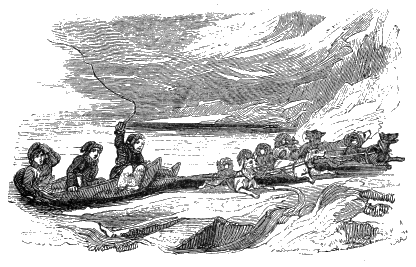
"When pinched with hunger they will swallow « 156 » almost anything, and on a journey it is necessary to secure the harness within the snow-house over night, lest by devouring it, they should render it impossible to proceed in the morning. When the travellers arrive at their night-quarters, and the dogs are unharnessed, they are left to burrow in the snow, where they please, and in the morning are sure to come at their driver's call, when they receive some food. Their strength and speed, even with an hungry stomach, is astonishing. In fastening them to the sledge, care is taken not to let them go abreast. They are tied by separate thongs, of unequal lengths, to an horizontal bar on the fore-part of the sledge; an old knowing one leads the way, running ten or twenty paces ahead, directed by the driver's whip, which is of great length, and can be well managed only by an Esquimaux. The other dogs follow like a flock of sheep. If one of them receives a lash, he generally bites his neighbour, and the bite goes round.
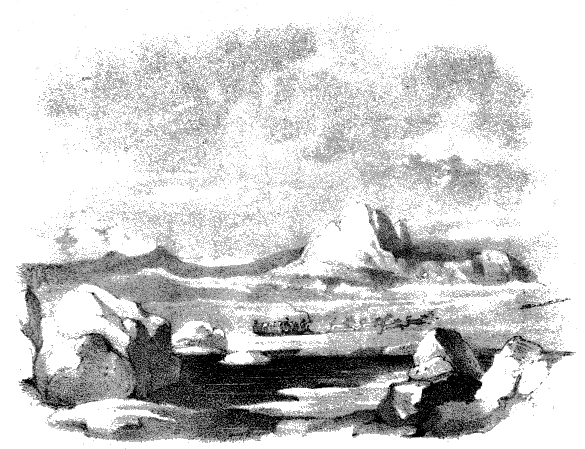
ESCAPE ON THE ICE
"To return to our travellers: the two sledges contained five men, one woman, and a child. All were in good spirits, and appearances being much in their favour, they hoped to reach Okkak in safety in two or three days. The tract over the frozen sea was in the best possible order, and they went with ease at the rate of six or seven miles an hour. After they had passed the islands in the bay of Nain, they kept at a considerable distance from the coast, both to gain the smoothest part of the ice, and to weather the high rocky promontory of Kiglapeit.
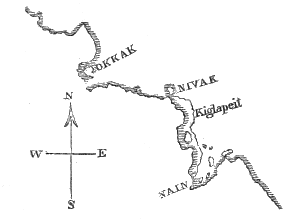
"About eight o'clock they met a sledge with « 158 » Esquimaux turning in from the sea. After the usual salutation, the Esquimaux alighting, held some conversation, as is their general practice, the result of which was, that some hints were thrown out by the strange Esquimaux, that it might be better to return. However, as the missionaries saw no reason whatever for it, and only suspected that the Esquimaux wished to enjoy the company of their friends a little longer, they proceeded.
"After some time their own Esquimaux hinted that there was a ground swell under the ice. It was then hardly perceptible, except on lying down and applying the ear close to the ice, when a hollow disagreeable grating and roaring noise was heard, as if ascending from the abyss. The weather remained clear, except towards the east, where a bank of light clouds appeared, interspersed with some dark streaks. But the wind being strong from the North-west, nothing less than a sudden change of weather was expected.
"The sun had now reached its height, and « 159 » there was as yet little or no alteration in the appearance of the sky. But the motion of the sea under the ice had grown more perceptible, so as rather to alarm the travellers, and they began to think it prudent to keep closer to the shore. The ice had cracks and large fissures in many places, some of which formed chasms of one or two feet wide; but as they are not uncommon even in its best state, and the dogs easily leap over them, the sledge following without danger, they are only terrible to new comers.
"As soon as the sun declined towards the west, the wind increased and rose to a storm, the bank of clouds from the east began to ascend, and the dark streaks to put themselves in motion against the wind. The snow was violently driven about by partial whirlwinds, both on the ice, and from off the peaks of the high mountains and filled the air. At the same time the ground swell had increased so much, that its effect upon the ice became very extraordinary and alarming. The sledges, instead of gliding « 160 » along smoothly upon an even surface, sometimes ran with violence after the dogs, and shortly after seemed with difficulty to ascend the rising hill, for the elasticity of so vast a body of ice, of many leagues square, supported by a troubled sea, though in some places three or four yards in thickness, would, in some degree, occasion an undulatory motion not unlike that of a sheet of paper accommodating itself to the surface of a rippling stream. Noises were now likewise distinctly heard in many directions, like the report of cannon, owing to the bursting of the ice at some distance.
"The Esquimaux therefore drove with all haste towards the shore, intending to take up their night-quarters on the south side of the Nivak. But as it plainly appeared that the ice would break and disperse in the open sea, Mark advised to push forward to the north of the Nivak, from whence he hoped the track to Okkak might still remain entire.
"To this proposal the company agreed, but « 161 » when the sledges approached the coast, the prospect before them was truly terrific. The ice having broken loose from the rocks, was forced up and down, grinding and breaking into a thousand pieces against the precipices, with a tremendous noise, which added to the raging of the wind, and the snow driving about in the air, deprived the travellers almost of the power of hearing and seeing anything distinctly.
"To make the land at any risk, was now the only hope left, but it was with the utmost difficulty the frightened dogs could be forced forward, the whole body of ice sinking frequently below the surface of the rocks, then rising above it. As the only moment to land was that, when it gained the level of the coast, the attempt was extremely nice and hazardous. However, by God's mercy, it succeeded; both sledges gained the shore, and were drawn up the beach with much difficulty.
"The travellers had hardly time to reflect with gratitude to God on their safety, when that « 162 » part of the ice from which they had just now made good their landing burst asunder, and the water forcing itself from below, covered and precipitated it into the sea. In an instant, as if by a signal given, the whole mass of ice, extending for several miles from the coast, and as far as the eye could reach, began to burst and be overwhelmed by the immense waves towering above.
"The sight was tremendous and awfully grand; the large fields of ice, raising themselves out of the water, striking against each other, and plunging into the deep with a violence not to be described, and a noise like the discharge of innumerable batteries of heavy guns. The darkness of the night, the roaring of the wind and sea, and the dashing of the waves and ice against the rocks, filled the travellers with sensations of awe and horror, so as almost to deprive them of the power of utterance. They stood overwhelmed with astonishment at their miraculous escape, and even « 163 » the heathen Esquimaux expressed gratitude to God for their deliverance.
"The Esquimaux now began to build a snow-house, about thirty paces from the beach; but before they had finished their work, the waves reached the place where the sledges were secured, and they were with difficulty saved from being washed into the sea.
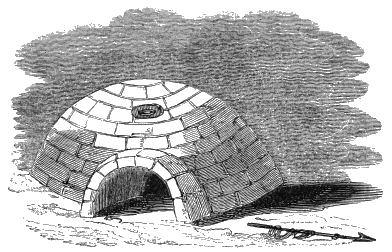
"About nine o'clock all of them crept into the snow-house, thanking God for this place of « 164 » refuge; for the wind was piercingly cold and so violent, that it required great strength to be able to stand against it.
"Before they entered this habitation, they could not help once more turning to the sea, which was now free from ice, and beheld with horror, mingled with gratitude, the enormous waves, driving furiously before the wind, like huge castles, and approaching the shore, where with dreadful noise, they dashed against the rocks, foaming and filling the air with the spray. The whole company now got their supper, and having sung an evening hymn in the Esquimaux language, lay down to rest about ten o'clock. They lay so close, that if any one stirred, his neighbours were roused by it.
"The Esquimaux were soon fast asleep, but brother Liebisch could not get any rest, partly on account of the dreadful roaring of the wind and sea, and partly owing to a sore throat, which gave him great pain. Both missionaries were also much engaged in their minds in contemplating « 165 » the dangerous situations into which they had been brought, and amidst all thankfulness for their great deliverance from immediate death, could not but cry unto their Heavenly Father for his help in this time of need.
"The wakefulness of the missionaries proved the deliverance of the whole party from sudden destruction. About two o'clock in the morning, brother Liebisch perceived some salt water to drop from the roof of the snow-house upon his lips. Though rather alarmed on tasting the salt, which could not proceed from a common spray, he kept quiet, till the same dropping being more frequently repeated, just as he was about to give the alarm, on a sudden a tremendous surf broke close to the house, discharging a quantity of water into it; a second soon followed, and carried away the slab of snow placed as a door before the entrance. The missionaries immediately called aloud to the sleeping Esquimaux, to rise and quit the place. They jumped up in an instant, one of them with a large knife « 166 » cut a passage through the side of the house, and each seizing some part of the baggage, it was thrown out upon a higher part of the beach, brother Turner assisting the Esquimaux. Brother Liebisch and the woman and child fled to a neighbouring eminence. The latter were wrapt up by the Esquimaux in a large skin, and the former took shelter behind a rock, for it was impossible to stand against the wind, snow, and sleet. Scarcely had the company retreated to the eminence when an enormous wave carried away the whole house, but nothing of consequence was lost."

"They now found themselves a second time delivered from the most imminent danger of death; but the remaining part of the night, before the Esquimaux could seek and find another more safe place for a snow-house, were hours of great trial to mind and body, and filled every one with painful reflections. Before the day dawned, the Esquimaux cut a hole into a large drift of snow, to screen the woman and child, and the two missionaries.
"Brother Liebisch, however, could not bear the closeness of the air, and was obliged to sit down at the entrance, where the Esquimaux « 168 » covered him with skins, to keep him warm, as the pain in his throat was very great.
"As soon as it was light, they built another snow-house, and miserable as such an accommodation is at all times, they were glad and thankful to creep into it. It was about eight feet square and six or seven feet high. They now congratulated each other on their deliverance, but found themselves in a very bad plight.
"The missionaries had taken but a small stock of provisions with them, merely sufficient for the short journey to Okkak. Joel, his wife and child, and Kassigiak, the sorcerer, had nothing at all. They were obliged, therefore, to divide the small stock into daily portions, especially as there appeared no hopes of soon quitting this place and reaching any dwellings. Only two ways were left for this purpose, either to attempt the land passage across the wild and unfrequented mountain Kiglapeit, or wait for a new ice track over the sea, which it might require much time to form; they therefore « 169 » resolved to serve out no more than a biscuit and a half per day.
"But as this would not by any means satisfy an Esquimaux's stomach, the missionaries offered to give one of their dogs to be killed for them, on condition, that in case distress obliged them to resort again to that expedient, the next dog killed should be one of the Esquimaux's team. They replied that they should be glad of it, if they had a kettle to boil the flesh in, but as that was not the case, they must even suffer hunger, for they could not, even now, eat dogs' flesh in its raw state. The missionaries now remained in the snow-house, and every day endeavoured to boil so much water over their lamp, as might serve for two dishes of coffee a-piece. Through mercy, they were preserved in good health, and brother Liebisch quite unexpectedly recovered on the first day of his sore throat. The Esquimaux also kept up their spirits, and even the rough heathen Kassigiak declared, that it was proper to be thankful that they were still alive, « 170 » adding, that if they had remained a very little longer upon the ice yesterday, all their bones would have been broken to pieces in a short time. He had, however, his heels frozen, and suffered considerable pain. In the evening, the missionaries sung an hymn with the Esquimaux, and continued to do it every morning and evening. God was present with them, and comforted their hearts by his peace.
"Towards noon of the thirteenth, the weather cleared up and the sea was seen, as far as the eye could reach, quite freed from ice. Mark and Joel went up the hills to reconnoitre, and returned with the disagreeable news that not a morsel of ice was to be seen even from thence, in any direction, and that it had even been forced away from the coast at Nuasornak. They were, therefore, of opinion, that we could do nothing but force our way across the mountain Kiglapeit.
"To-day Kassigiak complained much of hunger, probably to obtain from the missionaries « 171 » a larger portion than the common allowance. They represented to him, that they had no more themselves, and reproved him for his impatience. Whenever the victuals were distributed, he always swallowed his portion very greedily, and put out his hand for what he saw the missionaries had left, but was easily kept from any further attempt by serious reproof.
"The Esquimaux eat to-day an old sack made of fish-skin, which proved indeed a dry and miserable dish. While they were at this singular meal, they kept repeating, in a low humming tone, 'you was a sack but a little while ago, and now you are food for us.' Towards evening some flakes of ice were discovered driving towards the coast, and on the fourteenth in the morning, the sea was covered with them. But the weather was again very strong, and the Esquimaux could not quit the snow-house, which made them very low spirited and melancholy. Kassigiak suggested, that it would be well to attempt to make good weather, by which he « 172 » meant to practise his art, as a sorcerer, to make the weather good.
"The missionaries opposed it, and told him that his heathenish practices were of no use, but that the weather would become favourable as soon as it should please God. Kassigiak then asked, whether Jesus could make good weather. He was told, that to Jesus was given all power in heaven and earth; upon which he demanded, that he should be applied to. Another time he said, I shall tell my countrymen at Seglek. The missionaries replied. 'Tell them that in the midst of this affliction, we placed our only hope and trust in Jesus Christ our Saviour, who loves all mankind, and has shed his blood to redeem them from eternal misery.'
"To-day the Esquimaux began to eat an old, filthy, and worn-out skin, which had served them for a mattress.
"On the fifteenth the weather continued extremely boisterous, and the Esquimaux appeared every now and then to sink under disappointment. « 173 » But they possess one good quality, namely, a power of going to sleep when they please, and, if need be, they will sleep for days and nights together.
"In the evening the sky became clear, and their hopes revived. Mark and Joel went out to reconnoitre, and brought word that the ice had acquired a considerable degree of solidity, and might soon be fit for use. The poor dogs had, meanwhile, fasted for nearly four days, but now in the prospect of a speedy release, the missionaries allowed to each a few morsels of food. The temperature of the air having been rather mild, it occasioned a new source of distress, for by the warm exhalations of the inhabitants, the roof of the snow-house got to be in a melting state; which occasioned a continual dropping, and by degrees made every thing soaking wet. The missionaries report, that they considered this the greatest hardship they had to endure, for they had not a dry thread about them, nor a dry place to lie down in.
"On the sixteenth early, the sky cleared, but the fine particles of snow were driven about like clouds. Joel and Kassigiak resolved to pursue their journey to Okkak, by the way of Nuasornak, and set out, with the wind and snow full in their faces. Mark could not resolve to proceed farther north, because, in his opinion, the violence of the wind had driven the ice off the coast at Tikkerasuk, so as to render it impossible to land; but he thought he might yet proceed to the south with safety, and get round Kiglapeit. The missionaries endeavoured to persuade him to follow the above mentioned company to Okkak, but it was in vain; and they did not feel at liberty to insist upon it, not being sufficiently acquainted with the circumstances. Their present distress dictated the necessity of venturing something to reach the habitations of men, and yet they were rather afraid of passing over the newly frozen sea under Kiglapeit, and could not immediately determine what to do. Brother Turner therefore went again with « 175 » Mark to examine the ice, and both seemed satisfied that it would hold. They therefore came at last to a resolution to return to Nain.
"On the seventeenth, the wind had considerably increased, with heavy showers of snow and sleet, but they set off at half-past ten o'clock in the afternoon. Mark ran all the way round Kiglapeit, before the sledge, that he might find a good track, and about one o'clock, they were quite out of danger and reached the bay. Here they found a good track upon smooth ice, made a meal of the remnant of their provisions, and got some warm coffee. Thus refreshed, they resolved to proceed without stopping, till they reached Nain, where they arrived at twelve o'clock at night.
"The brethren at Nain rejoiced exceedingly to see them return, for by several hints of the Esquimaux, who first met them going out to sea, and who then in their own obscure way, had endeavoured to warn them of their danger « 176 » of the ground-swell, but had not been attended to, their fellow-missionaries, and especially their wives, had been much terrified. One of these Esquimaux, whose wife had made some article of dress for brother Liebisch, whom they called Samuel, addressed her in the following manner:—'I should be glad of the payment for my wife's work.' 'Wait a little,' answered sister Liebisch, 'and when my husband returns he will settle with you, for I am unacquainted with the bargain made between you.' 'Samuel and William,' replied the Esquimaux, 'will not return any more to Nain.' 'How not return! what makes you say so?' After some pause the Esquimaux replied in a low tone, 'Samuel and William are no more! all their bones are broken, and in the stomachs of the sharks.'
"Terrified at this alarming account, sister Liebisch called in the rest of the family, and the Esquimaux was examined as to his meaning; but his answers were little less obscure. He seemed so certain of the destruction of the missionaries, « 177 » that he was with difficulty prevailed on to wait some time for their return. He could not believe that they could have escaped the effects of so furious a tempest, considering the course they were taking.
"It may easily be conceived, with what gratitude to God the whole family at Nain bid them welcome. During the storm, they had considered with some dread, what might be the fate of their brethren, though at Nain its violence was not felt so much as on a coast, unprotected by any islands. Added to this, the hints of the Esquimaux had considerably increased their apprehensions for their safety, and their fears began to get the better of their hopes. All therefore joined most fervently in praise and thanksgiving to God, for this signal deliverance."
It seems strange that the largest animal in nature should live in these regions, where you would think everything must be starved by the cold. But so it is, and it should lead you to reflect, how wonderfully the principle which animates living beings, by the outward form and constitution which it gives to the bodies of animals, adapts them to support the various circumstances in which they are placed.
There are many kinds of whale which all agree in these particulars. They are very much larger than any other creatures existing; they live in the sea and yet suckle their young with milk, and have warm blood and lungs like land « 179 » animals, so that they can only breathe by putting their heads above water. Some people have doubted whether it was proper to call the whale a fish, but on the whole it is certainly more like fishes than it is like any other of the great divisions of animals, seeing that it swims with fins, and cannot live out of the water.
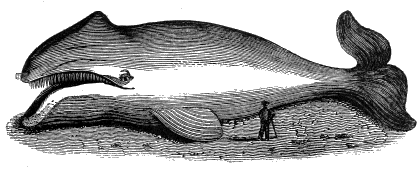
The Greenland whale (naturalists call it Balena Mysticetus,) is the most important of the varieties, as it is the one which produces train oil in the largest quantities, and whalebone. In common with all the others, it is a most awkward looking creature. Here is a picture of one. Its usual length is from 40 to 60 feet; and « 180 » the circumference of its body about 40. It not unfrequently weighs 60 or 70 tons, which is more than the weight of 180 fat oxen.
The tail is commonly about 6 feet long, and 25 feet wide. It lies flat upon the water, and is what the creature principally uses in swimming, for the fins near the head appear to be used merely to keep the body steady in the water. It is also a weapon of defence, and possesses prodigious strength, as you shall hear by and by.
The inside of the mouth is, perhaps, the most wonderful part of the whale, both from its size and construction. I was once in one, which was 15 feet in length and 7 feet wide.
It is from the mouth that the Whalebone, as it is called, comes. The jaws are not furnished with teeth, but in their place there is something which forms a curious sort of shrimp-trap, which I will describe to you. The whalebone is ranged along in blades upon the jaws, like the laths of a Venetian blind, and the inner edge of each blade « 181 » is furnished with a fringe of fibrous stuff almost like hair.
The natural position of the whale's mouth seems to be open, and it mostly swims along or lies near the surface, with its lower jaw hanging down. Little fish and insects, most of them of the smallest size, thus come in contact with the smooth edge of the blades of bone, slip between them, and become entangled in the hairy fringe of the inner edge, so that they can never get out again. When the whale thinks he has got enough in his mouth, he immediately raises his enormous lower jaw and swallows. One of his mouthfuls must often consist of millions of living creatures, respecting the kinds of which I shall have something to tell you in a future page.
I told you that he was obliged to rise to the surface of the water to breathe. You would like to see him ascend for this purpose, and snort out a jet of thick vapour to the height of twenty feet, or more, and making such a « 182 » noise, as may be heard at a distance of several miles.
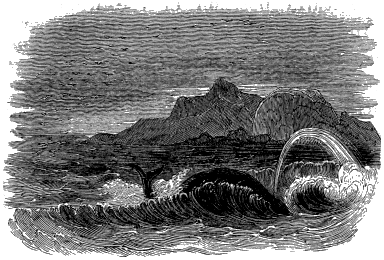
Under the skin, all over the body, there is a covering of yellowish fat of about a foot thick, which keeps the animal warm, answering the same purpose as the fur does on land animals. It is necessary, because the whale is not cold in the inside like other fish, but has warm, red blood, which is of a higher temperature even than that of a human being. This is another circumstance which becomes the more remarkable from the cold climate in which he lives.
This fat is generally called blubber, and is what the oil comes from. When first it is taken from the whale, it has not the least unpleasant smell, and it is not till the cargo is unstowed that a whale ship is at all disagreeable.
The largest sort of whale is called the razor back, from a ridge that runs along his back. They are often 100 feet in length. I never saw one of these taken, but the sailors told me that they were very difficult to come near, and after all, not worth the trouble of killing, for they have very little blubber.
Then there is the Cachalot, or Sperm Whale, which is smaller, and much more slender than the common whale. It has teeth, and is of a very quarrelsome temper. It often fights with its own kind, and I have seen several of them which had been wounded in the jaws, and made blind by such conflicts. It is from the head of this animal that spermaceti is obtained.
A number of vessels are sent out every year to catch these great creatures, and this is the way « 184 » in which they manage their work. Every vessel is furnished with five or six boats which are hung on the sides of the vessel in such a way as to be easily lowered into the water on the shortest notice. One or two of the boats are usually kept upon the look out, in each of which there is a harpoon attached to a rope above 700 feet in length, and about as thick as a man's thumb. This is the shape of the harpoon.

When they see a whale showing himself above the surface of the water, the man who is to throw the harpoon, stations himself at the bow, and the rest pull away as fast as they are able till they approach the whale as near as possible, and this is often to within a very short distance in consequence of his being slower of hearing than most other animals.
The harpooner then throws the harpoon with all his might, and if he is lucky, it goes through « 185 » the poor creature's skin and blubber, into his flesh. The moment he feels the wound, he mostly sinks to a great depth, and drags out the line which is carefully coiled at the bottom of the boat, at a tremendous rate. One man stands by with a mop to keep the edge of the boat over which the rope runs constantly wet, lest the friction should set the boat on fire, and another holds a hatchet ready to chop it in two in case it should become entangled. If it goes out smoothly, they add lines as long as they are necessary: and on one occasion, for a whale which was very refractory, Captain Scoresby actually joined together three miles and three quarters of rope, the weight of which was nearly two tons! Was not this a great fishing-line?
As soon as the whale is struck, they hoist a flag, and the men who are in the ship, and constantly upon the look out, immediately come to their assistance. If the signal is made when any of them are asleep, up they come with their clothes under their arms, and dress afterwards « 186 » as they can, for not a moment is to be lost. This is no joke, when the cold is more than thirty degrees below the freezing point.

However, they are obliged to go; and as many boats as there may be, then watch anxiously for the re-appearance of the whale on the surface. As soon as he shows himself, the men of the other boats immediately strike their harpoons into him, and so secure him till he is faint from loss of blood, and at last comes up to the surface, spouting out blood mixed with the vapour from his nostrils. They then despatch him with an instrument called a lance, and the great carcass rolls over upon its back. It is afterwards lashed by strong ropes to the side of the ship, and the blubber is cut up into lumps of convenient size, and stowed in casks.
It occasionally happens, after the harpooner has thrown his weapon, that the creature in « 187 » agony, flaps about his tail with tremendous violence before he goes down. Many boats have been upset in this manner, and Captain Scoresby relates an instance of a boat being dashed completely in two.
Some people have thought the whale a very stupid creature, but there does not seem much ground for this notion, though we can never be in a condition to see much of its instinctive wisdom. As far as we can see, it is the very best thing it could do when struck by the harpoon, to go downwards as it does; and this seems to prove that it has quite its share of intelligence; and it is still more remarkable, that if a mass of ice be near when it is pursued, either before or after it has been struck, it gets under it as quickly as possible, and often thus baffles its pursuers.
But the most interesting thing in the character of the whale is, its extreme love for its offspring, and a cruel use is often made by the whalers of this beautiful disposition. They often strike a cub or sucker, as they call the young « 188 » whales, which would not be worth taking itself, because they know its mother will instantly expose herself to an attack in its defence. You shall hear what Captain Scoresby says on this, "When the young whale is struck, its mother joins it at the surface of the water, whenever it has occasion to rise for respiration; encourages it to swim off; assists its flight, by taking it under her fin; and seldom deserts it while life remains. She is then dangerous to approach; but affords frequent opportunities for attack. She loses all regard for her own safety, in anxiety for the preservation of her young;—dashes through the midst of her enemies;—despises the danger that threatens her;—and even voluntarily remains with her offspring, after various attacks on herself from the harpoons of the fishers. In June 1811, one of my harpooners struck a sucker, with the hope of its leading to the capture of the mother. Presently she arose close by the 'fast-boat;' and seizing the young one, dragged about a hundred fathoms of line « 189 » out of the boat with remarkable force and velocity. Again she arose to the surface; darted furiously to and fro; frequently stopped short, or suddenly changed her direction, and gave every possible intimation of extreme agony. For a length of time she continued thus to act, though closely pursued by the boats; and, inspired with courage and resolution by her concern for her offspring, seemed regardless of the danger which surrounded her. At length, one of the boats approached so near, that a harpoon was hove at her. It hit, but did not attach itself. A second harpoon was struck; this also failed to penetrate: but a third was more effectual, and held. Still she did not attempt to escape, but allowed other boats to approach; so that, in a few minutes, three more harpoons were fastened; and, in the course of an hour afterwards, she was killed."
To you, my little friends, who have always lived in a climate in which it seems as if the wind changed, and it became sun-shiny or cloudy, wet or dry, cold or hot, without any law or regularity, it is something strange to hear of places where the inhabitants know almost to a day that the wind will blow constantly in one direction during so many months in the year, and constantly in some other direction during the rest: and where, with equal certainty, they know when to expect rain and when fine weather.
The truth is, our changeable weather is under the influence of laws quite as certain and fixed as their uniform weather is, only that there are « 191 » more partial causes operating in our climate, so that the effects are not so strictly periodical. We know as little about the way in which the laws operate in one case, as in the other.
The winds that always blow in one direction are called the Trade Winds, and those which blow in one direction regularly during a certain portion of the year, are called monsoons. They make navigation in some parts of the ocean, very certain, and you cannot think how odd it seems to a young sailor the first time he sails in them. He leads then a lazy sort of life; there is no tacking about, but day after day he has nothing to do but just such things as might be done on land.
When the sailors of Columbus first found themselves in the Trade Wind blowing from the eastward, having sailed before it for many days, they gave themselves up to despair, because they thought they should never be able to make their way back against it to their dear native country. They did not know that it would by and by blow quite as certainly in another direction.
These uniform winds blow only within a certain distance of the equator, and the cause of them is this. The heat of the climate there occasions the air next to the surface of the earth to be always ascending, and other air rushes in from other parts of the world to supply its place. The motion of the earth upon its axis operates with this, by bringing the parts of its surface successively in contact with any certain point in the atmosphere, which does not revolve so rapidly as the earth itself, and a fixed direction is thus given to the wind.
But it is still much more dull to find one's self in a calm on a tropical sea. Only imagine to yourselves a stagnant and shoreless sea, often with unsightly masses of sea-weed floating on it, a sky constantly of a gloomy-looking red, and nothing to be seen day after day except this sky and sea; insupportable thirst and bad water to quench it, and the ship all the time rocking to and fro with a nasty dull motion, and the ropes and sails idly flapping against the mast and yards.
But though I have seen and felt all this, I cannot describe it to you so well as the poet, so I will give you his words.
Well! one morning when we were only a few leagues off the West Coast of Africa, to the South of the Cape Verd Islands, we thought we were going to have just such a calm as the poet has described. There had been a violent storm during the night, but every breath of wind had died away, and left a long sleepy swell upon the sea.
About nine o'clock, we noticed a cloud rising, or rather seeming to form, at some distance from us, and just below it a white spot of foam appeared on the surface of the water, and the waves raged over a little round space in a way that made me feel I don't know how, for I had never seen such a thing before. The cloud grew blacker and blacker, and presently seemed to move down towards the sea and swell out in the same direction, as if to provoke the waves below, which seemed straining up towards it.
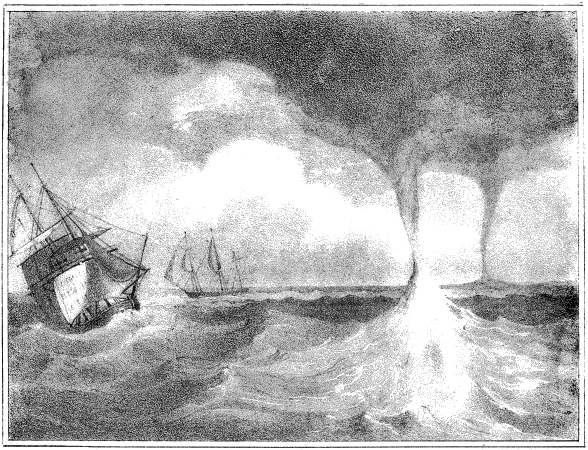
WATER SPOUTS
There suddenly seemed to grow out of the middle of the spot of waves, a complete pillar of water of a tapering shape, and at the same moment the lower part of the cloud seemed to condense and turn to water, and shot downwards in a cone to meet it. They united and formed one pillar, almost as distinct as if it had been of ice instead of water. You will see a correct representation of this in the picture.
The size at the base must have been very large, not less than 250 feet in diameter, but it tapered off so much that at the middle it was not more than three or four feet. Above the middle it increased in size, and its solidity seemed to get gradually less till it ended in a great black cloud. Its height might have been about 700 feet.
Its form changed considerably. It generally seemed as if it was composed of water sucked upwards in a spiral direction, and looked almost like a great cable; but now and then it looked like a simple hollow tube.
Sometimes it inclined a little one way, and then another; and sometimes it was very considerably bent, and then suddenly straightened itself again.
When the ship was nearest to it, we heard a noise from it like the rushing of a waterfall, and before it was over, heavy rain came on with lightning, but no thunder. The wind all the time was very unsteady, though it was not violent.
While we were looking at it, two smaller ones formed at some distance under very nearly the same circumstances. One of them stood quite still for some seconds, and then disappeared; but the other moved steadily on in a straight line, for several minutes.
The great one continued moving also very « 197 » slowly for nearly half an hour, and then seemed to snap in two, and one half sank rapidly into the sea, as if it had been unhooked from above, and the other half remained hanging from the cloud for some time, and then curled upwards and disappeared, throwing down a heavy torrent of rain.
I have seen many water-spouts since, in my voyages over the great ocean, but have never been so struck with the appearance of any one as of this.
There is a common notion that a cannon fired at a water-spout, will disperse it by making a great concussion of the air; but I do not think that this is true, unless the water-spout be very small. At all events, it was not true in this case, for we fired right at the large one several times, and it took no effect except in splashing the water about as the ball went through.
It is also generally imagined that they are very dangerous to ships, and if they come close, that they throw such a quantity of water into them as to sink them. I have somewhere read « 198 » an account of a vessel having once been put in danger by one off the Coast of Guinea, and two or three of the men being washed overboard, and I once saw the sails and deck of a vessel, made very wet by a small one, myself. But my own opinion is, that there is not much to be dreaded from them, for they are not a solid mass of water, but merely condensed vapour in the form of a tube, with a hollow space in the middle. And I think if you were right under one of them, it would be no worse than rain descending in very large drops.
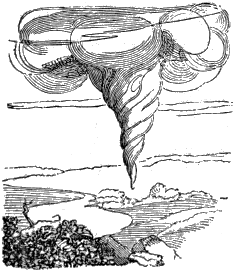
Once I saw a much smaller water-spout on land. It was a gusty, cloudy day, and the wind had changed several times, when a dark cloud at some distance from where I was, extended downwards till it came nearly to a point.
It seemed to reach about three-fourths of the distance from the cloud to the ground, and moved along slowly for about ten minutes. When I afterwards made inquiry of the people over whose houses it passed, they told me that it had let fall in its progress a tremendous quantity of rain, so as considerably to injure several houses.
HOW PARLEY SUPPOSES WATER-SPOUTS TO BE CAUSED.
I suppose you would now like me to tell you how water-spouts are caused. I wish I could, for your sakes; and, besides, I should very much like to know myself. I have, however, a tolerable guess upon the subject, and that I will tell you of.
I dare say you have often seen little eddies of wind which take up dust, straw, and other light substances, and carry them up, twirling them round in a spiral direction like a cork-screw.
When these occur on a larger scale, they are called whirlwinds, and are often very destructive in their effects, unroofing houses, and doing various other mischief. They are sometimes occasioned by draughts of air being disturbed in their course by mountains or hills, and meeting each other. But the largest are caused by two or more currents of wind, produced by what ordinarily influences the direction of the wind, meeting from different quarters, and then twisting round each other just as two strings, with weights at their ends, would do if you swung them forcibly together so as to meet about the middle.
A whirlwind occurred some years ago, near where I was living; it lasted about ten minutes, and produced some very curious effects. It first met with a milk-maid, who was carrying a pail of milk upon her head, and tore off her bonnet along with the pail, and carried both to a great distance, where they were not found till some days afterwards. It next twisted a wagon in pieces, and blew most of the fragments over a « 201 » wall; it unroofed a house, and carried some of the tiles to a great distance; next it dashed through the window of the room where I was sitting, swept all the ornaments off the mantelpiece, and made strange havock with some of the furniture. It then passed on to a neighbouring park, where it tore up several trees. The wind had not been extremely violent before, neither was it immediately afterwards.
Suppose a cloud happens to be exactly in the point of union of two currents of wind, meeting as they did in this whirlwind, it then becomes twisted in along with them, and partially condensed; and if it is over the land, this is all that seems necessary to form the water-spout.
And if it happens to be over the sea, the wind, as it eddies round, works up the waves into a ferment, and much spray and foam is produced, which is twisted in with the whirlwind in the same manner as the cloud, and carried upwards to meet it.
Whether this is just the way in which the « 202 » thing takes place, or not, it is pretty certain that the water-spout is caused by the meeting of winds from various quarters, from what Dr. Franklin tells us in one of his letters which I read the other day. He says that a sailor informed him that he was in one of three vessels which chanced to be placed as at the three corners of a triangle; a water-spout was formed between them which seemed to be to the leeward of each of them.
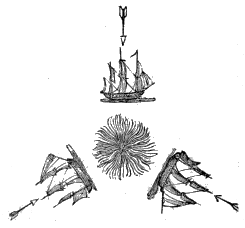
The cut will enable you to understand what I mean. The star in the middle represents the water-spout, and the three arrows the directions in which each of the three vessels found the wind come, which shows that three diverse currents of air all set towards the water-spout.
When we were sailing through the Pacific Ocean, I saw a great many coral reefs and islands; and perhaps there is hardly one of the wonderful things which I have seen in my travels, that I remember with more pleasure, or love more to think about, so I shall be glad to tell you all I know of them.
You are acquainted with the appearance of Coral, as you have often seen pieces of it in cabinets, and employed as ornaments; and you therefore know that it always abounds with little holes, but its form, and the shape of these holes, vary considerably. Some of it occurs in branches, like the branches of trees, and in consequence « 204 » of this, and because it was known to increase in size from time to time, it was taken for a marine plant, before its nature was fully investigated. The openings in this sort are placed in the form of stars, as you will see in this little piece of one of the branches magnified.
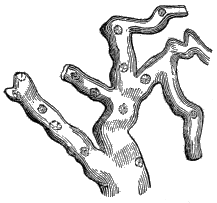 |
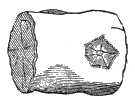 |
Sometimes it is in large roundish masses, called brain stones, from its resemblance to the brain of an animal; the openings are then long holes placed in two rows between high ridges, like this.
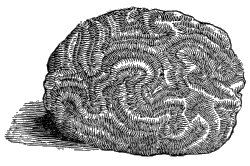
And a third form is found consisting of thin pieces, thinner than writing paper, placed on edge, spreading out from a centre, or from a line « 205 » down the middle of a long strip, and the openings are then plain deep furrows, running from the middle to the outside.
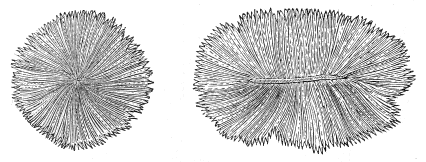
There is also the precious red Coral of which beads and other trinkets are made, found principally in the Mediterranean Sea, and several other sorts, more or less rare. But what I have described to you are the commonest.
This curious substance extends over hundreds of miles in various parts of the Tropical Seas, in islands of different forms. But before I describe these to you, I must tell you what is known respecting the little animals by which it is manufactured, for it is proved to be the work of certain kinds of the little creatures called Polypes.
THE CORAL-MAKING POLYPES.
The Polypes are a kind of animals apparently of very simple structure, without bones, or shells, or heads, or brains. They have very large mouths surrounded by a great number of tentacula, or feelers, which are threads of flesh possessing the sense of touch in great perfection; and to these tentacula they owe the name Polypes, which comes from two Greek words signifying many feet. The ancient naturalists who named them, I suppose did not know but that they were feet.
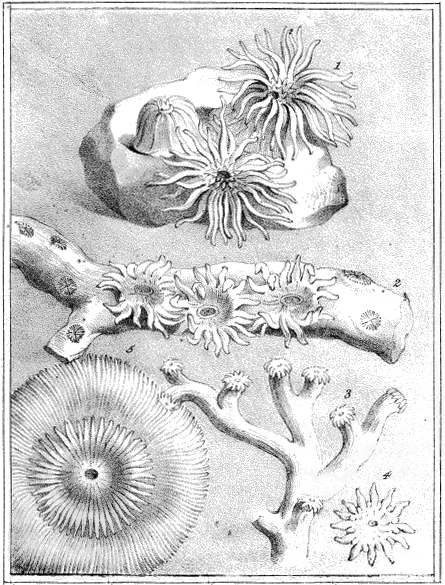
ACTINIÆ CORAL BUILDERS
If this was the case, they were not, however, quite right. Most kinds of Polypes very seldom move from one place to another in any way, but stick themselves upon a rock by means of the flat part of their bodies, and there remain; and when they let go they generally suffer themselves to be washed by the waves to some other place, where they can conveniently fix again. If you have ever been at Brighton, or at any other places by the sea side, for any length of time, I dare say you have seen the sea anemones, or sea flowers, as they are called, carried round by the fish people to show to their customers; or possibly you may have seen them in the holes on the rocks. They are proper Polypes, and the scientific name of them is Actiniæ. As they lead their lazy lives as if they were rooted in the rock, when they are hungry they spread out their tentacula to catch any little insects or minute fish, such as crabs and shrimps, which may come in their way. The instant they feel anything, they close in all their tentacula with surprising force. It is worth while to put one's finger just in the centre of one of these "flowers," to feel how strongly they can draw anything in. I have seen one suck in a little crab half as large as its own body, in this manner.
When closed up they look an insensible lump of pulpy flesh, but when their fringe of tentacula « 208 » is expanded, they are very beautiful indeed, and exhibit various rich colours. You may see them in each state in the plate (fig. 1.), where one is represented closed up, and two are open.
If one of these curious creatures is cut into several pieces in certain directions, each piece will become an animal. You will say that this seems more like a plant which is propagated by cuttings, than a proper animal. But for all this, and although it only appears to possess the same sort of sensibility, in regard to light and touch, as some plants do, I can give you a very good reason for its being considered as an animal,—it can move itself according to its own will, and in choosing the time in which it moves, it exhibits instinctive intelligence. When it finds its little inch of rock in any respect inconvenient from its being too high above low water mark, or not sufficiently in the way of the little creatures on which it wants to satisfy its appetite, it sucks in a great quantity of water, and swells itself out so as to become nearly as light as the water, « 209 » and then looses its hold and continues to float about till it comes in contact with some more convenient home. When I first saw them thus full of water, and carried about by the waves, I thought they were dead.
Now the coral builders are all of the same general character as the Actiniæ, in the construction of their bodies, their various colours, great mouths surrounded by feelers, and habits of taking their meals. But besides their being such wonderful architects, they differ from the English creature in being very sociable, and living together in immense companies. When you read of the Pyramids of Egypt, or of any other great structures, you may justly think them wonderful proofs of what the labours of many men may do when directed to a single object; but here you have not houses, pyramids, cities, nor even mere islands, but whole continents constructed by the combined labours of little insects.
I cannot tell you, neither can any one else, in what manner these little workmen perform their « 210 » work. It is only certain that they have some faculty by which they appropriate the particles of carbonate of lime contained in the sea water, and dispose them in the various forms I have mentioned to you. When the coral is in progress, it is coated with a soft gluey sort of substance, and over the star-like clusters of openings, there may be seen, when the creatures are hungry, little rosettes of tentacula, more beautiful than you can conceive.
In fig. 2 of the plate, you may see some of these animals showing their rich rosettes on a piece of branch coral, such as is represented in the first wood cut, page 204.
There is another sort of branch coral, where the animal always lives at the end of the branch, the whole of which it has to itself, and will then spread out its tentacula in a star on the extremity, as you may see in figs. 3 and 4.
In fig. 5, you may see one of the animals which construct the sort of coral represented in the cut, page 205.
Since these little creatures can lay down their tentacula in the openings of their stony houses, when they are not hungry, or when they are alarmed by the approach of anything that would hurt them, they do not want the tough skin with which the Actinia is covered, but have bodies of a very soft and yielding texture.
FORMS OF THE CORAL REEFS.
As I have now introduced to you, as well as I can by means of description and pictures, the inhabitants of these wonderful submarine continents, I shall now tell you something of the form in which they arrange their habitations. Those that I saw about the Society and Friendly Islands, were mostly in three different conditions. One kind forms a nearly circular reef, sometimes with an opening in it. It is a part of the common design of the Polypes always to make this opening on the Leeward side, when the place is one in which any particular wind blows during a great part of the year. I cannot tell you why « 212 » this is, but it is constantly observed wherever coral reefs are found. This peculiarity makes the enclosed spaces of water, (which are called Lagoons,) capital harbours for ships to anchor in, for they are nearly always smooth, the windward side of the reef acting as a breakwater. Here is a map of three reefs of this form, in a part of the ocean where the prevailing wind is South East, and you will see all the openings are towards the North West.
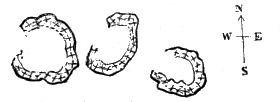
Another sort have an island of which the foundation is coral, in the middle of a ring like the above; and a third sort are merely the same kind of rings round large islands, composed of other sorts of rocks and earth. A very great number of the islands hereabouts,—perhaps most of them, are surrounded in this manner.
I well remember the first impressions which the sight of a coral reef made upon me. I always like to treasure up in my mind the first impression produced by a beautiful scene; for however wonderful the objects may be, when you have seen them many times, you become in some degree indifferent to them. This first impression that I am going to describe to you, is a continual feast to me when I think upon it, and I wish you could enjoy it with me.
The first parts of the reef we saw were black, roundish masses, standing up out of the water, having just the appearance of black men's heads, and when I asked the sailors what they were, they told me they were "negroes' heads." I was curious, as you may suppose, to know what they could be, and I afterwards found they were masses of coral, which were not covered by the sea, except at very high tides, and had become blackened by the weather.
The sun was shining brightly, and there was a smart breeze. The waves breaking over the « 214 » ragged surface of the coral threw up abundance of spray, which the sun's rays, every now and then, painted with the most beautiful rainbow colours. We sailed through an opening, and when we had got into the Lagoon, the sea was perfectly smooth. The water was as clear as crystal, and we saw the bottom, and what was going on there, nearly as well as if we had been close to it, though the depth was very considerable.
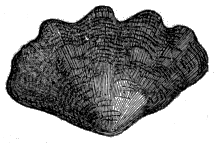
No flower garden was ever more exquisitely varied, both as to form and colour, than the scene under the water. The coral itself, standing up in the forms of shrubs, wheat-sheaves, mushrooms, stags'-horns, cabbages, and cauliflowers, was mostly covered with millions of the little polypes, displaying their graceful rosettes of green, purple, yellow, brown and white. Among these were strewn innumerable shells from the smallest to the largest, « 215 » and amongst the most conspicuous were the gigantic clams, of which many specimens weigh hundreds of pounds.
Then there were seen fish darting in and out as they
the variegated Zebra fish, and a hundred other species, often popping up from deep holes and caves, of which we could not see the bottom. All seemed life, beauty, and enjoyment, and when I had looked at it a long time, it brought to my mind the time when God looked upon what he had formed, and said that it was good, for you could not wish anything to be different from what it was; the scene appeared faultless, and quite filled up the heart with emotions of love and beauty.
This reef was one of those which surrounded a good-sized island. The cut will show you nearly how it appeared to be situated in regard to the land; a is the land; b the coral; and c « 216 » the Lagoon, the width of which was about a quarter of a mile.
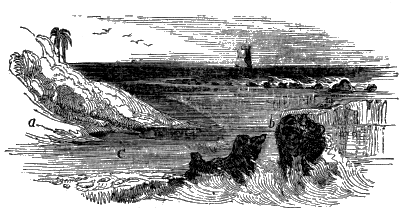
There were in it several masses of coral of a very curious shape, such as I have since found always exist in Lagoons. They are first built up in the form of a sugar-loaf, and when they get up somewhere between high and low-water-mark, the polypes extend them at the sides so as to make a sort of mushroom top, closely resembling the stones which farmers place ricks upon, to keep them out of the way of rats and mice. Their constructing these rocks in the sugar-loaf form, so as to make them as firm as possible, is a proof that the labours of the « 217 » polypes are directed by a common instinct, and that each one does not do as he likes, without regard to the rest. I suppose the reason why they spread them out at top, is because they love best the highest habitations they can get, that are not quite out of the water; and therefore as many polypes as can, make their residences there.
As the tide went down, a considerable space of the shore of the reef was left dry, towards the Lagoon, where it slanted off gently. Upon this there were some of the large clam shells, such as you saw a cut of just now. They generally lay about half open, but they would occasionally shut their shells together with a loud report, and then spout up a stream of water three or four feet high. We boiled one of these fish and tasted it, but found it very disagreeable. The fish weighed about four pounds, and the shell about fifty. There were many of a much larger size.
The reefs towards the sea outside the Lagoons go down very suddenly, and the soundings are generally deep, close alongside them. This is « 218 » ascribed to their being built upon the tops of submarine hills and mountains, for it is believed that the polypes cannot work at very great depths.
The surface of the reef is seldom quite so high as high-water-mark; but they sometimes go along an incredible distance without interruption, very near that point. The inhabitants of the group of islands called Disappointment Islands, and also of those called Duff's Islands, pay visits to each other over a bridge of coral 600 miles in length, on a great part of which their feet are close to the water, so that they look when on their journey at the time of high-water, just like troops marching on the surface of the ocean.
The natives of some of the Polynesian islands have actually employed some of these wonderful little masons to build quays and piers. The way they do this, is to break off large masses of coral from any reef that may be near, and drop them down where they want to form the pier. In a short time the polypes will have stuck them « 219 » together as firmly as possible. In an island called Barabora, a very fine quay has been thus constructed, where a good-sized vessel may conveniently take in or discharge its cargo.
There were once coral islands where England is now, for in many counties fossil coral is found in great quantities. It is indeed most likely that there are large tracts in every part of the world, which owe their existence to the labours of polypes.
This would most probably be the history of the formation of one of these tracts, if it were in the Pacific Ocean. A volcanic eruption would throw up a mountain from the bottom of the sea, the top of which might be 60 or 70 feet below the surface. As soon as the eruption had ceased, some polypes who may have left their position on a neighbouring reef, might be brought by the tide into contact with the summit, and would immediately begin to work. The race of polypes would multiply, and the building would go on year after year, till the reef reached the surface. « 220 » Pieces of wood which are always drifting about in the ocean, might be washed into the Lagoon and rest upon the shore. A little soil might thus be formed in the course of years, and a cocoa-nut or some other sort of seed, which would equally well bear soaking in the salt water, might be brought from some distant land, and may take root and produce a tree. The steady trade winds would also bring some of those seeds which are provided with wings, such as thistles. Various sea birds might build their nests upon the infant land, which would thus be increased in a hundred different ways. Small animals driven out to sea on pieces of timber or trees, torn away from their original position by hurricanes, might land upon it; and after a succession of ages, man would take possession, and a populous country in time be formed.
If you are fond of poetry, you would be much pleased with a very beautiful description of such a process as this, in James Montgomery's poem, called the Pelican Island, which you should read.
If you were to go on a long voyage, there is nothing that you would be much more pleased with, than the occasional bright appearance of the sea at night. You might see this in all latitudes, but more frequently in the tropical, than in colder climates. It occurs in a variety of modes, and, as it seems, arises from several different causes. Sometimes the wake of the vessel looks like a waving line of beautiful silver light; sometimes the surface will be studded with spots of bright light, about as large as your heads; not unfrequently you may see large islands of light; and now and then a shoal of Albicores, or some other fish, will pass the vessel, shaking sparks of dazzling brightness from their fins in all directions.
It has been supposed by some that the brightness in the track of a vessel, and that which sparkles and flashes in the spray on the tops of the waves, is electrical light: whether it is so or not, I cannot tell you.
The effect is, no doubt, sometimes produced by decayed animal and vegetable bodies, which appear bright in the dark. I dare say you have seen the bodies of dead fish, and the surface of rotten wood have this appearance. The particles in which the brightness exists are so small, that you cannot see them, for, if you touch the luminous body, particularly if it is a stinking fish, your fingers will immediately appear bright in the dark, and when you look at them in the light, you will not be able to see anything on the surface of the skin.
But the most wonderful and extensive cause of all, is the existence of countless myriads of fish and insects, which are supplied with a fluid substance that oozes out of their bodies, and shines with a greenish light upon their surface. « 223 » Some of them may easily be taken, by dropping over a net where the luminous spots appear. A few of them are small shell-fish, of the crab or lobster kind. However, the greater part are an immense family of creatures called Acalephæ, or sea nettles. The word Acalepha is the Greek for a sting nettle, and they are so called for a reason which I will tell you presently.
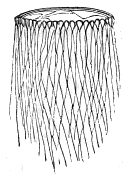
There are a great many different forms of them, but they mostly agree in having their bodies shaped something like an umbrella, with long filaments hanging down from them. This is a picture of one of the kind called Berenice. It takes its name from the resemblance of its filaments, to the long hair of a lady. Berenice was the wife of a warrior, who made a vow to sacrifice the hair of her head, which was singularly beautiful, to Venus, if her husband returned from some successful exploit in which he was engaged. He did so, and the « 224 » lady accordingly hung up her hair in the temple of Venus, and thereby gained the honor of giving her name to a constellation called the hair of Berenice, and the curious animal figured in the cut.
The substance of the body is a mere mass of jelly, mostly quite transparent, but sometimes tinged with blue or green; and when deprived of life it becomes merely a salt liquid, and an extremely thin skin, weighing only a few grains.
The mouth is underneath, in amongst the filaments, which seem to be placed where they are for the purpose of entangling small fish and insects, to hold them till the Acalepha can swallow them. A very great number of them are of a kind called Medusa, from the resemblance of their filaments to the snakes, which were said to take the place of hair upon the head of Medusa, one of the Furies. One or two sorts have a crest which they erect as a sail, and thus move along before the wind, on the surface of the sea, « 225 » in calm weather. I will show you the picture of one of these called the Physalia.
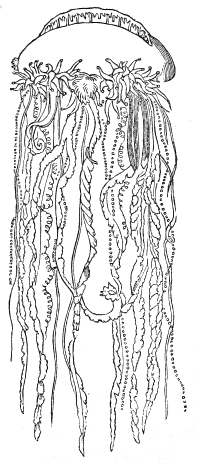
The size varies from that of a pin's head, to a foot or more in diameter, and it is said that some have been found to weigh as much as 50 pounds. Their weight is a very little more in proportion to their bulk than that of salt water, and they keep themselves afloat on the surface, as long as they are inclined, by moving very slowly along, which they do by alternately contracting and expanding a very light ring of muscle, which surrounds the umbrella. When they are tired of their snail's gallop, or they want to descend on any other account, they « 226 » cease moving, and down they go. In this respect they are just like a man swimming, who sinks if he ceases to strike with his limbs.
There are some species peculiar to hot climates, where they are generally larger, and more luminous; and some to cold. But what is wanting in size is amply made up in number, in the Arctic regions. A certain naturalist calculated by a fair average, how many Acalephæ there were in two square miles of sea, and the result of his calculation would fill up a whole line of this work with figures; you may judge something of it, by his saying that to count the number would have taken 80,000 persons all the time that has elapsed since the creation of the world, counting as fast as they could! It is on these creatures, most of them so small that they cannot be seen without a microscope, that the vast bodies of the whales are supported, caught in the wonderful shrimp-trap, which I described to you in a former page!
Two or three kinds are found on your own « 227 » shores, and I should not wonder if some of you may not before now have found them lying on the sea-shore, which the tide has left dry, and taken them up in your hands. If so, I am sure you will not forget it, nor be in any difficulty to know why they are called sea nettles. They have a stinging power, which will make the hand smart that touches them. This is owing to a caustic fluid with which a part of their bodies is constantly covered.
It is this caustic fluid which is luminous. It oozes through the skin all round the muscular ring by which they move, and at the large filaments. The whole body of the creature looks bright, but it is only from the light transmitted by these parts. You may get a very fair notion of the appearance of one of their bodies, by rubbing together two partly transparent pebbles in the dark; the light is of nearly the same colour, and though it is only produced just at the points of contact of the pebbles, it illuminates their whole substance.
As they move along they are much brighter when they contract their bodies, than when they expand them; this is because in contracting they press out the luminous fluid. I will tell you of some experiments and observations, which have been made on them.
The body of an Acalepha was squeezed over a glass of warm fresh water, and the fluid that dropped out communicated its luminous property to the water. The same was then done with a glass of warm salt water, but the effect was not nearly so great.
One was squeezed over a vessel containing nearly a quart of milk, which it made so resplendent that one could see to read by it. The milk retained its brightness for several hours, and when it faded, it could be restored by stirring: even three days afterwards it was made bright by being warmed.
In this manner the Acalephæ communicate a slight degree of light to the sea-water, in which « 229 » they swim; but, if they are put into fresh water, the light spreads much further.
I have often seen them round the ship, looking like so many moons, and emitting light enough for me to read by, some on the surface, and others at various depths below it. Their appearance was exquisitely beautiful when the weather was still and the night dark; but as I thought about it, I could not help having something of a melancholy feeling at the strange kind of half-life these creatures lead. They might enjoy themselves, but I could not tell how, for they had no sight nor hearing; they loved no light except their own selfish light; they moved about in the open sea, without seeming to enjoy their freedom, for they did not care which way they moved; they had no fixed homes or neighbourhoods to love, like the coral insects; and above all, they did not care for their kind, for they appear to come near each other only by chance as the wind or the waves may drive them.
But as they were created by God, their life was given them for some wise end, and no doubt they have something to do in creation, and they are capable of enjoyment, though perhaps of nothing that would be enjoyment to us.

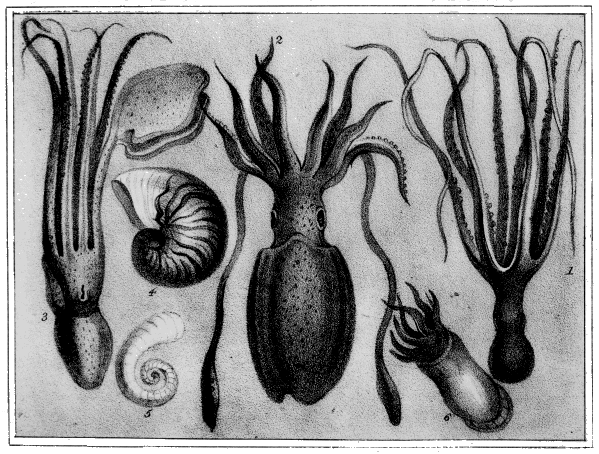
SEPIAS

Have you ever seen the bone of a cuttle fish? It is a flat, white, very light thing, about the shape and size of a small sole, or flat fish, which may be often picked up on the sea-shore. One side is covered with a very hard substance, which stands out and forms a border all round; but the other side, which has no covering, is so soft that you can easily scrape it into powder with your nail. It is often used for making tooth-powder, and polishing certain things, such as hard woods and tortoise-shell.
This comes from some of a most curious family of fishes, called by the general name of Cephalopods, from the Greek words for head and feet, because their feet are placed round their heads, and they walk along with their heads downwards.
There are several kinds represented in the plate, which will give you a general notion of their form and appearance. In the structure of their bodies they possess much more in common with the kind of animals with which you are familiar, than the Actiniæ which make the coral, or the Acalephæ which produce the luminous appearance on the sea; though nothing can be more strange or unsightly than their aspect. They have a complete system of circulation, though their blood is neither warm nor red as ours is; their brains are enclosed in a strong case or skull of gristle, and their organs of sense are well developed; they have large and perfect eyes, (as you may see in the picture,) standing out prominently, and ears on each side of the brain. « 233 » Their mouths are armed with very strong horny lips not unlike the bill of a parrot, between which is a very rough tongue. They have no noses, but it has been proved by experiment that they like some smells and dislike others, and it has been supposed that the quality of substances which affects merely the organ of smell in us, affects in like manner the whole surface of their bodies, or at least, of their heads. They not only resemble birds in their mouths, but also in having gizzards.
Their great arms or legs, for they serve both purposes equally well, of which they generally have eight, are very wonderful. They have no bones in them to act as levers, but are merely long and muscular masses of flesh which they move about with wonderful activity and power in all directions, having the most complete command over them. On their surfaces are great numbers of little suckers or cups resembling leather, which adhere very strongly to anybody which the animal chooses to embrace.
You have, no doubt, often played with a round piece of thick leather with a string through it, by wetting it and pressing it with your foot upon a stone, so as to lift the stone up, if it be not too heavy. It is just on the same principle that the suckers of the Cuttle Fish act.
These curious creatures gather up some of their arms into a point, as a sort of cut-water, as sailors would call it, and swim very rapidly, by means of the others, having their heads behind. They crawl in all directions with equal facility.

Their skin changes colour in spots like that of the Chameleon. But I shall now tell you their most remarkable peculiarities. They are provided with a bag filled with black stuff, very like printer's ink. This bag they can at pleasure open, and press out some of the ink; so when any voracious fish approaches, which the Cuttle Fish thinks will be too strong for him, he squeezes his ink-bag and colours the « 235 » water round him, and thus all of a sudden becomes enveloped in a dark cloud, in which his enemy gropes about in vain, while he makes the best of his way off. Is not this a most astonishing mode of defence?
The kind which is found most frequently in our country is represented in the plate fig. 2. Its skin is smooth and often of a dusky white, with reddish brown spots, and its length about a foot. It is eaten by the poor people on the coasts of the Mediterranean Sea. I never tasted it, but I do not think that either you or I should like it, from the look of its flesh.
There is another species of which the ink makes the colour called sepia, which is of great value to artists.
The largest is called Octopus, and is figured No. 1, in the plate. It is a very powerful creature, and very ferocious in its disposition. It is mostly found in the Indian Ocean, where it has been known to drown men by throwing its great arms round their limbs as they were swimming. « 236 » It is also much dreaded by the natives of some of the islands, who sail in small canoes; for an Octopus will sometimes cast one of its arms over the side of the canoe, and will be sure to overturn it, if the man does not instantly chop the arm off.
Like most other very wonderful things, the accounts of the Octopus seem to have been strangely exaggerated, though we should not be too ready to deny what a man who seems to be sensible and honest relates, merely because it is not like our own experience. In regard to the largest size to which the creature has been known to attain, it is very difficult to tell what is the truth. I will relate to you what has been said on the subject.
Some navigators have asserted that the largest vessels have been put in danger by an Octopus raising its arms so as to get them entangled in the rigging; and a great many have said the same respecting large boats.
Pliny, the Roman Naturalist, tells a story of « 237 » one in particular, which was a sad thief. I should tell you that the Octopus is able to walk on land when the surface is uneven, so that he can get something for his suckers to adhere to. Well, this individual that Pliny mentions, used to visit a house near the sea-side, and steal all the provisions within his reach. He was seen once or twice before he could be taken; but at last his thefts were so important, that the inhabitants of the house watched for him all night, and caught him by the help of dogs, as he was striding over the rocks towards the sea. It is said that he weighed 700 pounds, and that his arms were 30 feet in length, and so stout that a man could not embrace them.
Still more wonderful are the narrations which were commonly believed about 150 years ago, respecting some Sepias that frequented the coast of Norway. They were then generally called Krakens, and were supposed to be at times nearly a quarter of a mile in length. It is related that sailors not unfrequently mistook them for islands.
This is alluded to by Milton in a passage of the Paradise Lost,—
I dare say you will be ready to think that these things are very unlikely, and I shall not much differ from you if you do. But no doubt some of these creatures must be very large, and much to be dreaded, or such things would never have been said of them.
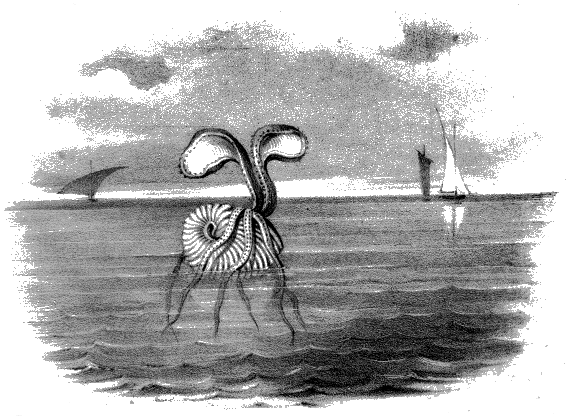
PAPER NAUTILUS.
But there is one of these Sepias, or Cuttle Fish, which I like very much, though its character rests under as severe an imputation for dishonesty and rapacity, as that of the rest. It is that one which inhabits the beautiful white semi-transparent shell, and is called the Paper Nautilus, or Argonaut.
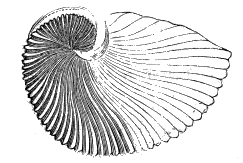
Its body is represented out of the shell in the plate, fig. 3, and you will there see that it is not « 240 » very different from those that are not provided with shells, except in having two of its eight arms spread out at the ends into a thin membrane or web. You shall hear presently the pretty use which it makes of these webs.
It has no muscular attachment to the shell, as most other shell-fish have, but merely adheres to it by means of its suckers. On this account, some have thought that the Sepia must be an usurper, who has murdered the original master of the shell, and taken possession of his house. But I do not believe there is any truth in this charge, for the same sort of animal is always found in the same shell, and if it be taken out, though it may be kept in salt water, it is sure to die.
When at the bottom of the sea, he walks about with his shell uppermost, like a snail, but of course with a much more rapid motion, and every now and then snatches any mouthful that may take his fancy, with two of his long arms, and conveys it to his horny beak.
When the weather is fine, and he is disposed to enjoy it, he partly empties his shell of water, so as to make himself lighter than the surrounding sea, and comes up to the surface, on which he floats like a little ship.
I once had an excellent opportunity of watching one. The sea was beautifully calm, and blue, and the sky perfectly clear, when I caught sight of something white coming upwards at a little distance from the ship. In an instant the delicate white shell popped above the surface, twirled round, and the Sepia spouted out the water remaining in his shell, spread out his two sails, and threw out his six remaining feet, three on each side of the edge of his shell, which acted as oars, and scudded away before the wind. If you had but seen the glad little creature, it would have done your heart good. He seemed full of freedom, and life, and joy. The dark deep caves of ocean, with their corals and sea-weeds, and strange variety of inhabitants; the broad surface of the sea, the fresh breeze, the lovely blue sky, « 242 » and the glorious light of the sun, were all at his command.
(Hartley Coleridge.)
You should read these exquisite lines with deep attention. There is an allusion in the second verse to the common notion that the form of a ship was first taken from the Nautilus; and, indeed, there is a very distinct resemblance in a part of the shell to the keel, and in another part to the poop. The sails and oars you will see best in the picture.
Do you think that if the Sepia were a murderer and a thief, in possession of what does not belong to him, according to the notion of some naturalists which I was telling you of just now, that he could be so happy,—so in every way at home,—in his silver boat? If you had seen him as I did, I am sure you would agree with me in saying that he could not be any other than the rightful owner.
After "the small marinere" had sailed some distance, he folded up his sails and packed them and his oars close into his shell, and went down like a stone.
The Paper Nautilus is mostly found in hot climates. It is never seen on the surface unless at a long distance from land, and it is very shy of danger, so that it is not often you can get such a good chance of observing one as I had. I have been told by a person who was to be trusted, that sometimes the Sepia will lay hold of a piece of drift wood, a large leaf, or any other floating substance, and use it as a raft, when it is not inclined to take the trouble of balancing its shell with its feet, and spreading its sails.
And now, my little friends, what I have told you respecting these marvellous Sepias, reminds me of something on which I may give you a useful caution. Many people are very fond of congratulating you on the great wisdom and knowledge of the times in which you live, « 245 » and of making very light of what the ancients knew, or thought they knew, especially respecting natural history. In doing this they are not just to those who lived before us, and very often deceive themselves in regard to the present state of our knowledge. Aristotle, the tutor of Alexander the Great, did more in investigating the nature of the Nautilus, and all other kinds of Cuttle fish, than any other naturalist has done, and in his writings, (if you could read them,) you might find nearly all the particulars I have mentioned, and a great many besides. As to some foolish things that may be found related by him and other old writers, which are held up for your ridicule, it is not at all unlikely that future ages may find flaws and follies in what writings we may leave behind us, as we now do in what our predecessors have left us.
THE PEARLY NAUTILUS, &C.
There is another kind of Nautilus, the shell « 246 » of which is very strong, and marked with brown streaks. You will see it in plate XV, fig. 4. It also differs from the Paper Nautilus, in being divided into a succession of cells or chambers, in this manner.
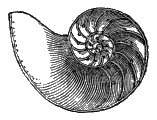
In this respect it is like the immense family of extinct shells called Ammonites, or Cornua Ammonis; but the partitions of the chambers of the latter are undulated, thus
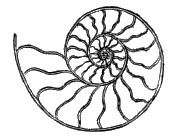
As the cells are mostly filled with various hard earthy substances, so as to form one solid « 247 » mass, they used to be called snake-stones, because it was fancied they were petrified snakes. There are a great number of them on the coast of Yorkshire, and the story was once believed that the place had been infested with an immense quantity of snakes which were changed into stone at the prayer of St. Hilda. What I am going to tell you, relates both to the Ammonites and the Nautilus.
If you examine the first cut, you will see small openings connecting all the cells with each other, and the continuous passage thus formed through the whole of the shell, is called the siphuncle. The inhabitant of the shell is an animal of the Sepia kind, but without the webs which serve the Paper Nautilus for sails, and with its arms not so long. It always resides in the outermost chamber, and it is supposed that it forms a new partition every year, so that the age of the animal may be known by counting the number of chambers.
When the Pearly Nautilus wishes to rise to the surface, it pumps out the water from its shell through the siphuncle, and makes itself light. It floats often with its shell upwards, and at other times it moves along backwards for a considerable distance, by means of spouting out water over the front edge of the shell. It never floats with the same beautiful stateliness as the Argonaut.
There is also the pretty little shell of the Nautilus Spirula, not much larger than a shilling, plate XVI, fig. 5, which does not contain a fish, but is merely annexed to the body of a Sepia, as is represented, fig. 6. Its use appears to be just the same as that of the shell of the Pearly Nautilus, to answer the purpose of a float.
These two kinds are very rarely seen floating on the surface, though there must be many of both of them in the ocean, from the number of their empty shells which are found. Perhaps this arises from their not being so buoyant as the Argonauts, and hence they more « 249 » readily dip under the surface at the approach of a vessel.
It is now time for us to bid adieu to the sea and its wonderful inhabitants, since I have promised to tell you of some of the wonders of the sky, (though I remember a great many more things that I should like to tell you of).
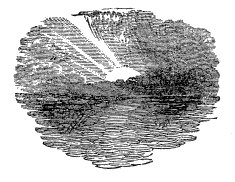
WONDERS OF THE SKY.
COLOUR OF THE SKY.
Before I tell you of some of the wonders of the sky, I should like to tell you what the sky is: it is true you know pretty nearly as much as I do about it, but you perhaps have not thought so much on what you know. The sky is everything above our heads which is not connected with the earth: thus, you may speak of a cloudy sky, or a clear sky; or of the stars, sun, and moon, being in the sky.
It may however be more proper to restrict the word to the blue appearance which the atmosphere above us assumes when it is not concealed « 251 » by clouds. This appearance is caused by looking into the air, which surrounds the globe to the height of forty or fifty miles above its surface, and not by anything which exists above it; for mountains, when seen from a great distance, appear of the same colour, evidently from the extent of the air between the spectator and them.
Climate and the season of the year, have a considerable influence on the colour of the sky. You know what a rich full blue is over us in the hot months of summer; and I hope you have before now enjoyed the pale blue of a clear winter's day, when the brown and bare branches of the trees have showed against it, and all the rivers and ponds have been frozen as solid as a stone pavement. When I see some of you sliding and skating on the glassy ice, at such times I am ready to wish I was a boy again, to join in your pleasures. However, I have had my turn, and old age has its pleasures as well as youth, only we are apt to get into a way of « 252 » looking at all past times as happier than the present, which is both foolish and wicked. If we were to keep ourselves diligently engaged in doing our duty, we should always be happy, whether old or young.
But the darkest blue sky you have ever seen in your country, is light compared with the skies of hot climates. In them you often see a deep rich indigo; at other times you are under a canopy of reddish orange, almost copper colour, like that which was called in the poem I quoted to you when describing the tropical sea, "a hot and copper sky."
The elevation of the observer above the surface of the earth, is likewise another cause of variation. I have never myself ascended a mountain sufficiently high to see this, but I have been told by a gentleman who had been at the top of Mont Blanc, that the sky there looked nearly black.
As you must have seen them yourselves, I need only remind you of the glorious changes of « 253 » colour by the alteration of the light at the different times of day. I hope none of you are so lazy as not often to have enjoyed the rosy mornings; then there is the grey twilight of evening, and the splendours of the setting sun in the west, round which the deep orange shades off into the most delicate yellow, which again glides imperceptibly into pale blue towards the east. Then the moon, when she has the heavens all to herself, and the stars, when they are shining out boldly in her absence, each make the sky so beautiful, and are so beautiful in themselves, that one cannot exceed the other.
I love to look at the moon when the winds rend the clouds asunder, and drive them tumultuously along, and you see her now and then in the dark blue depths between. But if I were to tell you all the ordinary appearances in the sky which I love, I should leave no room to describe its wonders; which will not do, because I meant this book to give you an account of things which most of you have not seen.
During the winter months in the Polar Regions, the sun never rises above the horizon; and during summer it performs in appearance a little circle round the pole of the Heavens, and never goes out of sight. You may learn in what manner this is occasioned by the position of those countries on the surface of the earth, from the book called "The Wonders of the Telescope."
The year is thus in reality divided into one long day and one long night. While the night continues, the ground is covered with snow, and no vegetable life is to be seen, and the animals have much to do to support themselves on what fish they may chance to pick up on the sea « 255 » shore, by preying on each other, or else by scraping away the snow to get at that scanty vegetation which exists underneath. The odd-looking Esquimaux and Greenlanders would indeed be very badly off, if it were not for the beautiful atmospheric phenomena which I am going to describe.
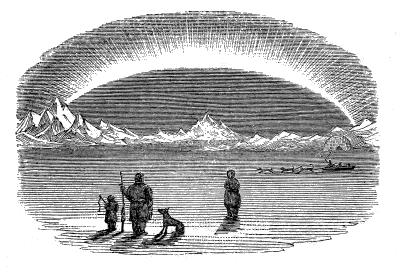
There are seldom intervals of many hours which are not illuminated by these beautiful meteors, called Auroræ Boreales, or Northern Lights, occurring in a never-ending variety of « 256 » form, colour, and intensity. They generally have a tendency to form an irregular arch, and one side of them is always much better defined than the other. The more ragged side sends out brilliant corruscations, shooting out into the sharpest angles.
Sir John Ross describes one which was nearly the colour of the full moon, and of equal brightness, in the form of a well-defined arch extending quite across the heavens, and reminded him of what he conceived must be the effect of Saturn's ring seen by the inhabitants of that planet from its surface. It lasted for several hours, and at last broke up as it were into fragments of light, and disappeared.
The distinctness of its form is much influenced by the wind, and when the air becomes agitated, showers of rays spread out in every direction with the quickness of lightning. Sir Edward Parry describes long bands of light extending with immense rapidity, but always appearing to form round a fixed point, something like a « 257 » riband held in the hand and shaken with an undulatory motion.
Little scraps of the brightest light dart about in the heavens, called by the sailors, "merry dancers." In stormy weather these wild little things assume all manner of fanciful shapes; sometimes they shoot like rockets across the firmament, then take a zigzag or waving direction, and frequently seem to become invisible, and shine out again a little further on. The Esquimaux say that these appearances are the spirits of their ancestors playing at ball with the head of a Walrus! You may perhaps laugh at this odd notion, and I will laugh with you, if you will learn a lesson from it. You see that men in various states of society, are always looking out for the appearance of spiritual beings, and therefore that this disposition is a part of their constitution which is given them by God: and although their fancies may form strange notions at times, yet the exercise of the faculty, in some way or other, is very important. « 258 » Men had much better think that they see spirits in the Aurora Borealis, and that they hear them in the wind, than forget that there are such things as spirits, and that they have spirits within them, which will live when their bodies are turned into dust.
But for you, my little friends, who are better instructed, there is no occasion to think you can see or hear spirits with your bodily ears and eyes; but I trust you will always feel inwardly that there are spirits within you and around you, and one Great Spirit above you.
The most beautiful form of the Aurora, is called the Corona. It is a luminous ring generally just overhead, with long distinct rays very slender, but extremely bright, diverging from it all round. It only lasts a few seconds, and then seems to burst like a firework, scattering sparks in all directions.
The stars mostly shine through the Aurora, as through a veil of thin gauze. The darkness of the sky, with the stars shining in it above « 259 » and below, produces a most astonishing effect, which you may see very well represented in the frontispiece, where there is depicted a small portion of the middle of a luminous arch, very clearly defined.
It was considered, till quite lately, that the Aurora in the Northern regions, made a sort of rushing and rattling noise. This, however, seems to be false, for Captain Lyons used to stand on the ice with his ears uncovered till they were nearly frost-bitten, listening with the utmost attention, but he could never hear the slightest sound. A very intelligent Danish traveller says, that he has often heard the sound, but that he is convinced of its being produced by the wind blowing upon the ice. The reason of its being heard while the Aurora is shining, seems to be that the Aurora often appears when it is windy, or has something to do with a change of weather, which also occasions the noise.
The Aurora often appears in this country, but not with nearly so much brilliancy or frequency, « 260 » as in more northern countries. I have, however, seen it very beautifully developed in light tints of red, yellow, and green, but very seldom with a clear outline and determinate form. It appears that it has been observed here much oftener than formerly, within the last hundred years, and this applies to nearly the whole of Europe, where it occurs. In Sweden, before the year 1716, it was a great rarity, and about the same time the inhabitants of Iceland were alarmed at its becoming so much more frequent than it had previously been, supposing that it portended some great misfortunes to be coming upon them. A similar fancy prevailed amongst ignorant persons in this country, and I have heard that people used to imagine that the appearance was a sign of an approaching war.
I have very little to say to you respecting the cause of this wonderful phenomenon. The most reasonable notion seems to be, that it is occasioned by electric fluid playing about, and diffusing itself in the upper regions of the « 261 » atmosphere, where the air is very thin. A similar kind of light is produced by a very pretty experiment, which consists in sending an electric spark through a long glass vessel, from which the air has been exhausted. When the air is more compressed, as it is near the surface of the earth, the electric fluid does not so spread itself abroad, but moves in more direct lines, and in more compact masses, as you may see in lightning, or in the sparks of an electrifying machine sent into the atmosphere under ordinary circumstances of density.
PARHELIA OR MOCK SUNS.
There are a great many very wonderful appearances in a polar sky, besides the Aurora Borealis. Perhaps the most remarkable of these are Parhelia, or "mock suns," which are often seen to shine in various parts of the sky. As many as six of them are sometimes seen at once, all shining with great brilliancy. They are generally brightest just before day-break, and fade away as the true sun ascends.
Parhelia have also been seen at different times on the continent of Europe. At Marienberg, in Prussia, many years ago, towards evening, one « 263 » was observed which seemed attached to a small white cloud that was situated just below the sun. It was at first of a reddish colour, but as the sun descended towards it, it assumed the aspect of the sun itself.
Three at once were seen at Sudbury, in Suffolk, and two were seen in a part of Rutlandshire. There are recorded many other appearances of this remarkable phenomenon, but they do not seem to differ much from each other.
There is great uncertainty as to what occasions these mock suns. Perhaps they are merely reflections of the image of the true sun upon reflecting clouds, such as I shall describe to you presently. The circumstance that seems to render this probable, is that they sometimes become brighter as the sun approaches them, which cannot easily be accounted for by supposing them to have any source of light in themselves. On the contrary, their fading away at times as he rises, may be occasioned by the clouds on which they are reflected, becoming « 264 » rarified; or the effect may be only comparative, just as the moon grows paler, and at last disappears, as day comes on. Thus you see the two opposite effects of the sun's approach may be equally well accounted for, on the supposition of the Parhelia being mere reflections of the sun, and I do not think that they could on any other.
IGNES FATUI.
The name Ignis Fatuus, or False Fire, is applied to a flickering, bluish light, which is often seen in marshy districts, and in damp burial grounds, either on the surface of the earth or only a small distance above it. So you see it is not strictly a wonder of the sky; but I introduce it here because it seems to be somewhat similar to some of the higher meteors, in the manner in which it is occasioned.
A great many entertaining stories are told of persons having mistaken these Ignes Fatui for real lights, and it is said that benighted travellers « 265 » have frequently been led far astray by them. They are vulgarly called in various parts of the country, Will-o'-the-Whisp, Jack-o'-the-Lantern, Peg with her Lantern, and in burying grounds in Scotland, Grave Candles; and strange superstitious notions are annexed to them. They keep constantly in motion; now rising a few feet above the earth, now sinking to the surface; now seeming to be close to you, disappearing in an instant, and shining out at some distance; at times one of them dividing into two, or two seeming to join into one.
I will presently tell you how you can try a simple experiment, that will go a great way towards accounting for these idle Will-o'-the-Whisps. The inflammable gas called Hydrogen, is copiously produced by the decomposition of animal and vegetable bodies. The substance called Phosphorus, is contained in animal bodies, and is set at liberty in small quantities by their decomposition. When phosphorus and hydrogen come together under certain circumstances, they « 266 » mix, and a gas called Phosphuretted Hydrogen is the result.
There is, therefore, no difficulty in supposing that most marshy grounds may produce this gas; and this experiment will show that it is very likely that the Will-o'-the-Whisp is nothing more.
Hydrogen may be obtained by pouring diluted Sulphuric acid on small pieces of Iron or Zinc. If you mix very small pieces of Phosphorus with very small pieces of Zinc, and put them into a glass, and pour over them the acid, Phosphuretted Hydrogen will be sent off, and the surface of the acid will be covered with a beautiful blue flame of the very colour of the Ignis Fatuus. The cause of the flame is, that the phosphuretted hydrogen is so wonderfully inflammable, that the moment it comes into air of a common temperature, it bursts into flame. If you try this experiment, you will see how likely it is that the Will-o'-the-Whisp is an escape of this gas from the surface of the earth.
There are few of you who have not seen falling or shooting stars, as they are called. Perhaps some of you have loved to walk out when the stars have been shining brightly in the blue sky overhead, to watch for these shy wanderers that seem to come from no where, just to draw a line of silver light across the heavens, and then disappear. When I was a little child, I used to think that each appearance of this kind was the destruction of one of the countless worlds that surround us, and possibly the same fancy may, at some time or other, have occurred to you.
If you have taken delight in watching for « 268 » them, you have many a time been disappointed, because they would not show themselves more frequently. It is, for the most part, only now and then that you can catch sight of one; but there have been some occasions on which they have appeared in immense numbers.
The most astonishing multitude of them on record, appeared in the year 1833, in the night of the 13th of November, and was seen over nearly the whole of North America, from the Gulf of Mexico to Baffin's Bay. They came from all quarters of the Heavens, and are said at one time to have been half as thick as the flakes in a heavy fall of snow. It was calculated, on the most moderate grounds, that 36,000 must have appeared every hour for seven hours successively.
Previously, in the year 1799, also on the 13th of November, a similar phenomenon was observed by Humboldt, the celebrated traveller, by some Moravian Missionaries in Greenland, and by many persons in Germany.
In the year 1822, on the same day of the same month, almost as great a number were seen in several parts of Europe and Asia.
In the year 1831, a French Officer states, that on the 13th of November, while off the coast of Spain, he saw on an average more than two a minute during several hours of the night.
Similar observations were made in the year 1835, in some parts of France; and from several other instances, there seems to be good reason for believing that there are more falling stars about the middle of November, than during any other part of the year.
There have been a great many vague and silly notions devised to account for these remarkable phenomena, and some that are not unreasonable, though none perhaps quite satisfactory. It has been considered that they were clouds of hydrogen gas, suddenly ignited by electricity, within the range of our own atmosphere, and indeed only a very few miles above the earth. Recent investigations have, however, rendered it « 270 » most probable that they are at very considerable elevations, often as much as 500 miles above us.
But supposing the circumstance of great multitudes of them appearing just at one particular period of the year, to be a fact, a new light is thrown upon their origin which must then be considered as decidedly of an astronomical character. The theory which has been proposed, is this:—that immense quantities of fragments of matter revolve in regular orbits in our solar system in various planes, and that on the 13th of November the earth passes near the orbit in which the greatest number of such fragments move. Whether they are matter in a gaseous state, or approaching it, or quite solid; or whether they are constantly illuminated, or are only rendered luminous by their relation to other bodies, such as reflection, or meeting with electric fluid, and so becoming ignited, are questions which must remain unanswered. There may be a slight evidence in favour of the notion of their light not being permanent in themselves, « 271 » from the fact of a French naturalist having observed on the 17th of June in 1777, a very large number of small black spots pass over the sun's disc. If these spots were really bodies, which under other circumstances would have been falling stars, it should not be forgotten that the earth in June is nearly in the opposite part of its orbit to that which it passes over in November.
Well, after all, this is a very doubtful subject, and we may possibly be very much out in our notions; but it is always worth while to see which is the best of two theories, though there may be ever so little to choose between them. We should make the best of what knowledge we have, and never lazily satisfy ourselves by saying—"nobody can tell which is true," which is almost as bad as being too obstinate and dogmatical. For even if we adopt a conclusion which is wrong, we shall be more ready to receive the truth when our knowledge may be increased, than if we have no conclusion at all. « 272 » One of the wisest men who ever lived, said—"Truth comes more easily out of positive error than out of confusion."
You who have been interested with what I have told you respecting shooting stars, should compare with it what I shall tell you in my next chapter.
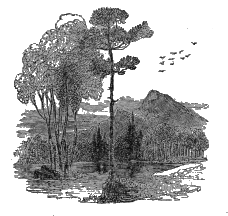
There were a great many accounts in very early times, of stones having fallen from the sky. In China and some other eastern nations, they have long had a notion that such occurrences were connected with political events, and accordingly they have kept careful records of what they have known to fall for centuries back. This was a vain superstition, but it was not more vain than the incredulity with which these reports were received by nearly all the learned of Europe, till about forty years ago. They denied the existence of aerolites, for no other reason than because they had not seen them.
Some new statements attracted the attention of scientific men in England and on the Continent, to the subject, about the beginning of the present century, and the conclusion of their researches was, that stones of various sizes do, in reality, not unfrequently fall from above to the earth.
It appears that sometimes they fall singly, and at other times in great numbers. I will relate to you some particular instances.
Near Benares, in the East Indies, in the month of December in the year 1798, a very bright meteor seemed to fall to the earth, about 8 o'clock in the evening, and a loud noise like thunder was heard, which was followed by a shock like the fall of heavy bodies. No cloud was to be seen in the sky. The light of the meteor was so great as to cast very distinct shadows of the objects in its way. The ground where it appeared to have fallen, was afterwards examined, and was found to be strangely torn up, having a number of small holes in it about six inches deep. At the bottom of each hole was « 275 » an aerolite weighing on the average about one pound and a half.
In the year 1803, a similar event took place in Normandy. The meteor, when first seen, must have been at a very great elevation, for the inhabitants of two places more than a league distant from each other, thought it was just over their respective towns. A hissing noise was also heard, like that of a stone hurled by a sling. The space over which the stones were dispersed, must have been more than eight miles long and three wide. There were about two thousand of them collected, of various weights, from two drachms to seventeen pounds.
Two stones, one of which weighed 200 and the other 300 pounds, fell in the year 1668, at Verona. In 1680, several small ones are said to have fallen in London. In 1628, several fell near Hatford, in Berkshire, one of which weighed twenty-four pounds. In 1795, one weighing fifty-five pounds, fell in Yorkshire. In 1810, a large aerolite fell, which was the « 276 » means of setting fire to five villages, and killing several persons, in India. The largest of these are, however, small compared with some which are said, and there is good reason to believe, to have fallen from the sky, at some time or other. One of these, now at Bahia, in Brazil, weighs 14,000 pounds.
This is a cut of an aerolite in the British Museum, which fell in Buenos Ayres. It weighs 1,400 pounds.
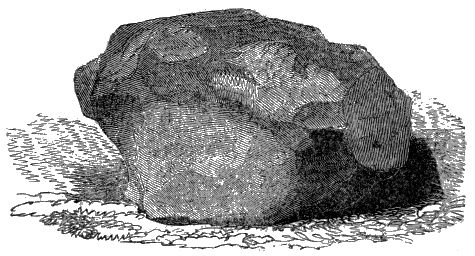
They are generally covered over with a thin crust, which is quite black, and have a very « 277 » rough surface. Internally, they are greyish and of a granulated texture. By the help of a microscope, you may distinguish roundish grains of a grey colour; others, like rusty iron; some, angular pieces of perfectly metallic iron, which are attracted by the magnet; and the rest is an earthy sort of cement in which the others are embedded. Their chemical composition is very uniform, with the exception of some that consist almost entirely of iron; of which sort is the one represented on the preceding page.
Their descent appears to be quite independent of the state of the atmosphere, from whence we may infer that the clouds have nothing at all to do with them, but that they come from much higher regions. When they have been found soon after falling, they have always been extremely hot, and, as I told you of one in India, they have been known to set on fire what they have come in contact with on the surface of the earth.
There have been four schemes devised to account « 278 » for the existence of aerolites. It has been imagined that they were substances which had been cast out by volcanoes to immense heights from distant parts of the world; but this is disproved by the fact that no substance of the same composition as aerolites, has ever been discovered amongst the known products of volcanoes.
The celebrated Frenchman, La Place, thought they were substances that had been cast out by volcanoes in the moon, with such violence as to send them within the limits of the earth's attraction.
Some have conjectured that they are formed in the air by the consolidation of clouds of gaseous matters exhaled from the earth; but according to Sir H. Davy's view of the nature of flame, the light of meteors must arise from the ignition of solid bodies, so that at least they must become solid while they are in the condition of meteors, and long enough before they approach the earth.
I will tell you what I think, according to the « 279 » present state of our knowledge, the likeliest explanation, though I do not say that the reasons in favour of it are very conclusive. You will remember what I told you respecting the probability of falling stars being fragments of matter revolving in orbits, which the earth at certain times comes near in its annual course round the sun. I suppose shooting stars and aerolites to be the same things, only they are shooting stars while they show in the sky, and aerolites after they have reached the earth.
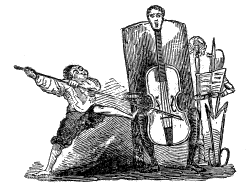
There are on record several instances of a fall of red liquid exactly resembling blood in appearance, which has often been accompanied by a descent of aerolites. On the 15th of November 1755, there was a heavy shower of this kind at Ulm, and several parts of Russia and Sweden. There was another, March 5, 1803, in Apulia, where it seemed to fall from a reddish black cloud. A descent of large quantities of dry dust preceded the latter, and has on several occasions occurred by itself.
Before this phenomenon was understood, you will easily suppose that it was looked upon as something dreadfully portentous, and the more « 281 » so from its occurring so unfrequently. It is now known to be closely related to the aerolites, as you shall hear.
Some of the liquid, looking just like congealed blood, which fell at Ulm, was examined. It was found to have a sour taste, owing, as it was thought, to the presence of sulphuric acid. When dried, the dust that remained, which constituted the colouring matter, was found to be subject to magnetic attraction, and in other respects to resemble the substance of the meteoric stones; so there can be no doubt that the dust is nothing more than what is caused by the fracture or the friction one against the other, of aerolites, and that the rain is made red by the dust falling on the clouds, from which it is precipitated.
RED SNOW.
Several travellers have witnessed the existence of snow of a bright red colour, in various parts of Baffin's Bay; and at Arezzo, in Italy, « 282 » in March 1813, there was a fall of it, which lasted many hours.
There seems some reason to suppose that in the latter instance the redness was caused by aerolite dust; but a microscopic examination of some of that at Baffin's Bay, has proved that its colour is owing to a still more wonderful cause. The colouring particles are actually small plants or fungi, which take root and grow, and bear seed upon the snow itself!
What do you think of this Lilliputian vegetation? One full-sized plant is no more than 1-1600th of an inch in diameter; and to cover a single square inch of its cold bed of snow, 2,500,000 are necessary! It has been named by its discoverer, Mr. Bauer, Uredo Nivalis.
SHOWERS OF FROGS AND FISH.
I dare say you have heard, before now, of its raining frogs and fish. I like that you should have correct notions on these things, so I shall « 283 » just tell you what seems to have given rise to these reports.
If you understood what I told you respecting the water-spout, you will see how likely it is that any small fish that may be on the spot, should be sucked upwards along with the water, even to the very top of the spout; now they might be kept up there as long as the whirlwind kept up a rotatory motion in the cloud, after it had ceased to sustain the column of water drawn up from the sea. When the whirlwind was exhausted, the little fish would naturally fall out of the cloud, perhaps after it had travelled far from where the water-spout occurred.
If the water-spout had passed over fresh-water lakes or rivers, frogs might be drawn up instead of fish, and let fall in the same manner.
But I will relate to you another circumstance, which may have been imputed to a descent of fish from the clouds. I told you in the first part of this book respecting the alluvions, or torrents of mud, which make their way after an « 284 » eruption down the sides of Mount Vesuvius. In some of the great volcanoes of South America, these alluvions have not to be formed in the regular way, but mud of the consistence of pap is ejected from the craters themselves in amazing quantities. This mud is supplied by subterranean waters connected with the volcanic channel, and it often contains myriads of little fishes of the kind called Pimelodes Cyclopum: they are generally about four inches long, and they exist in such vast numbers, that their putrifying has before now bred a pestilence in the neighbourhood of the Volcano. There are plenty of the same fish in the contiguous streams. What renders the circumstance so wonderful, is their being raised up to the level of 8 or 9000 feet, and then thrown out from the crater with very little injury.
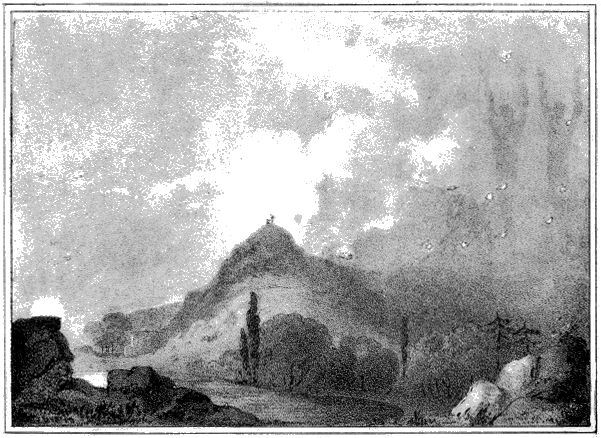
SPECTRE OF THE BROCKEN
I am going to tell you respecting some of the appearances produced by clouds which reflect like mirrors; and by those changes in the atmosphere which turn aside, in an irregular manner, the rays of light, which, as they pass from an object to the eye which is looking at it, excite the sensation called vision.
One of the most remarkable of these, has long been known by the name of "The Spectre of the Brocken." The Brocken is the loftiest summit of the Hartz Mountains, in Germany; it is said to be 3,300 feet above the level of the sea, and to command the prospect of a tract of land « 286 » which is inhabited by more than five millions of people.
It appears that clouds, from some cause or other, which perhaps we shall never perfectly know, are wont at times to collect on the neighbouring heights, and reflect a very distinct shadow of great size of whatever object may be on the summit of the Brocken, when the sun is rising and casts his beams horizontally. The best account of this wonderful spectacle, is given by the Abbe Hauy, who visited it in 1797, and I shall give you his own statement.
"After having been here for the thirtieth time," says Mons. Hauy, "I was at length so fortunate as to have the pleasure of seeing the Spectre. The sun rose about four o'clock, and the atmosphere being quite serene towards the east, his rays could pass without any obstruction over the Heinrichshohe.[A] In the south-west, however, towards Achtermanshohe,[B] a « 287 » brisk west wind carried before it thin transparent vapours, which were not yet condensed into thick heavy clouds. About a quarter past four I went towards the inn, and looked round to see whether the atmosphere would permit me to have a free prospect to the south-west; when I observed, at a very great distance towards Achtermanshohe, a human figure of a monstrous size. A violent gust of wind having almost carried away my hat, I clapped my hand to it by moving my arm towards my head, and the colossal figure did the same. The pleasure which I felt on this discovery can hardly be described, for I had already walked many a weary step in the hopes of seeing this shadowy image, without being able to gratify my curiosity. I immediately made another movement by bending my body, and the colossal figure before me repeated it. I was desirous of doing the same thing once more; but my colossus had vanished: I remained in the same position, waiting to see whether it would return, and in a few minutes « 288 » it again made its appearance on the Achtermanshohe. I paid my respects to it a second time, and it did the same to me. I then called the landlord of the Brocken; and having both taken the same position which I had taken alone, we looked towards the Achtermanshohe, but saw nothing. We had not, however, stood long, when two such colossal figures were formed over the above eminence, which repeated our compliments by bending their bodies as we did; after which they vanished. We retained our position, kept our eyes fixed on the same spot, and in a little time the two figures again stood before us, and were joined by a third," (most likely by the double reflection of one of the spectators.) "Every movement that we made by bending our bodies, these figures imitated; but with this difference, that the phenomenon was sometimes weak and faint, sometimes strong and well defined."
[B] Two others of the Hartz mountains.
There are some remarkable circumstances attending the Brocken, that are doubtless in some « 289 » degree connected with "The Spectre," which was once looked upon as a supernatural apparition. When Christianity was introduced into Germany, the priests and votaries of the old superstition, retired to the Brocken as a refuge, and there long kept up the dark and mysterious rites of the great Saxon idol, Cortho. It is a very wild place, full of clefts and caverns, and with rivulets and waterfalls on all sides of it, so that it would answer their purpose remarkably well. After the inhabitants had taken up the profession of Christianity, they used to celebrate on this mountain a festival on Midsummer night, in honour of St. Walpurgis, a female saint, who had first introduced Christianity among them. A legend then prevailed, that the summit of the mountain was occasionally haunted by a demon, which could have been no other than the Spectre. Everything about the mountain was looked upon with awe and veneration. A beautiful spring which runs down its side, is at this day called the Magic Spring; a pretty little lily that abounds on the « 290 » Mountain, is called the Wizard's Flower; and two great square granite rocks are called the Wizard's Chair. These names may be looked upon as monuments of the estimation in which the mountain was once held.
While you ought, my young friends, to feel happy and grateful in being taught what these natural things really are, and released from all superstitious fears or notions respecting them; you should be most careful not to forget what you owe to a purer faith, of which the character is to invite you to inquire into, and to know everything within your reach.
I shall say something to you respecting the cause of the Spectre, in a future chapter.
There has been something very like the Spectre of the Brocken, seen on Souter Fell, a mountain about half a mile high, in Cumberland.
One summer's evening, in the year 1743, as a farmer, named John Wren, and his servant were sitting at the door of his cottage, they saw a man with a dog furiously chasing some horses along a ledge on the side of the mountain which they knew was so narrow that a horse could hardly stand upon it. They seemed to go round one end of the mountain, and disappeared.
The next morning the farmer and his servant went round the track which the horses and man had seemed to take, fully expecting to find that « 292 » they had fallen over and been killed. You may guess how surprised they were to find no trace whatever of them, not even the mark of a hoof on the ground.
Well, they said nothing of what they had seen, and perhaps they almost forgot it by nearly the same season in the following year, when the servant, whose name was Daniel Strickett, saw one evening a whole troop of horsemen trot along the mountain-side, near the same spot. It seems that he had been laughed at by those to whom he had related the other apparition, so he was rather timid, and resolved to be well assured of the reality of this one before he mentioned it. He looked at the figures for a considerable time, and then called another person to witness the sight with him. Several others afterwards joined them, and continued looking at the aerial horsemen till it was quite dark. All these circumstances were attested before a magistrate in the year 1785: twenty-six persons are said to have been spectators of the sight.
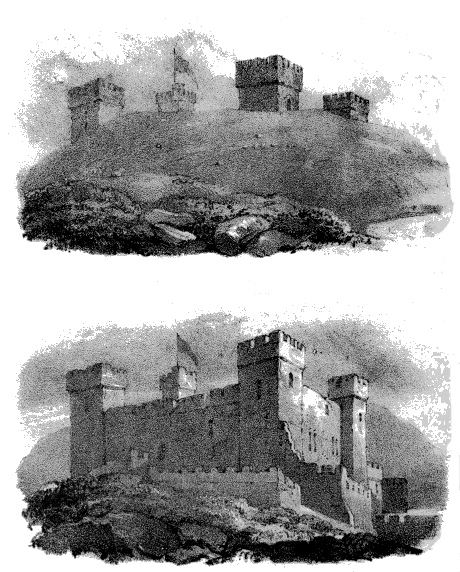
DOVER CASTLE
WHAT A FRIEND OF PARLEY'S SAW.
A gentleman with whom I am acquainted, who lives in the country, told me that he once left some labourers at the bottom of a very steep hill, whom he had ordered to do some earth work. As he was going down, intending to visit them again, about sun-set, he saw a part of the hill which he was descending, and one of the labourers wheeling a barrow upon the side of it, reflected on a cloud opposite with the greatest distinctness. Though it was quite impossible that he could see the men in their true position, he knew exactly what this man was about, and what work had been done, from the reflected image.
DOVER CASTLE.
Dover Castle stands upon the side of a hill, and when looked at from the side towards Ramsgate, its four turrets may be just seen peeping over « 294 » the top of the hill. You may see how it appears in the upper figure of plate XIX. On the 6th of August 1806, when Professor Vince, of Cambridge, was staying near Ramsgate, he was astonished to see the appearance of the castle as if it stood on the side of the hill next to him, as is represented in the lower figure of the plate. It continued so for nearly half an hour, during which he looked at it several times with a telescope, and the image appeared quite clear and distinct.
WHAT HUMBOLDT SAW IN SOUTH AMERICA.
When Humboldt was residing at Cumana, he frequently saw two small islands which lie off the coast, suspended in the air. He once saw some fishing boats seeming to float in the air for several minutes. In another place he and his companion saw the figures of cows in the air at a great height; and they were told by a person worthy of credit, that he had seen the forms of horses suspended in like manner, but with their legs upwards.
WHAT CAPTAIN SCORESBY SAW IN THE ARCTIC REGIONS.
Captain Scoresby relates several remarkable appearances of a similar kind, one of which I will describe to you. He saw one morning the inverted image of a ship in the air, which he at once recognized to be that in which his father was sailing. "It was," says he, "so well defined, that I could distinguish by a telescope every sail, the general rig of the ship, and its particular character; insomuch that I confidently pronounced it to be my father's ship, 'The Fame,' which it afterwards proved to be; though on comparing notes with my father, I found that our relative position at the time, gave a distance from one another of thirty miles, being about seventeen miles beyond the horizon, and some leagues beyond the limit of direct vision."
Many other such things have been related by « 296 » travellers, but with very little variation of circumstance.
APPARENT DISTANCE OF OBJECTS.
If you have never noticed the fact, you will be surprised to observe what a great difference appears to exist in the distance of the same objects under different states of the atmosphere. I do not mean when it is merely clearer than at another time, but when it is equally clear, the same object will show much higher above the horizon, and therefore seem to be nearer to some given spot, than at other times. We who have been at sea, have often seen this when we have been approaching land; but you will better understand an instance which occurred at Hastings, on the coast of Sussex. The gentleman who related it was surprised one day to see a crowd of people running down to the sea-side, and on inquiry he found they were going in consequence of a report that the coast of France had become visible to the naked eye.
He went down to the beach, and actually saw the coast of France so plainly as to be able to distinguish objects, and with a telescope he even clearly saw French fishing-boats at anchor, close to the shore. The illusion lasted for more than an hour, and occasionally grew faint and then brightened again. The distance is fifty miles, and Hastings would therefore be hidden from the opposite coast of France by the convexity of the earth; so that if a straight line were drawn from one to the other, it would pass through the sea.
There is a very remarkable spectacle to be occasionally seen between the coasts of Italy and Sicily, which the inhabitants call Fata Morgana, or Fairy Illusion.
The shores on each side are rich and beautiful in the extreme, and the narrow strait being very deep, looks always blue and fresh. According to the best accounts of the Fata Morgana, it appears only when the sun is elevated at an angle of 45°. It consists in a reflection of the objects on the shore more or less magnified, multiplied, distorted, and often decorated with the hues of the rainbow on the surface of the sea itself, and the portion of the atmosphere which is in immediate contact with it. The inhabitants of the neighbourhood look on it as a good omen, and whenever it appears, run down to the sea-side joyously crying out, Morgana! Morgana!
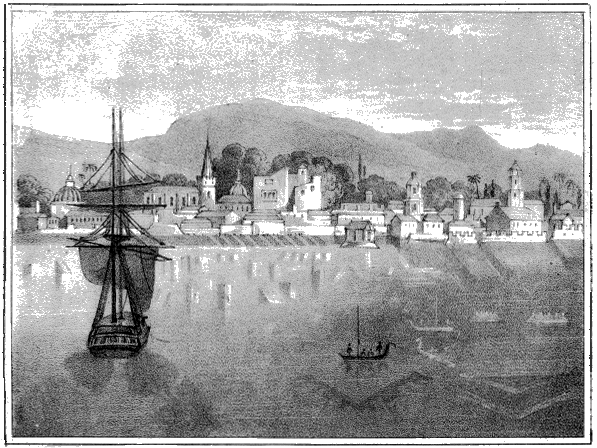
FATA MORGANA
Those who have seen it, declare that nothing can be more beautiful. The scene must look as wonderful as anything you have ever read about in a fairy tale. Castles, palaces, temples, of the utmost magnificence, houses, hills and valleys, woods, green pastures, all of the brightest colours, and indeed every one of the beautiful objects on shore, beautified tenfold. You will see in the plate the attempt of an intelligent traveller to convey a notion of this glorious phenomenon.
THE MIRAGE.
This name is given to similar illusions which are seen in various parts of the world, and more particularly to the illusive appearance of water, which is frequent in the sandy deserts of the « 300 » East. You shall hear what the celebrated traveller, Dr. Clarke, says of it.
"We procured asses for our party, and, setting out for Rosetta, began to re-cross the desert, which appeared like an ocean of sand, but flatter and firmer as to its surface, than before. The Arabs, uttering their harsh guttural language, ran chattering by the side of our asses; until some of them calling out 'Raschid!' we perceived its domes and turrets, apparently upon the opposite side of an immense lake or sea, that covered all the intervening space between us and the city. Not having in my own mind, at the time, any doubt as to the certainty of its being water, and seeing the tall minarets and buildings of Rosetta, with all its groves of dates and sycamores, as perfectly reflected by it as by a mirror, insomuch that even the minutest detail of the architecture, and of the trees, might have been thence delineated, I applied to the Arabs to be informed in what manner we were to pass the water. Our interpreter, « 301 » although a Greek, and therefore likely to have been informed of such a phenomenon, was as fully convinced as any of us that we were drawing near to the water's edge, and became indignant when the Arabs maintained, that within an hour we should reach Rosetta, by crossing the sands in the direct line we then pursued, and that there was no water. 'What,' said he, giving way to his impatience, 'do you suppose me an idiot, to be persuaded contrary to the evidence of my senses?' The Arabs, smiling, soon pacified him, and completely astonished the whole party, by desiring us to look back at the desert we had already passed, where we beheld a precisely similar appearance. It was, in fact, the Mirage, a prodigy to which every one of us were then strangers, although it afterwards became more familiar. Yet upon no future occasion did we ever behold this extraordinary illusion so marvellously displayed. The view of it enabled us to imagine the horrible despondency to which travellers must sometimes be exposed, « 302 » who, in traversing the interminable desert, destitute of water, and perishing with thirst, have sometimes this deceitful prospect before their eyes."
Another traveller adds a particular which is well worthy of notice.
"The most singular quality of this vapour is its power of reflection. When a near observer is a little elevated, as on horseback, he will see trees and other objects reflected as from the surface of a lake. The vapour, when seen at a distance of six or seven miles, appears to lie upon the earth like an opaque mass; and it certainly does not rise many feet above the ground, for I observed that, while the lower part of the town of Abusheher was hid from the view, some of the more elevated buildings, and the tops of a few date-trees, were distinctly visible."
If you wish to understand the manner in which it is most probable that these illusions are produced, you must closely attend to what I am going to tell you. I will make my explanation as simple as I can, but I shall be able to teach you nothing, unless you do your part by paying attention.
You know that vision is produced by rays of light passing from the object seen, to the eye of the spectator. These rays have a tendency to form straight lines, and they would be perfectly straight, if they had only to pass through empty space; but this cannot be the case near « 304 » the surface of the earth, as they there have to go through air, and frequently through other transparent substances.
When these rays meet with a substance which they cannot go through, and which is therefore called opaque, such as a man or a house, they are turned back or reflected, and strike the eye of the person who may be looking in that direction, so as to cause vision.
But when they meet with a body which they can pass through, called therefore transparent, such as water or glass, they are turned aside out of their original course or refracted; and this refraction takes place in different degrees, according to the density of the substance.
Thus, in looking at objects through air, you do not see anything exactly in its real position; but in looking at them through water, the variation between the reality and the appearance is still greater, because the density of water being greater than that of air, it will refract more. To prove this you need only put a stick « 305 » obliquely into water, and it will look as if it were broken or bent at the surface of the water.
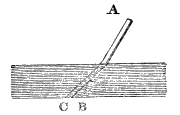
The true position of the stick is marked by A B, and the apparent position, by A C.
We see the rising sun some minutes before he has risen above our horizon, and the setting sun after he has sunk below it, because his rays are refracted by our atmosphere.
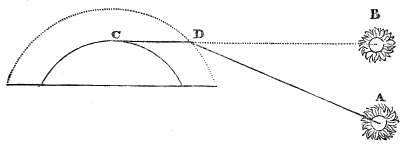
If the sun be at A, he will appear to a spectator on the surface of the earth at C, as if he were at B, because the rays will be refracted at D, which represents the limit of the atmosphere, towards C.
Perhaps you knew all this before. Well, the knowledge of these laws will very nearly enable you to understand the wonders of which I have told you. I will try to explain to you the manner in which it seems that the appearances are produced by the operation of the laws.
If a ray pass through a body that refracts it from its original course, it will go on when it has got through, in a line parallel with its first direction.
Thus, let A B be a thick piece of glass, and C D, a ray of light passing through it, which would be refracted from c to d; C c would be exactly parallel to d D, and the point C would be seen from D as if it were at E.
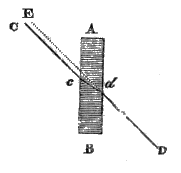
If you think a little upon this, you will see that nothing is necessary to account for objects appearing nearer to a given point at one time than another, or objects upon the earth appearing high up in the air, except different degrees of refraction. Thus in the instance of the coast of France seeming to approach Hastings, it is evident that the effect would be produced by an extraordinary degree of refraction in a stratum of air over the sea, through which the rays of light producing vision must come.

The explanation will be the same as that of the diagram of the rising sun in a former page; if the ray from A took the direction D, as under ordinary circumstances it would do, it is evident that a spectator at C would see « 308 » nothing. But instead of this, the ray was refracted near the middle to the point C, which represents the town of Hastings, and therefore the object A appeared as if it had been placed at B. You shall now hear what causes are likely to alter the refracting power of the air at times.
When air, water, or any other substance, is made hot, it becomes rarified, and its refracting power is thereby diminished. Have you ever watched, while you have been on one side of a stove, or of any heated body, the appearance of things on the other side through the air above it? If so, you must have seen how strangely they seem to tremble. Now this is caused by a stream of irregularly heated air rising from the stove, and enabling you every instant to see the things beyond it more nearly in their true position than you can through air of the ordinary temperature.
If you look through a magnifying glass at distant objects, they will appear upside down. You may learn why this takes place from books « 309 » on optics. The same effect is produced by rays passing through a medium which becomes gradually denser, instead of suddenly passing from one state to another. Thus, if you take a square glass bottle and put some clear syrup into it, and then carefully pour water on the top of that, anything, such as a written or printed line, seen through the space where the liquids are mixing, will appear inverted.
Again, if you take a tin tube full of water, stopped with a piece of plain glass at each end, warm the middle of the tube, and then look at one end, you will see an object at the other end, if held at a proper distance, magnified, and distant objects turned upside down, just as they would be by a convex lens. If, on the contrary, you cool the middle of the tube, by applying ice to it, the same ensues as by using a concave lens. If a space of cold air be between two spaces of hot air, or the contrary, a space of hot air be between two spaces of cold air, the effects would be the same, only they could not be produced « 310 » in so small a compass as they could with water. The space where the two different temperatures were gradually mixing, would influence the rays of light in the same manner as a lens on a very large scale.
Now portions of air are often made of different temperature by the sun's rays, by evaporation, as from the surface of the sea, or of lakes, or from marshy districts, and by winds operating under particular local circumstances. I do not want to lengthen out this dry story, but if you have read attentively what I have said, you will see that various positions of masses of air heated to different degrees, is all that is necessary to account for the instances which I have mentioned, in which objects have appeared inverted and out of their true positions; such as Dover Castle, Captain Scoresby's father's ship, the French coast opposite Hastings, and the islands, and horses with their legs upwards, described by Humboldt.
The apparitions of Souter Fell may be « 311 » accounted for in like manner. The latter one was seen at a time of civil commotion, when there were private troops of horse exercised in all parts of the country, and so the fact of armed horsemen being in the neighbourhood, is rendered very probable. We have only to suppose the image of such a troop to be brought to the side of Souter Fell, perhaps from the opposite side of the mountain, by a complicated refraction, like that which appeared to move Dover Castle out of its place.
But the Spectre of the Brocken, the Fata Morgana, and the image which my friend saw of the side of the hill on which he was, require another sort of explanation, because the object and the image are seen both at once; the latter could therefore have been no other than the reflection of the first.
It seems likely that some vapours are capable of receiving shadows. When I have been bathing in a river with a muddy bottom, I have often « 312 » seen my shadow on the cloud of muddy particles which I have disturbed from the bottom, in a manner something similar to that in which I should think this may occasionally take place.
There is, however, another theory of it. When rays pass from a thin medium into a denser medium, the whole do not go through, but they are strained, as it were, and a part are kept back and reflected. It is thus that you see a reflection on a transparent pane of glass.
If you breathe very lightly upon it, the reflection will be still more distinct, and the resemblance to the phenomenon we are describing probably greater. There are then two causes of reflection, the change of refracting power, and the presence of the watery particles.
Something of this kind perhaps occurs on the top of the Brocken. A rush of cold air may set up from deep ravines, with water and marshy land at the bottom, on the West side, while the rising sun is genially warming the air on the east side of the mountains. Mind, I do not say that « 313 » it is so, but it does not seem unlikely that two currents, one of cold air and the other of hot, thus ascend close to each other; and according to what I have told you, there would be a reflecting power in the plane of contact, which might be increased by the watery particles carried upwards.
A kind of aerial screen would thus be formed, which might catch the shadow of a person on the opposite summit, cast upon it by the horizontal rays of the morning sun. Thus you may account for the image, and its being so greatly magnified, requires no further explanation than I have given above; as it only needs the supposition of a mass of heated air, with two colder ones on each side, being between the persons and the reflecting substance.
The doubling of one of the figures was possibly occasioned by a reflecting surface having been formed on a different plane from the first, which might very easily occur.
OF SOME OTHER WONDERS, AND HOW WE OUGHT TO USE OUR KNOWLEDGE OF THE WONDERS OF NATURE.
I. I have now given you, my little friends an account of a few of the wonders of the wonderful world we live in, and I hope they have entertained you. I should like to have spoken to you of a great many other things, but it would make my book too large.
Some of you, I dare say, are fond of some branch or other of natural history, and perhaps you may be in the habit of collecting shells, plants, insects, or fossils. Well, I hope a great many of you do so, for it is a very delightful employment, when you are not learning your regular lessons. When I was a school-boy, I loved to dig fossils out of the earth, and many a sunny day have I spent with my hammer « 315 » and chisel under the cliffs by the sea-side, or in a stone-quarry. Many times I laboured long without success, but at last I scraped together a very pretty collection, and always managed to enjoy myself on these fossil-hunting days, whether I was successful or not.
But what I want particularly to say to you before we part is, that I hope none of you will rest satisfied with merely listening to what others tell you, with making an orderly collection of specimens, or recollecting merely the outsides of things. Though all these are very good when in their proper places, they are not enough. You should compare together different facts, and often turn them over in your minds, always keeping in view that there is something to be learned from them more interesting and more important than any knowledge, however correct, respecting the shapes of crystals, shells, or plants, or the habits of animals.
If you are diligent in thinking on what you know, you will see that nothing stands alone in nature; every single thing is connected with « 316 » other things, so as to make up one great whole. It is true that you will sometimes see what seems to be an exception to this; you will see instances of conflict and disorder, and, as it seems, things destroyed without a reason; but you will also very often find, as you come to know more, that what seemed at first an exception was not such in reality, and that it was what tends as much to the order and beauty of the whole, as any of the particular things you admired at first.
II. The ancients supposed that those parts of the world which were in the torrid zone, and those towards the North Pole, could not be inhabited by man; and we find from their writings, that it was something of a puzzle to know of what use they could be. They did not, however, know much about the extent of them, for even the shape of the earth was then unknown,—some contending that it was in the form of a cylinder, some that it was pear-shaped, and others that it was round and flat like a trencher. A very few made a shrewd guess at its true figure. No one was quite certain on the subject, « 317 » till navigators had sailed round it, so as to reach, by continually going forward, the same spot as they started from.
What men have learned within the last four centuries, has taught us that only a small portion of the surface of the earth is uninhabitable. Man, by the wonderful constitution of his nature, is enabled to bear the extremes of heat and cold better than any of the animals that are sent for his use, each of which is adapted for the particular climate in which it may be placed. Under the most extreme variations of the temperature of the atmosphere, the heat of our bodies, when we are in health, is never increased or diminished more than a very few degrees; so that a thermometer, with the bulb put into the mouth of an Esquimaux, in a climate much below freezing, will be only three or four degrees below what it will be in the mouth of an inhabitant of the East Indies, where the temperature often exceeds 100 degrees.
The dog is almost the only animal that is « 318 » prepared to accompany man in all climates. The form and habits of this faithful creature vary most surprisingly, according to the circumstances in which he is placed; but he is everywhere the loving friend and faithful associate of man, and ready to defend him and to share his toil, in the hot and parched deserts of the East, or the icy regions of the North.
There are a few animals that undergo remarkable changes, to enable them to bear the vicissitudes of the climate in which they may be placed. The hares and the foxes of the Northern regions become covered with white hair in winter. Now, it is proved, that a body hotter than the surrounding atmosphere which has a white covering, cools much more slowly than one covered with a dark colour: hence, the heat generated inwardly is preserved and economized by the winter coats of these animals, to the great benefit of their health and comfort.
III. Some kinds of birds that love warm climates, are taught to assemble together at a « 319 » certain season near the end of summer, almost to a day, and start off on a pilgrimage to distant lands, where nature is still blooming. There are these birds which all live nearly the same sort of life,—the swift, the swallow, and the house marten, which all bear a strong resemblance to each other. They all come to us from the south in spring, and take their departure before the next winter. The swifts form themselves into companies, and take their leave of us before the middle of August; the swallows do the same about the middle of October, and the martens at the end of the same month. Thus these happy creatures manage to live all their life long in summer and sunshine.
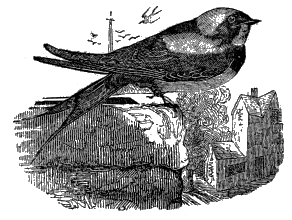
They are furnished with astonishing capabilities for performing these very long journeys. You are acquainted with their slender forms, so exactly adapted for cutting through the air, and their long, beautiful wings. Each of these wings is moved by a muscle of prodigious « 320 » power, situated on each side of the breast-bone. Possibly you may have noticed in larks and other birds, that are in the habit of flying long distances, which are eaten, what a large proportion of their flesh is in these two muscles; in the swallow, it greatly exceeds the weight of the flesh of all the other parts of the body. You will hardly believe it when I tell you, that the swift is able to fly at the rate of more than a hundred miles in an hour. The little bird that perched upon your chimney this morning, may perch to-morrow night upon one of the pyramids of Egypt, « 321 » and next week may be at the Cape of Good Hope. You think a great deal of travelling twenty miles an hour on a railway, but you see that is slow compared with the travelling of the swallows.
Instead of thus following the summer about over the surface of the earth, some creatures, that love warmth, make the best of it where they are. Some birds get into holes and other sheltered places, put their heads under their wings, and so sleep away the winter months. The pretty little black-eyed dormouse makes up a snug nest, and does the same, and so do some other of our common animals. During this inactive period, all the functions which are necessary to support life become fitted to a state of repose; the circulation gets slower, and the supply of inward heat sinks to the lowest temperature which life will bear.
I dare say you have often found some sorts of snail-shells with the snail inside, and the mouth sealed up firmly, and have taken them for dead: « 322 » this is not the case. The covering is only put over for the winter to keep out the cold, and the creature lives till spring without food or motion. How it must enjoy the first bright days of spring, when it opens its eyes after its long nap, reaching out its horns, and dragging its shell over the green grass.
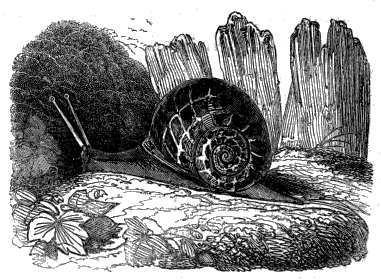
IV. Then, in the distribution of different animals, there is not less to engage our attention. The rein-deer is the support and comfort of the « 323 » Laplanders. It lives constantly on the scantiest, and apparently least nourishing diet, and when brought into warmer climates it soon languishes and dies. The camel only flourishes where there are large sandy deserts, with precarious supplies both of water and solid food; and to fit him for his peculiar line of usefulness, he has a receptacle to contain a stock of water, which he can at pleasure turn into his stomach, and can go eight or nine days without a fresh supply; he eats any kind of vegetables, however dry they may be; and a pound a day is sufficient to support him for weeks together; though he is very much larger than any of the animals which inhabit your country. It is usual for camels to go the whole distance from Cairo to Suez, in Egypt, without tasting a morsel, and this remarkable faculty has been supposed to arise from the hump upon their backs. When the animal is well fed, this hump, which is of a fatty substance, fills out and becomes solid; but when his food is scanty, it wastes away, and its « 324 » substance appears to go to the nourishment of the more vital parts of his frame. His large feet rest upon the sand without sinking in, and at the rate of about two miles an hour, he will travel thirty miles a day over a parched desert, bearing a burden of seven or eight hundred weight. He is called by the Arabs the Ship of the Desert.
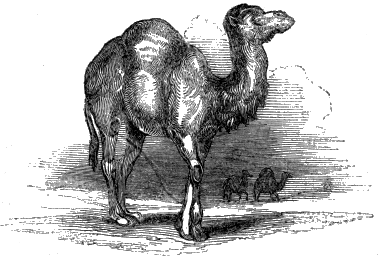
V. You may see that there is, in every variety of circumstance, something that enjoys itself, and has a place to fill up and a part to act amongst the creatures which God has made. But this is « 325 » not all: the existence of the cold of the Poles, and of the heat of the Tropics, is necessary to the well-being of the whole.
The free air that surrounds the globe, which we breathe, and through which we see, and hear, and smell, and move, is the same in composition in every part of the world. It contains just the same proportions of the two gases, oxygen and nitrogen, in the coldest and the hottest climates, in the deepest valleys and on the tallest mountains. Now, this air, considered on a large scale, is always blowing from the Poles towards the Equator. The more direct rays of the sun heat that portion of the earth's surface which lies in the Torrid Zone, and therefore the air above it is perpetually ascending to the upper regions of the atmosphere, to make room for that which presses upon it from the Poles, because it is cooler and heavier.
It is this process, united with the motion of the earth on its axis, which causes the Trade Winds and Monsoons.
Now, do you not see how necessary the cold Poles are to keep the rest of the world from becoming too hot, by supplying constant currents of fresh air setting in upon the hotter regions from both sides? Then the air, which ascends from the Equator, becomes cool, and travels down again to join the air from the Poles; and so a healthful circulation is kept up, which is necessary for all climates.
VI. It is very interesting to trace the dependance of the various tribes of vegetables and animals on each other, and to observe how one flourishes through the dissolution of another; and still more so to notice the gradual development of the same parts in the kinds, as they ascend one above another. You may see an instance of this in three of the animals that I described to you, which were different enough in other respects, but agreed in being without a bony skeleton, and in having long organs round their mouths to catch their food with.
In the Acalephæ, or sea-nettles, these organs « 327 » were merely filaments without sensation, of which the use seemed to be, to entangle little creatures in, which chance might bring in their way. The animals themselves would seem, at first sight, to be very ill able to destroy small crabs and other shell-fish. You would suppose that the struggles they would make with their hard pointed legs, would tear the tender bodies of the Acalephæ; but the deficiency is supplied by the caustic luminous fluid which paralyzes the victim, and disables it for violent struggles while it is detained by the filaments, before the Acalepha attempts to swallow it.
In the Actiniæ, you will find the loose disorderly filaments changed into feelers, with wonderfully acute sensation, regularly disposed in a star. When a substance touches the feelers they close in with considerable power, but seem to act more like a mechanical trap,—as the leaves of certain plants catch flies and other insects,—than in direct dependance on the will of the animal. However, the Actinia has the sense of feeling, and has a perception of light « 328 » and of odours, though without eyes or nose. Having greater muscular strength and more compactures of film, he does not need the destructive fluid with which the Acalepha is furnished. Thus, one sort of power is made to compensate for the loss of another.
The Sepia also catches his food by means of fleshy organs placed round his mouth; but in him you find them possessed of amazing power, moving in strict subjection to his will; never loosely floating about as in the others. Then he tastes, sees, and hears, by means of a tongue, eyes, and ears, distinctly formed.
A similar gradation is observed in the development of the various parts composing the hand and arm in animals with perfect skeletons, in which the bones act as levers. There is a very interesting book[C] written on this subject, which you would do well to read; and you will see in it that all sorts of birds, quadrupeds, and even fishes, have, in their fore feet, wings, and « 329 » fore fins, elements resembling those of the human hand and arm. Often, in comparing only two animals, you might fail to trace the slightest resemblance; but when one or two or more of other kinds are placed between them, you find a sort of ladder which, in an evident manner, unites the lowest with the highest tribes.
[C] Sir Charles Bell's Treatise on the Hand.
At distant periods of the earth's history, you may see the same sort of organs, and the same dependance of the creatures one on another. The fierce Icthyosaurus, and the sly, long-necked Plesiosaurus, had eyes, ears, tongues, and other parts, the same as our contemporaries; and they ate and digested their food, and moved from place to place, and preyed on each other in no other manner.
If our acquaintance with nature were much greater than it is, we should doubtless be able to bring proofs that there is no sort of stones, of vegetables, or of animals, nor any process or movement of the elements, in which we have not an interest. There is no fact that is not in some « 330 » way or other connected with the whole, so as to influence its well-being.
VII. Not only are the creatures which inhabit the earth united together by bonds of similarity of structure and appetite, of common wants and enjoyments, and of mutual support; but we are also united with the boundless system of worlds which the night unveils to our view. The principle of gravitation, and the beneficent rays of the sun operating on the planets and their moons, throw over us a plain and obvious tie of brotherhood with the stars that we may see night after night making their way amongst the constellations, as they move in their orbits, distinguished by their steady light from the twinkling multitude of fixed stars. The law that unites us to them is the same as causes a drop of rain to descend, or a weary fly to settle on the earth.
It is not improbable, that the aerolites (if the theory which I hinted at in a former chapter be true) may be fragments of original matter, « 331 » which have never been appropriated by any globe, and now sometimes pitch on one planet, and sometimes on another. If this be the case, we should be warranted in concluding that the matter of our solar system is everywhere the same, chemically considered, and is, therefore, governed by the same chemical laws; for the aerolites contain no substance which is not to be found far below the surface of the earth.
Some ignorant persons, in all ages of the world, have fancied that the relative positions of the stars to each other, at the moment of the birth of an individual, must have an influence upon his character and the future circumstances of his life. Thus arose what was called the science of astrology, and the practice of casting nativities; and in vulgar conversation it is not unfrequent for people, who do not know the origin of the expression, to "thank their stars," or to talk of their "unlucky stars," which arose from the prevalence of such a belief. This, I need hardly tell you, is all nonsense, from « 332 » beginning to end; but you may now know that there is, in reality, quite as wonderful a connection, and as direct a one, between yourselves and the stars, as this which was fancied to exist.
VIII. But who can tell how wide the relationship of our earth and everything upon it is extended, through the agency of those wonderful principles Light, Heat, and Electricity? It may seem to you impossible, when I tell you that there is not a blade of grass or a flower on this earth, which may not, in its little degree, affect the climate of a star far beyond the limits of our solar system; but if you will consider the way in which the falling of dews is regulated, you will see that there are grounds for such a notion.
I must first tell you that it is a property of Heat, like Light, to radiate or expand itself in all directions, without limit; so that a heated body is always sending out its heat.
Now, this radiation is influenced by the surfaces of bodies: Heat will radiate more from « 333 » a black rough surface than from a smooth white one, and a black body will therefore much sooner get cool than a white one, as I had occasion to tell you just now. The heat radiates rapidly from the leaves of vegetables, though from different kinds of plants in very different degrees, while from stones and dry wood it radiates very slowly.
Heat is also reflected, or turned back, by meeting with certain objects; and in this respect, too, it resembles light. You have possibly seen experiments showing this, made with polished metal mirrors.
At night time, when the sun's rays are not present, as the heat radiates quickly from the plants on the ground, each plant becomes thereby cooler than the earth and stones which surround it. This causes the watery particles which the air contains, to condense on its leaves and flowers, in the same manner as you see the moisture in the air of a crowded room, settle on the outside of a glass of cold « 334 » water; and, what is most wonderful, the surface of each plant is so constructed as to allow the escape of just so much heat, and to receive just so much dew in return, as its peculiar nature requires. You may see, if you look, that some plants always have more dew on them than others.
On a cloudy night, when dews are not so much required, a great part of the heat thus radiated is sent back, being reflected by the clouds. Hence the dew falls less heavily at such a time than on a clear starlight night, when every blade of grass and every little flower sends out its ray of heat to an indefinite extent, and may possibly meet another ray from the Dog-stars or one of the Pleiades!
This is very wonderful; but if you think, you will perceive that it is not more wonderful than that a ray of light should travel so far. Every particle of the surface of these stars does its part in emitting light, and by that the light of our nights is increased; and if Light is affected « 335 » by such remote influences, why should not Climate be so affected?
IX. As everything has a place to fill up amongst the creatures by which it becomes connected with the universal system, we find innumerable instances of things being most wonderfully provided with powers of retaining the position for which they were created, when circumstances may oppose it. The tendency which every animal has to preserve its own life, supplies abundant illustration. It is this which causes the Arctic animals to change their colour to white in winter, and the swallows to migrate to warmer regions. But there is something selfish in this, as the provision is merely to save the animal's own life. Much more beautiful is it to observe the operation of the affections of parent animals towards their offspring, by which the young, when they are incapable of taking care of themselves, are kept alive and preserved from injury often at the sacrifice of the enjoyment, and even of the life of their parent. You « 336 » will remember what I told you respecting the love of the old whales towards the suckers. Nothing parts with its own life willingly, but in a great many animals it may be seen that there is a greater regard to the preservation of their race than of their own individual lives.

X. These tendencies may be seen in vegetables as well as in animals. The young buds of various plants, of the common poppy for example, hang down their heads, so that the bottom of the calyx, as it is called by botanists, is placed upwards, and forms a sort of thatch or roof. When the flower spreads out its bright broad leaves, although its weight is increased, yet it then boldly lifts up its head to the sun, and the neck of the stalk which seemed unable to bear up the bud, is well able to sustain the full « 337 » flower. Now if it were otherwise, and if the bud held the same position as the flower, the rain would run into the calyx and would lie there, so as to cause the petals or leaves of the future flower to become rotten.
In this Kingdom of Nature, the unwillingness to part with life is even more wonderfully exhibited than in animals.
Seeds have been known to retain their principle of life for centuries, and long after they have seemed perfectly dead and dry, when placed in proper circumstances, they have sent out shoots and borne flowers and fruit. Mr. White relates, that when some old beech trees were removed from a spot in the neighbourhood of Selborne, where they must have stood for ages, some strawberry plants sprung up, of which the seeds must have lain dormant under the roots of the beeches. When the Spaniards took possession of Peru, many of the race of Incas, the rulers of that country, fled to the deserts and took with them what provisions they « 338 » could carry. There are now, sometimes, found in these deserts, ancient vessels with very narrow mouths, containing at the bottom a few grains of maize or Indian corn, the remains of the stock of those poor exiles. I have got one of the vessels; and the maize which came out of it was sown, and took root and bore seed, though it must have been bottled up for considerably more than three centuries.
But now I am going to tell you something still more surprising than this. The Ancient Egyptians, from some notion connected with their religion, used at times to place in the hands and under the soles of the feet of the bodies they embalmed, the roots of a kind of lily. The roots are of a bulbous sort, not much unlike an onion, and they have often been found on those mummies which have been uncovered. One or two of them have been set to vegetate, and have actually borne flowers and seed, after having slumbered in a mummy coffin for considerably more than 2000 years!
XI. You know that some seeds have wings or sails, by means of which they are transported by the winds over land and sea for very many miles. The thistle-down everybody is acquainted with. There is an eastern annual plant whose seeds are provided with wings, which, in a most curious manner, it only uses when it needs them, as you shall hear. It grows in the little pools that occur here and there in the deserts of Arabia, which, as you may suppose, in a hot climate and a sandy soil, are very apt to dry up at some seasons of the year. The seeds grow on the stalk enclosed in a roll of flaxen fibres, and when they are ripe they fall off, and if the water continues till the next year, they spring up close by where their parent plant lived. But should the pool dry up, the flaxen fibres become dry and spread out into wings, the wind takes hold of them, and away flies the seed till it reaches a more favoured spot. When it is lucky enough to get to the water, the pod speedily bursts open, and the seeds take root at the « 340 » bottom. You see how, by a simple mechanical contrivance, this plant is enabled to do the same for the preservation of its species, as I told you the Actinia did by a very simple exercise of instinct, for the preservation of itself.
XII. Because you wonder at the works of creation, you feel a desire to search into them. You will find out many things, and you may learn to explain a great many things, the reasons of which you are ignorant of at present. Still, your wonder will not be satisfied; on the contrary, the further you go, the more it will be excited. You will have to go wondering on, but if you proceed in the right disposition, every addition to your knowledge will increase your admiration and love; for everything was made by the loving and wise God, and therefore the whole must necessarily be beautiful and harmonious, and there is nothing which has not its place to fill, and its part to act. May you, my little friends, ever keep in mind that you are not left out of this Divine Plan; and that there is « 341 » a place to be filled, and duties to be performed, by each one of you, which are not left to a mechanical contrivance nor to animal instinct; but must be found out and fulfilled by a never dying Spirit, which must be conscious of what it is about, and is responsible to God for every action.
J. GREEN AND CO., PRINTERS, BARTLETT'S BUILDINGS.
WORKS RECENTLY PUBLISHED BY
DARTON AND CLARK,
HOLBORN HILL.
BIRDS AND FLOWERS;
AND OTHER COUNTRY THINGS.
BY MARY HOWITT.
BEAUTIFULLY ILLUSTRATED IN A NEW STYLE.
Handsomely Bound in Saxony, Gilt Edges. Royal 18mo. Price 6s.
"This is a charming addition to the gift books of the season. The topics Mrs. Howitt has chosen are "Birds and Flowers, and other Country Things;" and these are varied with skill, and executed with much taste, delicacy, and a pastoral-poetical feeling."—Spectator.
"We shall speak of this work with unreserved commendation.—The wood-cuts are exquisite."—Athenæum.
In the Press.
HYMNS AND FIRESIDE VERSES:
BY MARY HOWITT.
BEAUTIFULLY ILLUSTRATED,
AS A COMPANION TO BIRDS AND FLOWERS.
TALES IN VERSE:
BY MARY HOWITT.
WITH BEAUTIFUL ILLUSTRATIONS.
Price 5s. in Elegant Binding; or in Fancy Wrapper, 3s. 6d.
TALES IN PROSE:
BY MARY HOWITT.
"Sweet Mary Howitt! Her name brings a magic with it, let us see it when and where we will; it is one crowded with pleasant associations, telling of wisdom learned by the wayside and under the hedge-rows breathing perfume,—not the perfume of balls and routs, but of violets and wild-flowers,—leading the mind to pure and pleasant thoughtfulness."—New Monthly Magazine.
THE LITTLE CONCHOLOGIST;
A GUIDE TO THE CLASSIFICATION OF SHELLS:
WITH A COPIOUS INDEX OF THEIR VULGAR NAMES:
BY THE REV. T. WILSON.
SECOND EDITION.
Square 36mo. Gilt Edges, Coloured Frontispiece, and Copper-Plates. Price 1s.
"A nice sea-side book, in a pretty exterior."—Tait's Magazine.
"Ably drawn up, and beautifully printed."—Family Magazine.
"A little gem."—Monthly Review.

Just Published,
THE LITTLE MINERALOGIST;
OR, FIRST BOOK OF MINERALOGY.
BY THE REV. T. WILSON.
With Coloured Plates, a Companion to the above. Price 1s.

In the Press. By the same Author.
THE LITTLE GEOLOGIST;
OR, FIRST BOOK OF GEOLOGY

With Numerous Illustrative Plates, and Gilt Edges,
Royal 36mo. Fancy Cloth Boards.
Price 1s. 6d.
THE LITTLE BOOK OF BOTANY;
OR,
FAMILIAR EXPOSITION OF BOTANICAL SCIENCE;
SIMPLIFIED AND WRITTEN EXPRESSLY FOR
Young Botanists.
BY DANIEL COOPER, A.L.S.
CURATOR TO THE BOTANICAL SOCIETY OF LONG AND AUTHOR OF "BOTANICAL RAMBLES WITHIN THIRTY MILES OF LONDON."
A New Illustration of the Geography of Holy Scripture, upon an
original plan, expressly adapted for SCHOOLS and
FAMILY INSTRUCTION.
Just Published,
PALESTINE, AND PART OF EGYPT,
WITH THE COUNTRIES ADJACENT;
Showing the Route of the Israelites through the Wilderness, and the Division of Canaan among the Tribes; and the Holy Land in the Time of our Saviour; all the Countries visited by the Apostles, and the great Empires of the East; being a complete Geographical Illustration of the Sacred Scriptures.
BY WILLIAM MARTIN,
EDITOR OF THE "EDUCATIONAL MAGAZINE."
Size, 39 by 26 inches, price 10s. 6d.—in a case, 14s.
Canvas and Roller, Varnished, 21s.
![]() The physical peculiarities of the countries represented, and
the sites of particular events, with references to the passages of Scripture
in which they are recorded, are laid down in this Map with
peculiar accuracy and clearness.
The physical peculiarities of the countries represented, and
the sites of particular events, with references to the passages of Scripture
in which they are recorded, are laid down in this Map with
peculiar accuracy and clearness.
DARTON AND CLARK, HOLBORN HILL.
Transcriber Note
Some of the quoted passages have unusual spelling for some words. These were left as is; but other minor typos have been corrected.
The Table of Contents and page 69 list name "Skapta-Jokul" and "Skaptar Jokul" respectively. A web search shows that the more common spelling was "Skapta Jokul" and both were changed to that. Some page references in the Table of Contents were corrected. A reference to "Plate XVI, fig. 4" on page 246 has been corrected to "Plate XV, fig. 4". Illustrations were moved so as to prevent splitting paragraphs. All materials were obtained from The Internet Archive and any files produced are placed in the Public Domain.